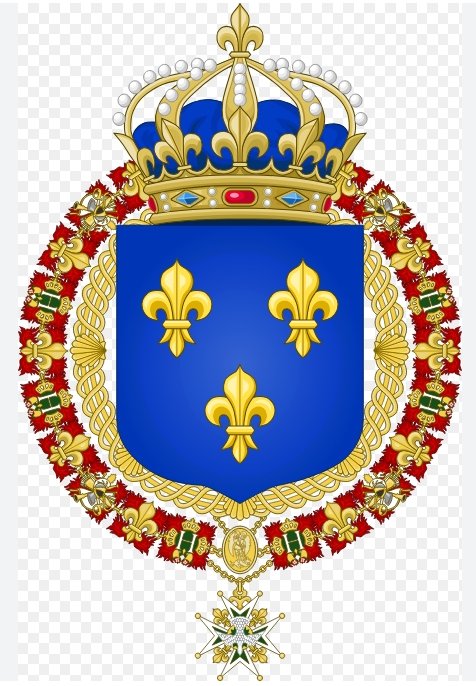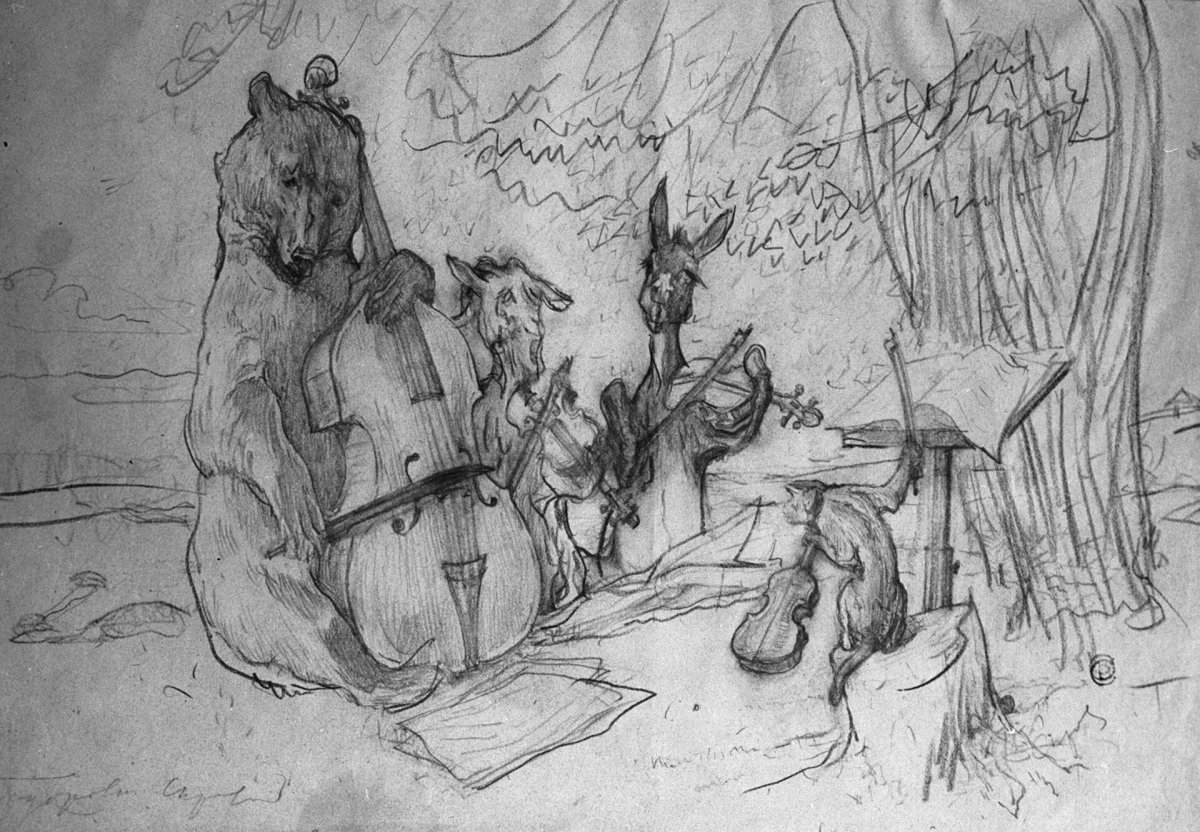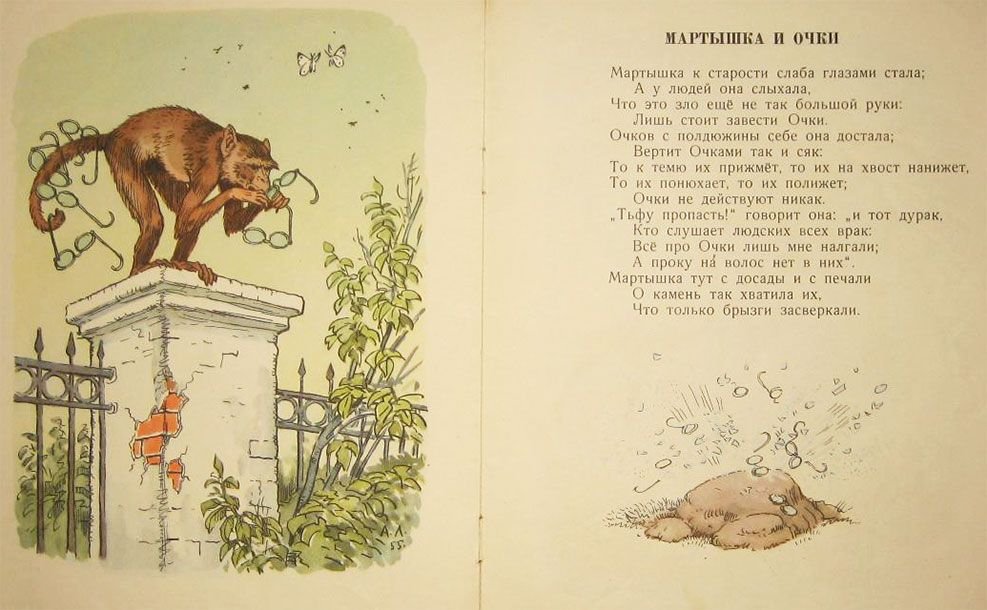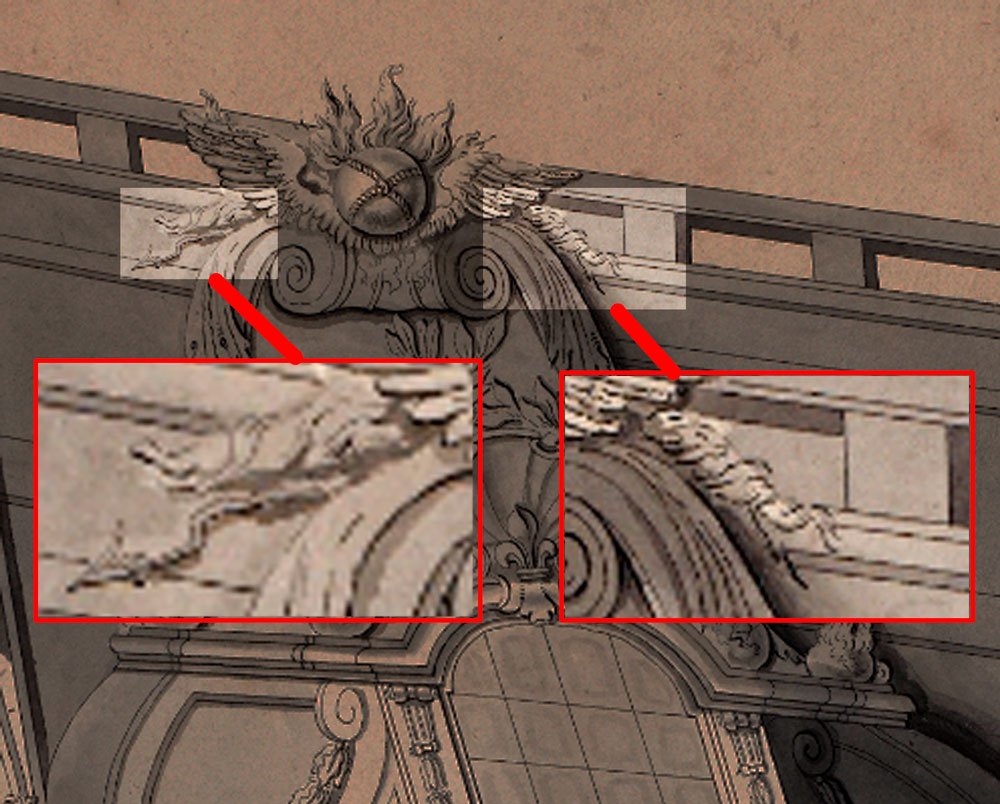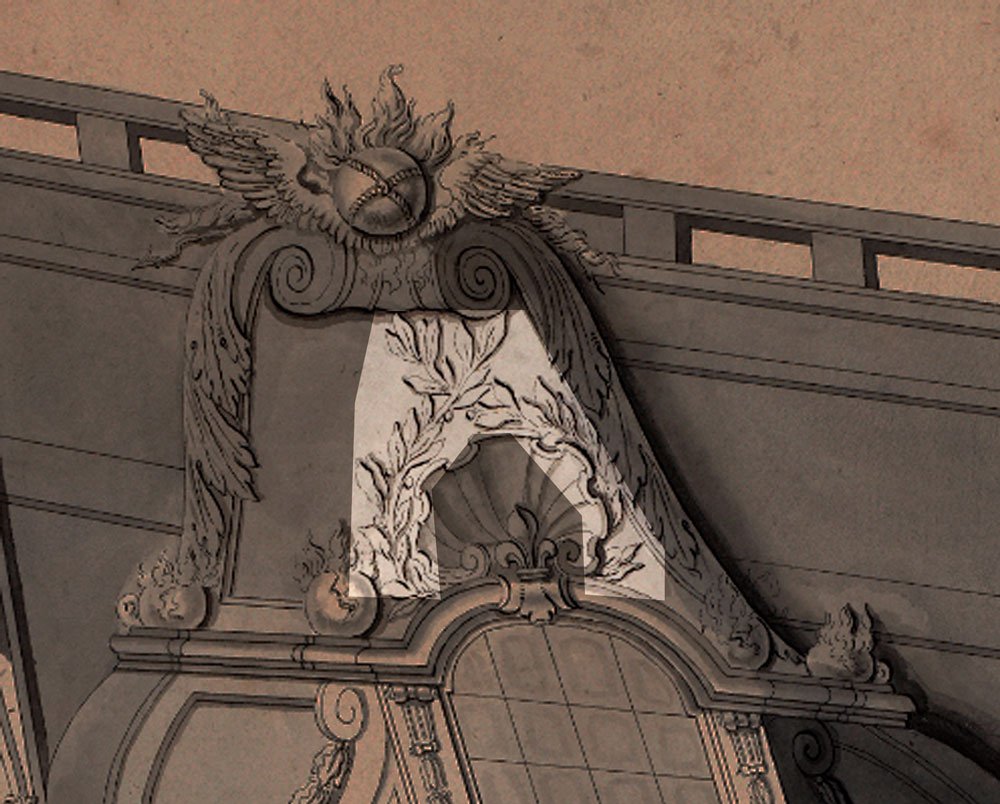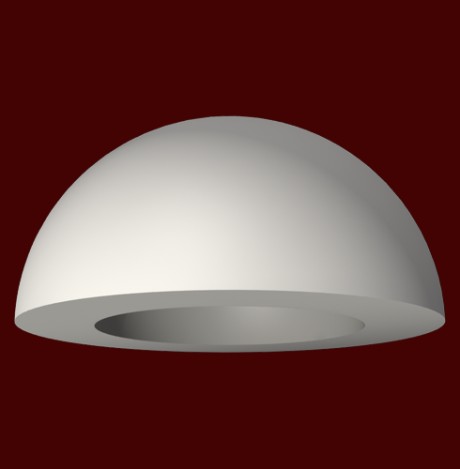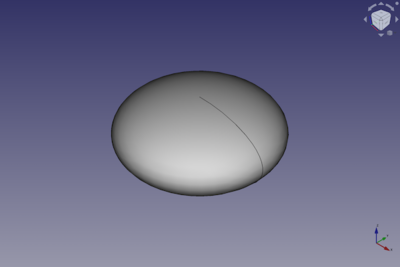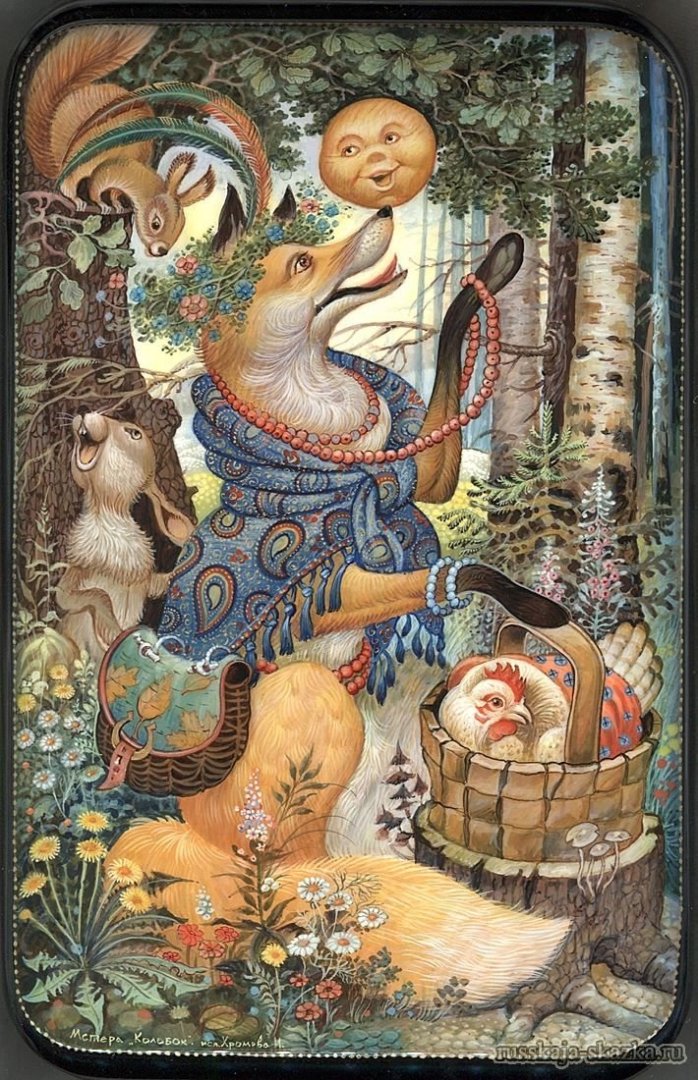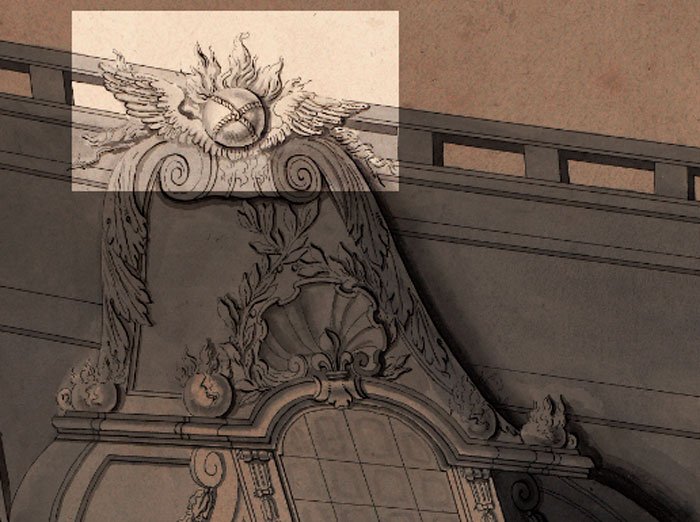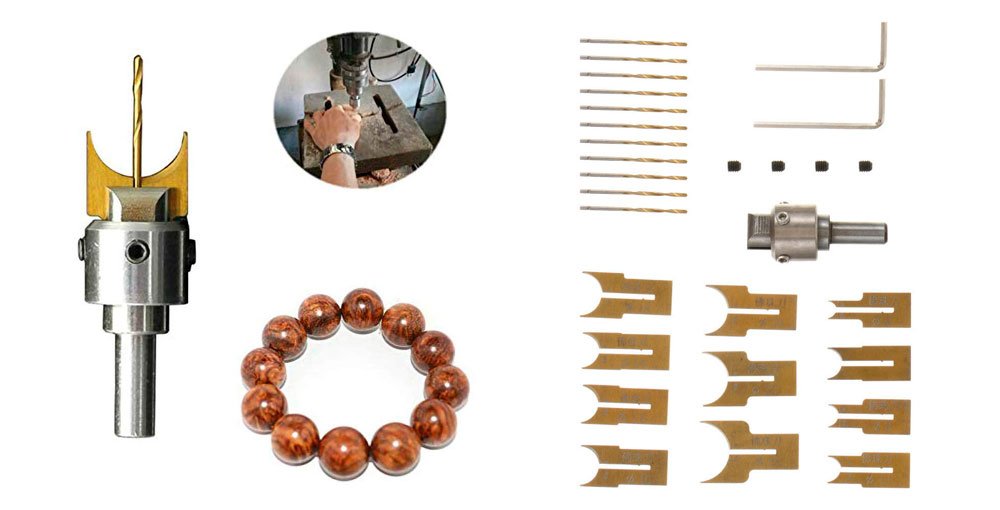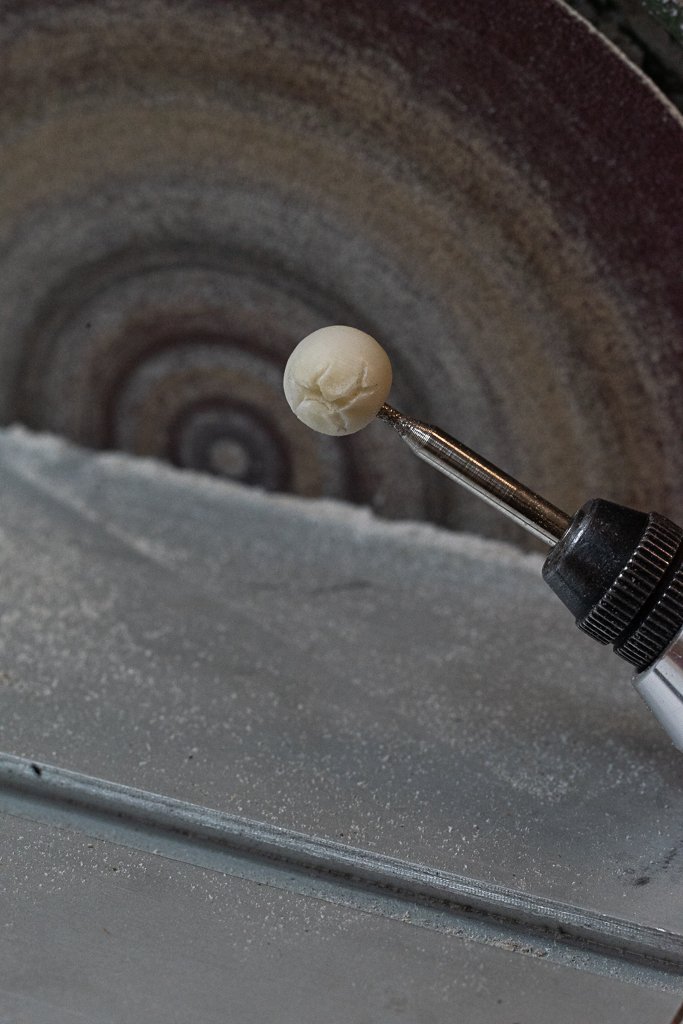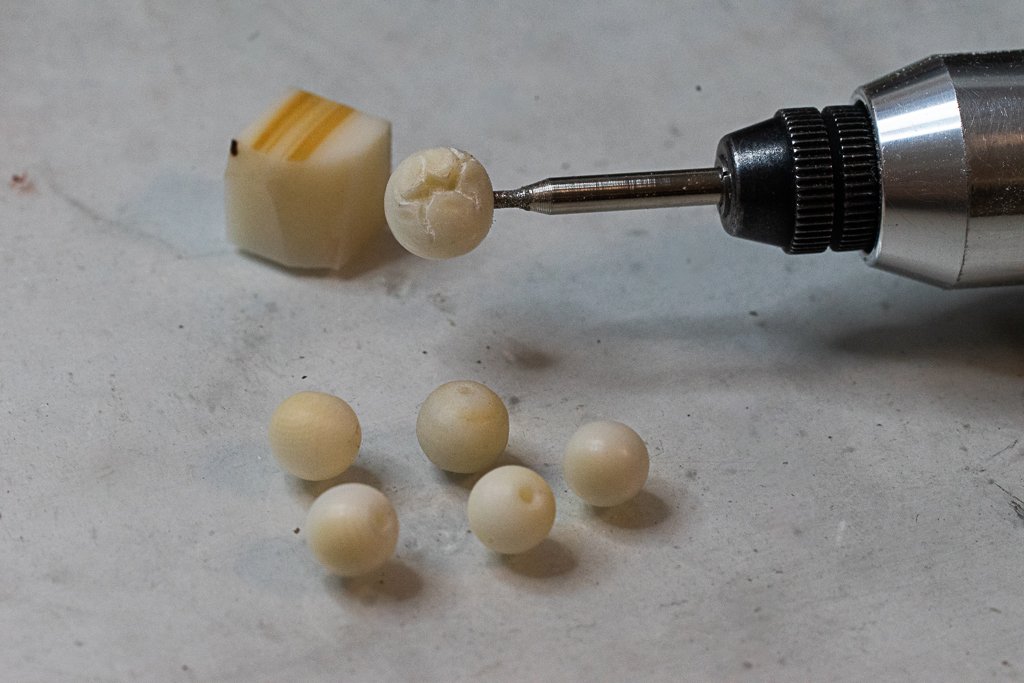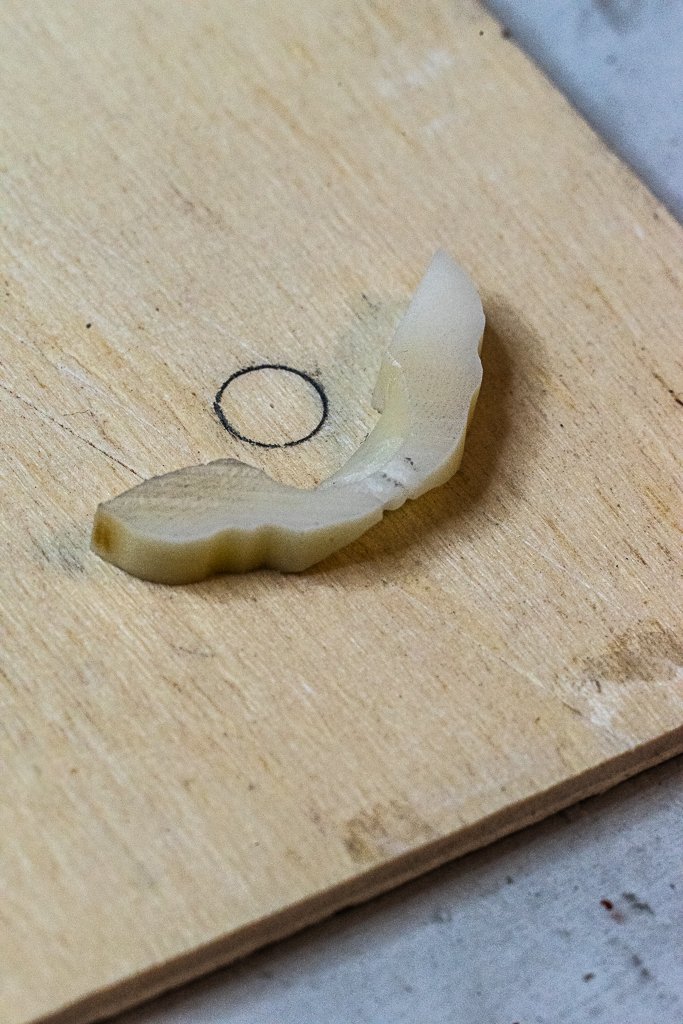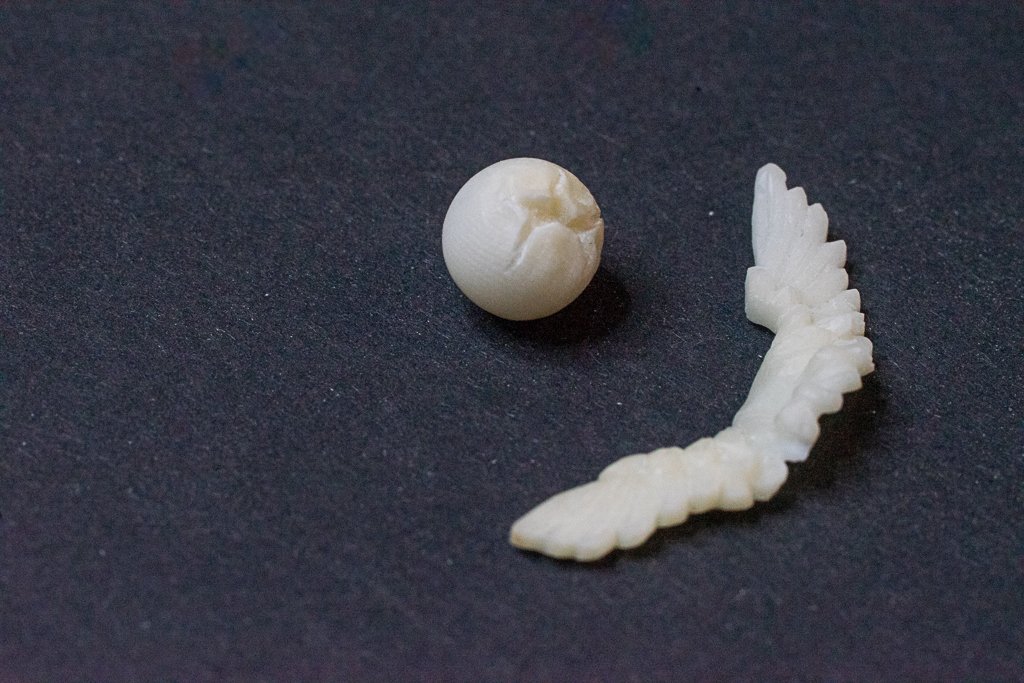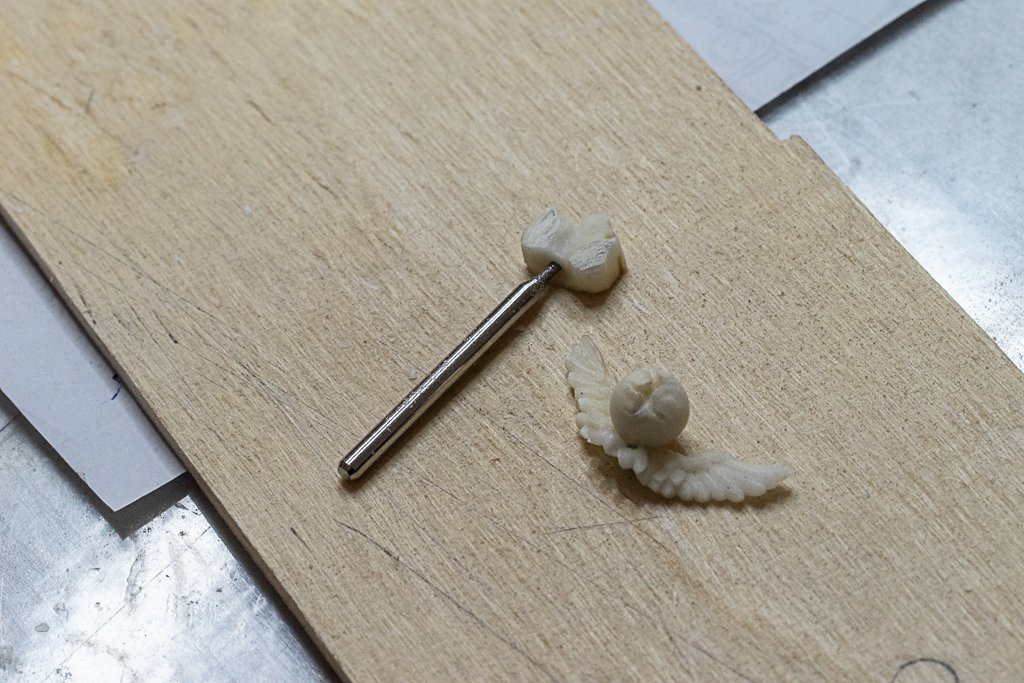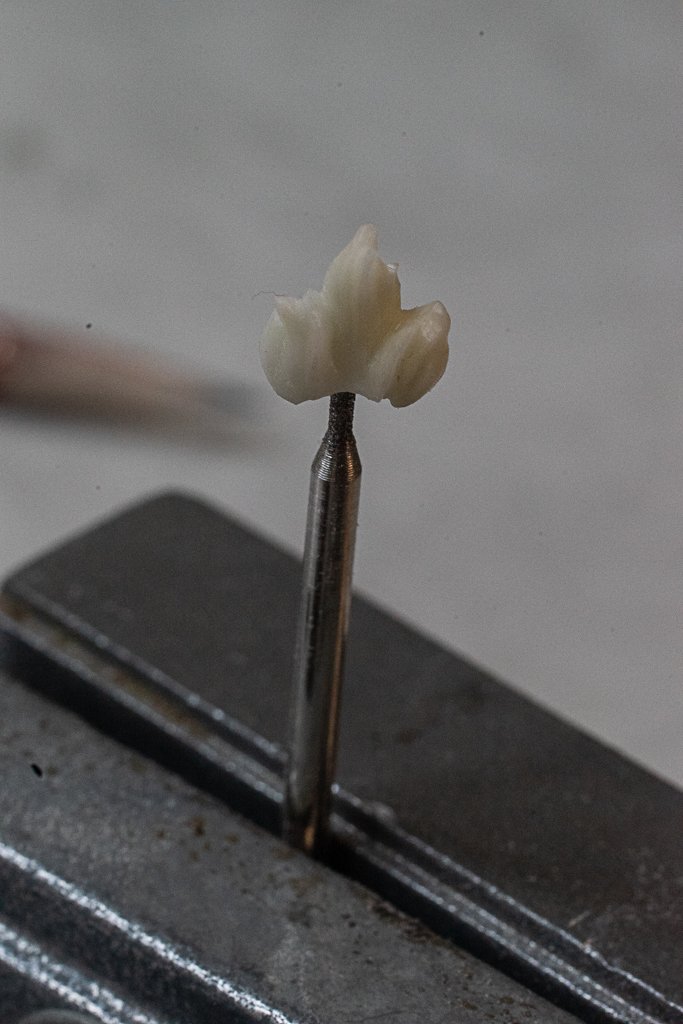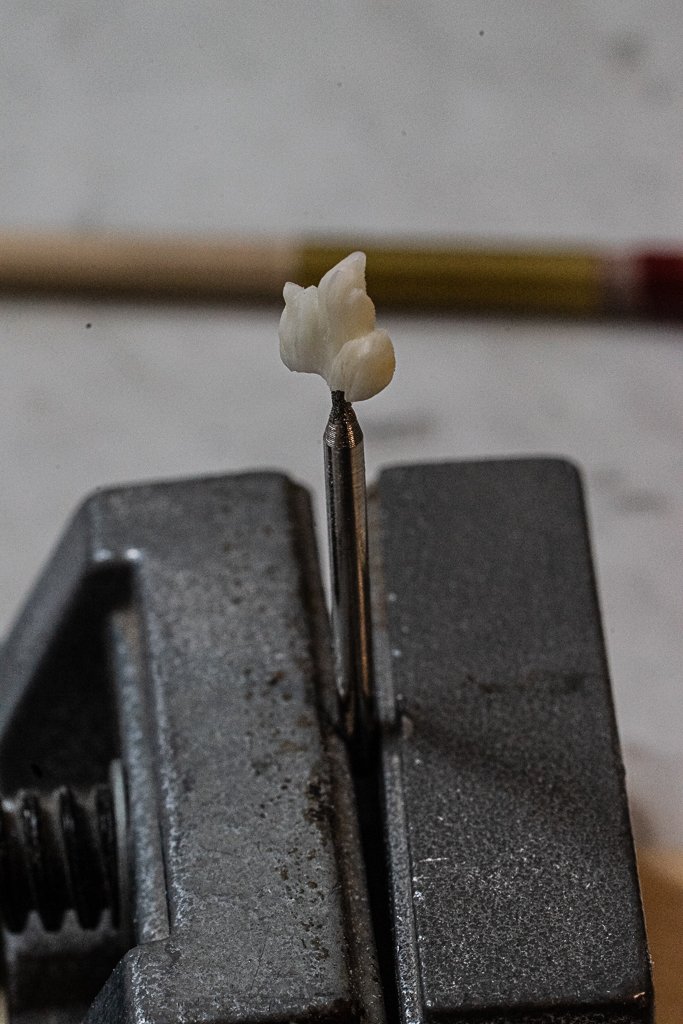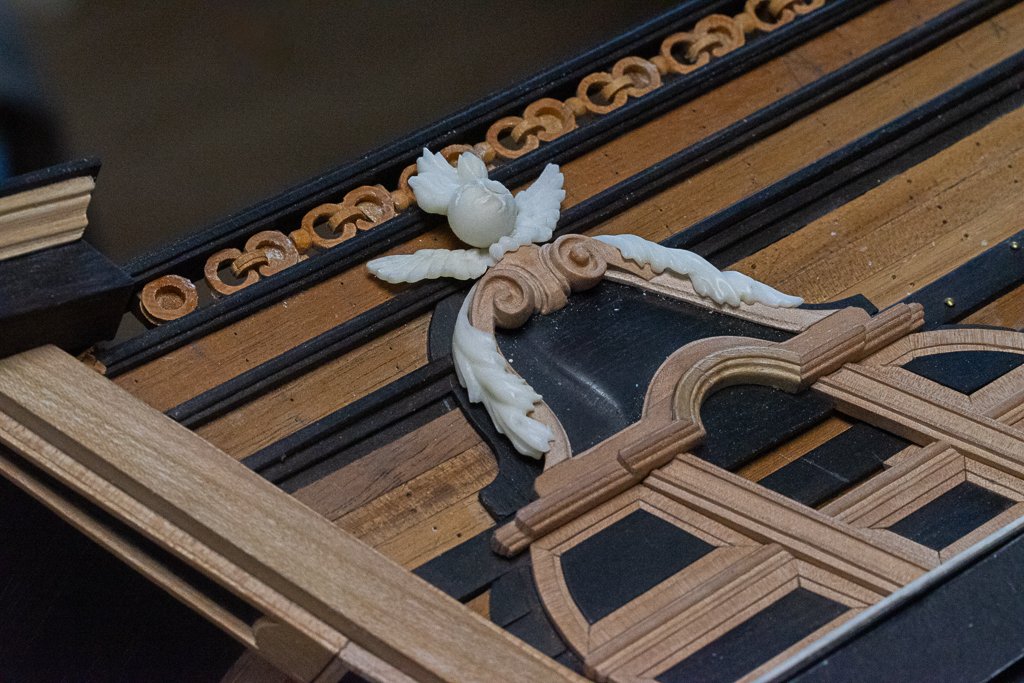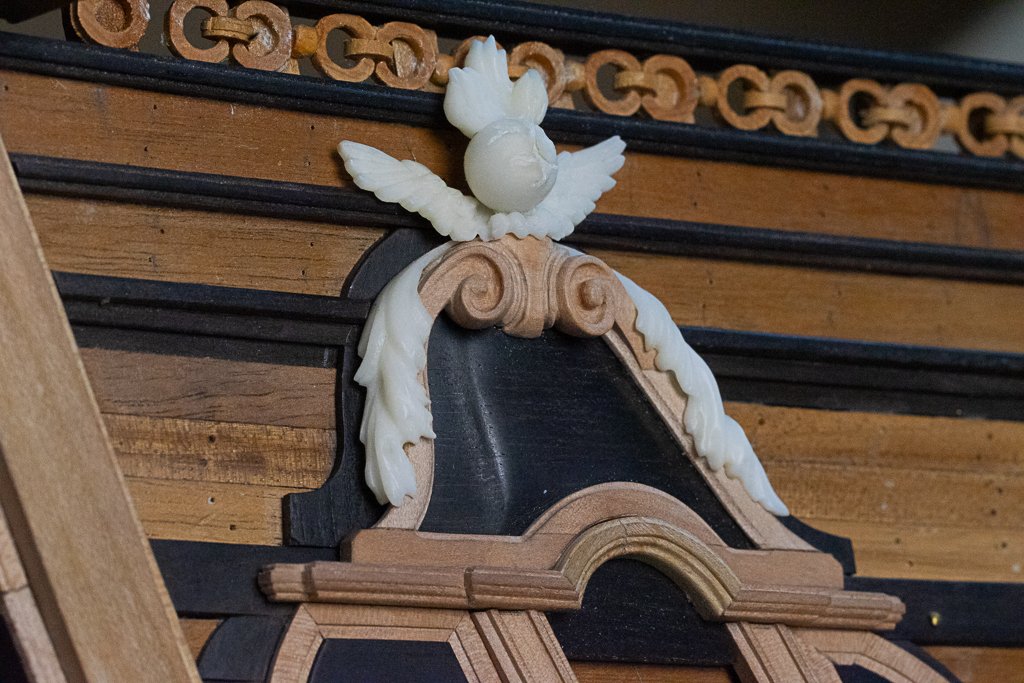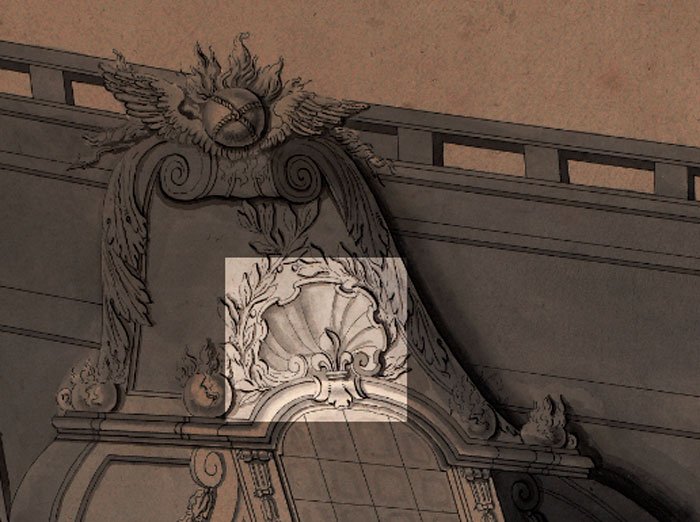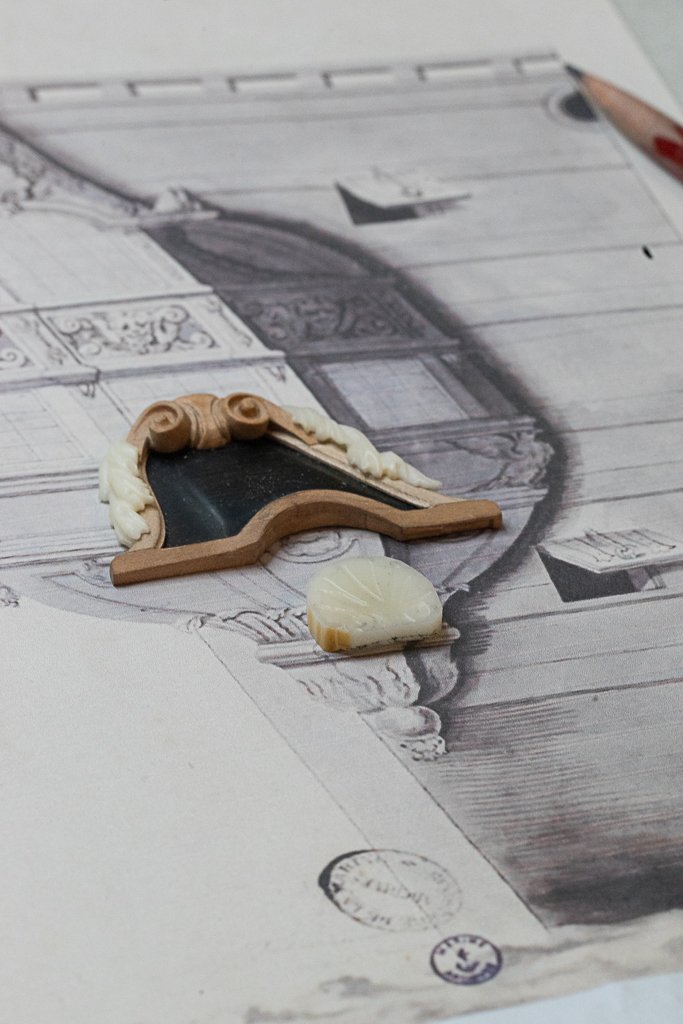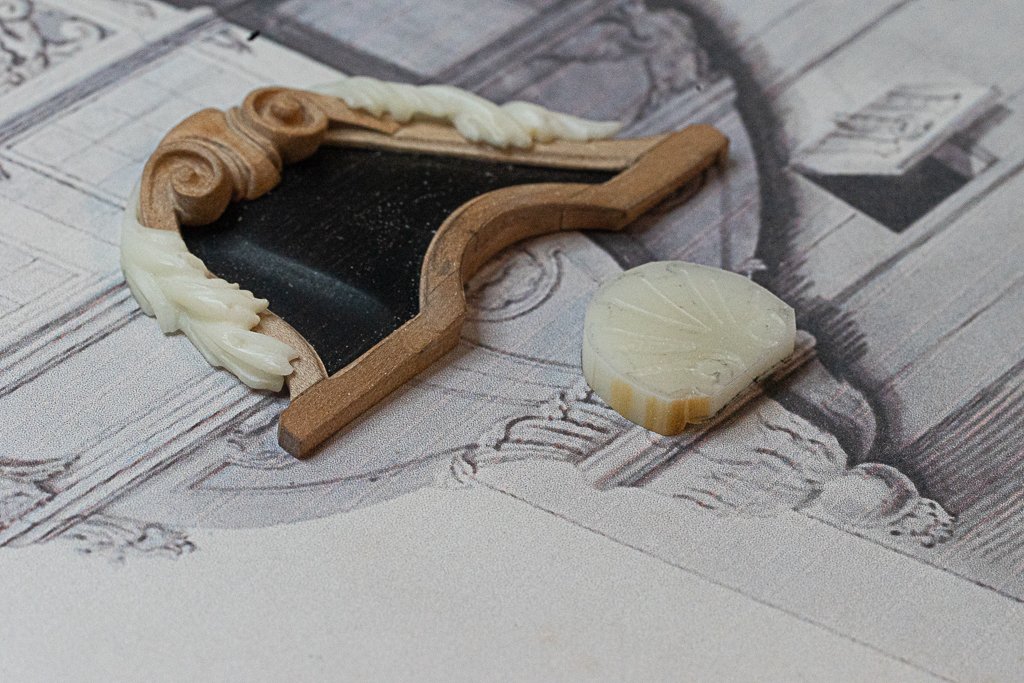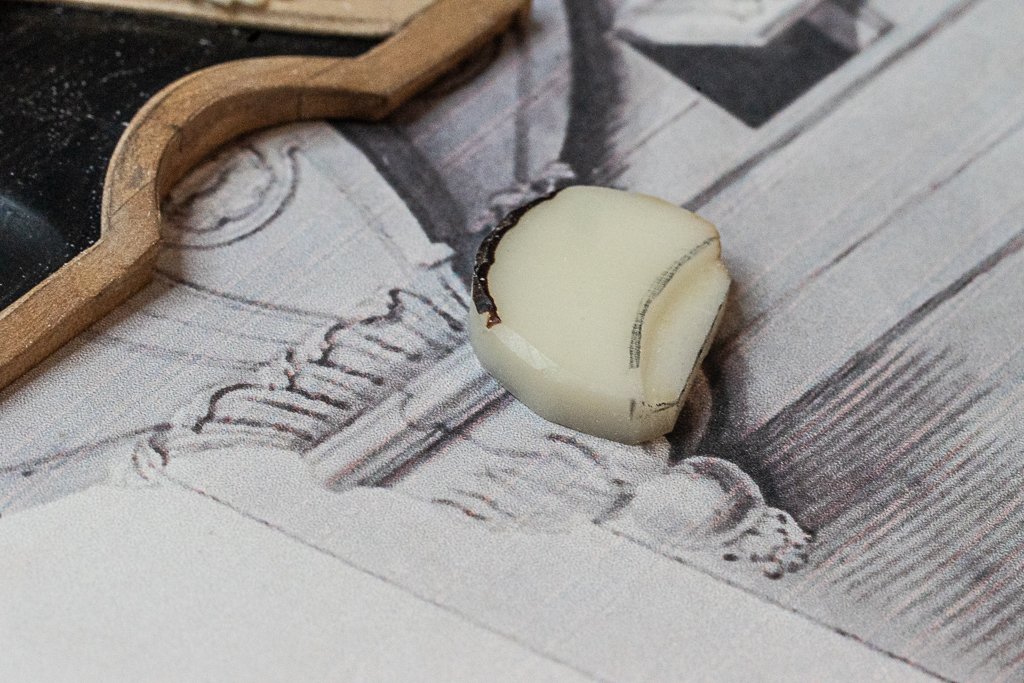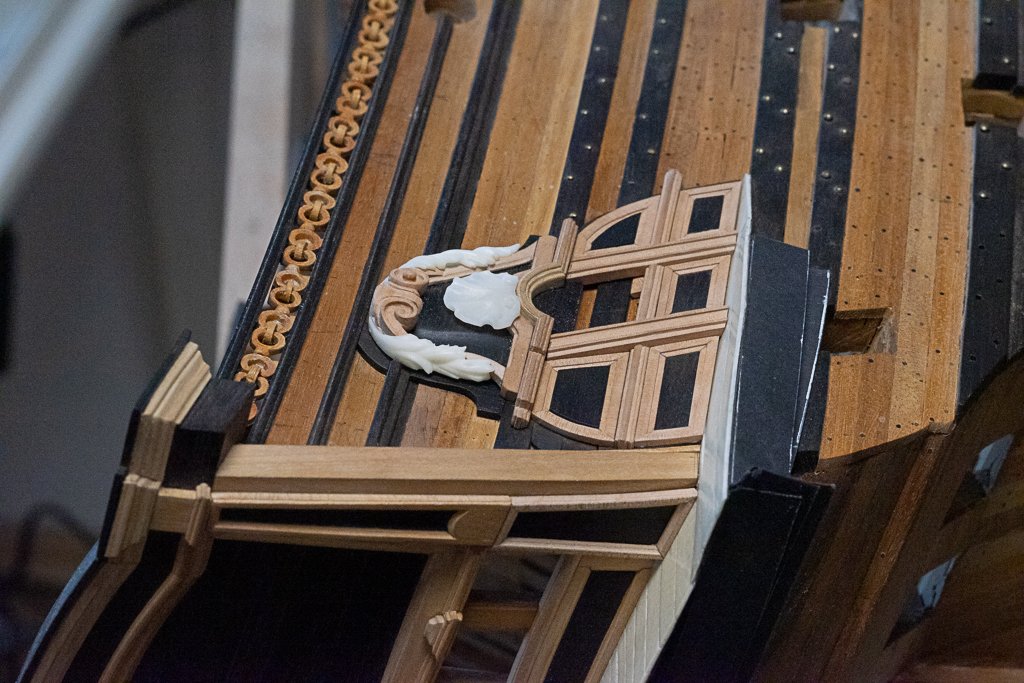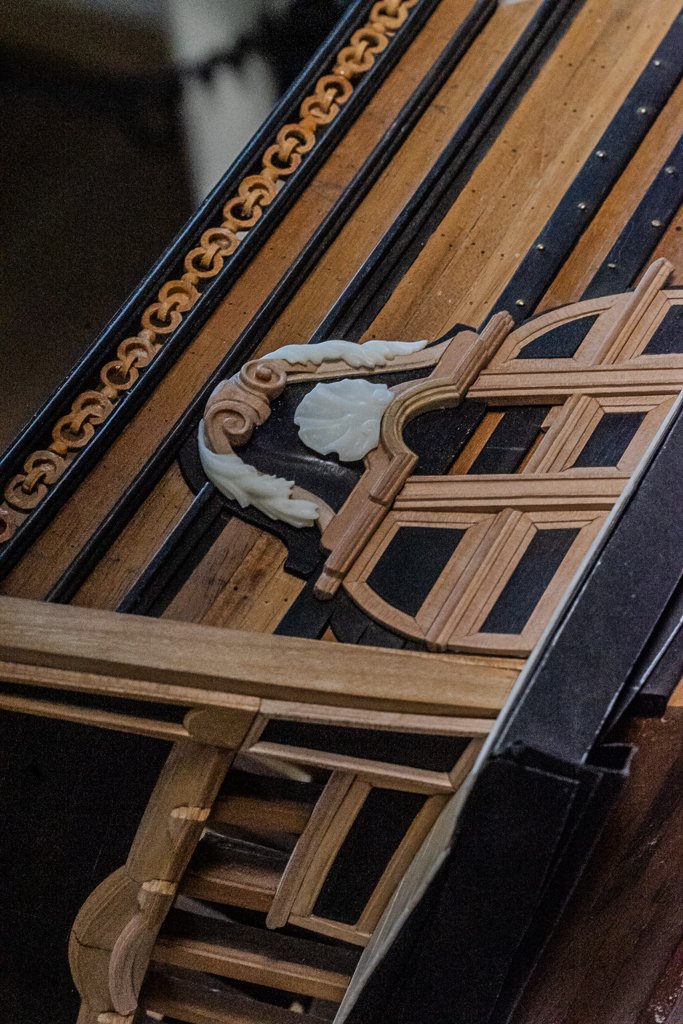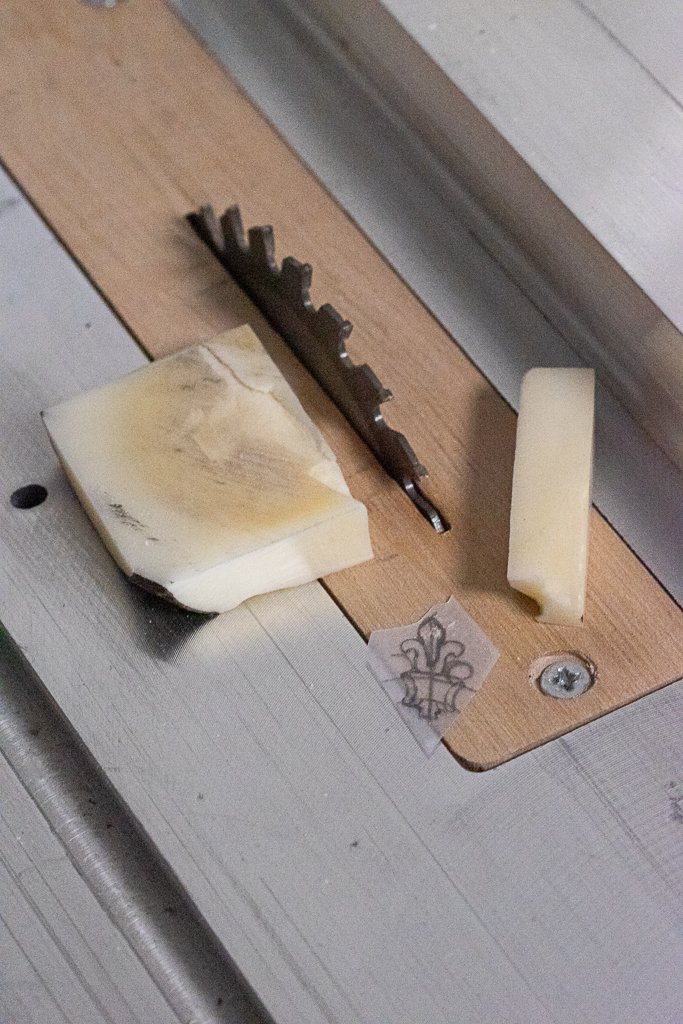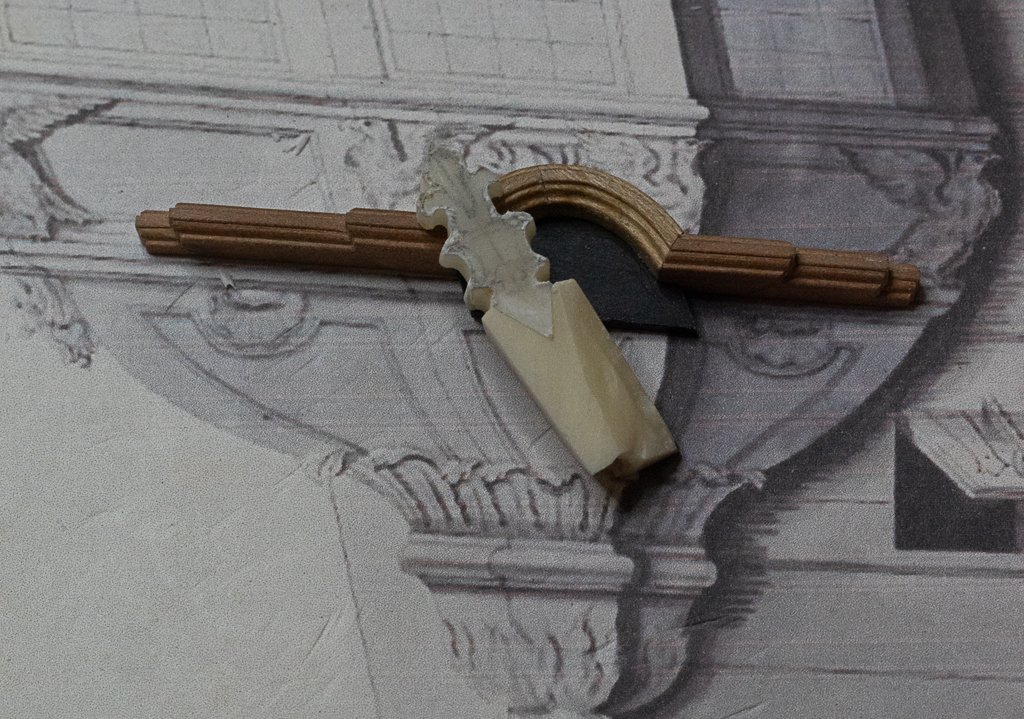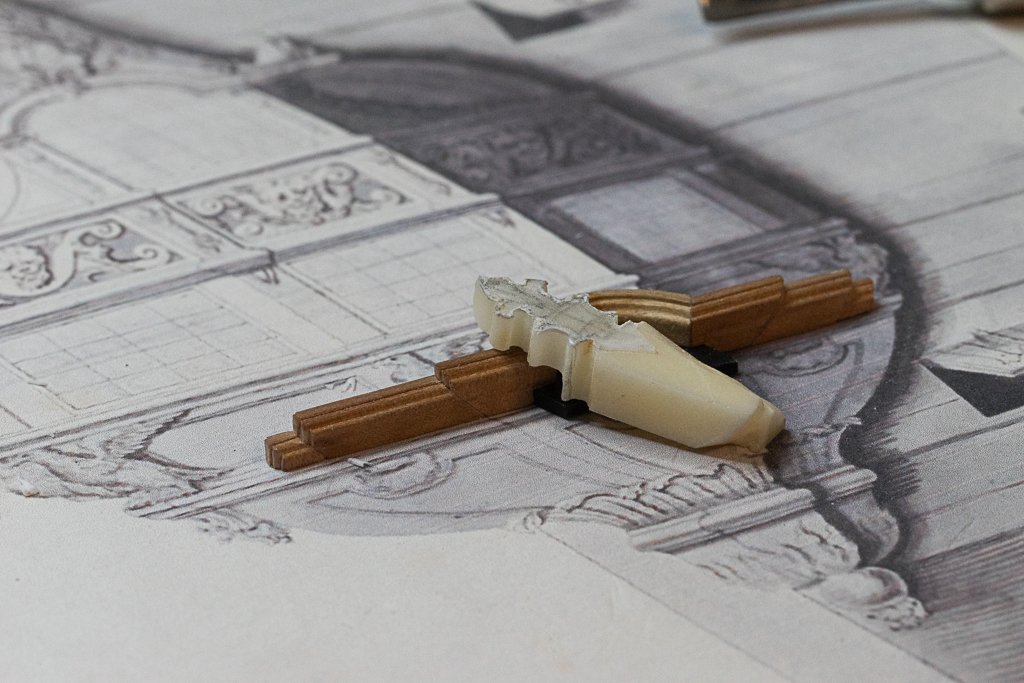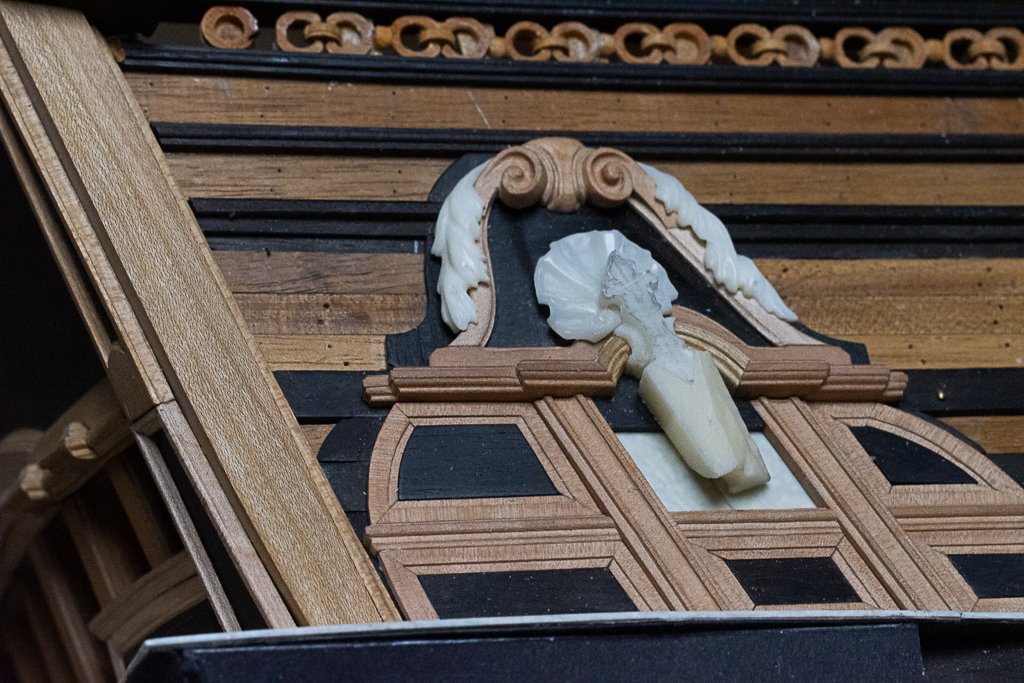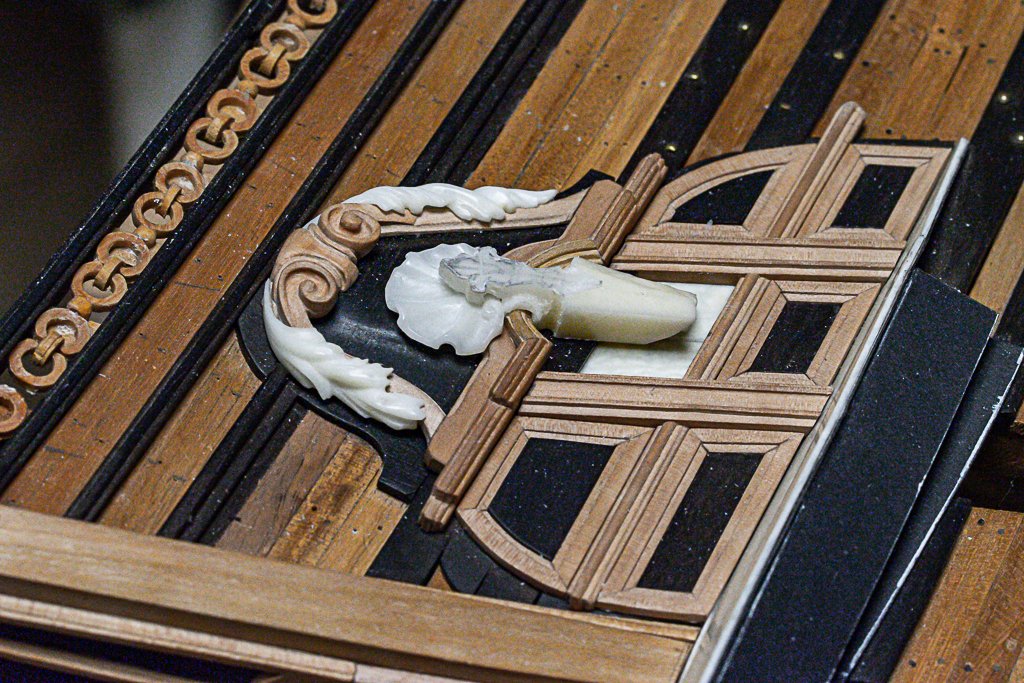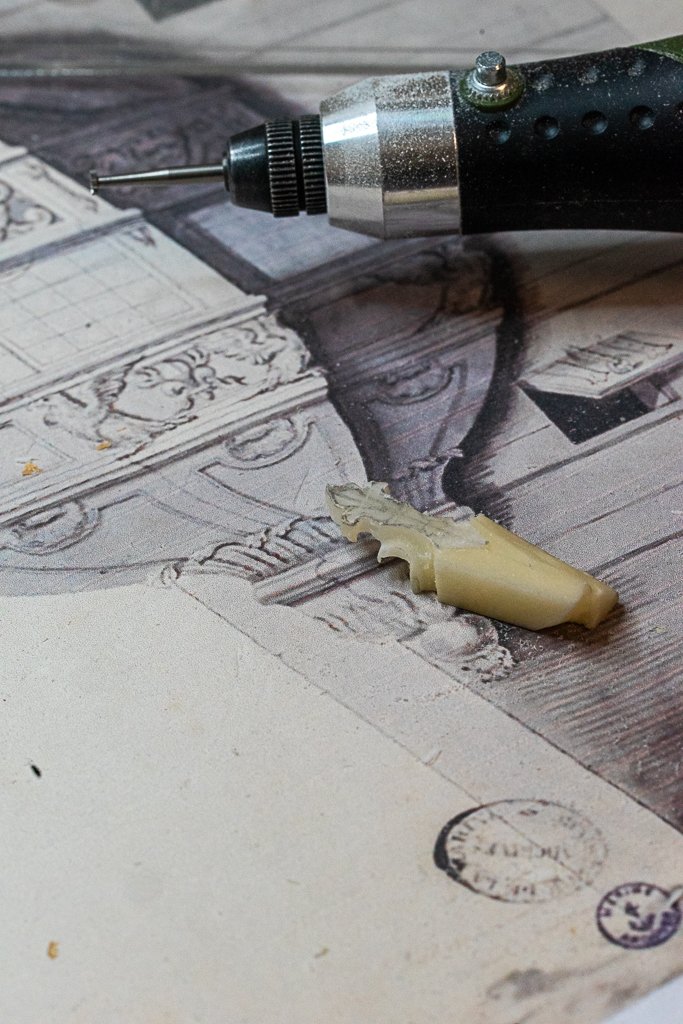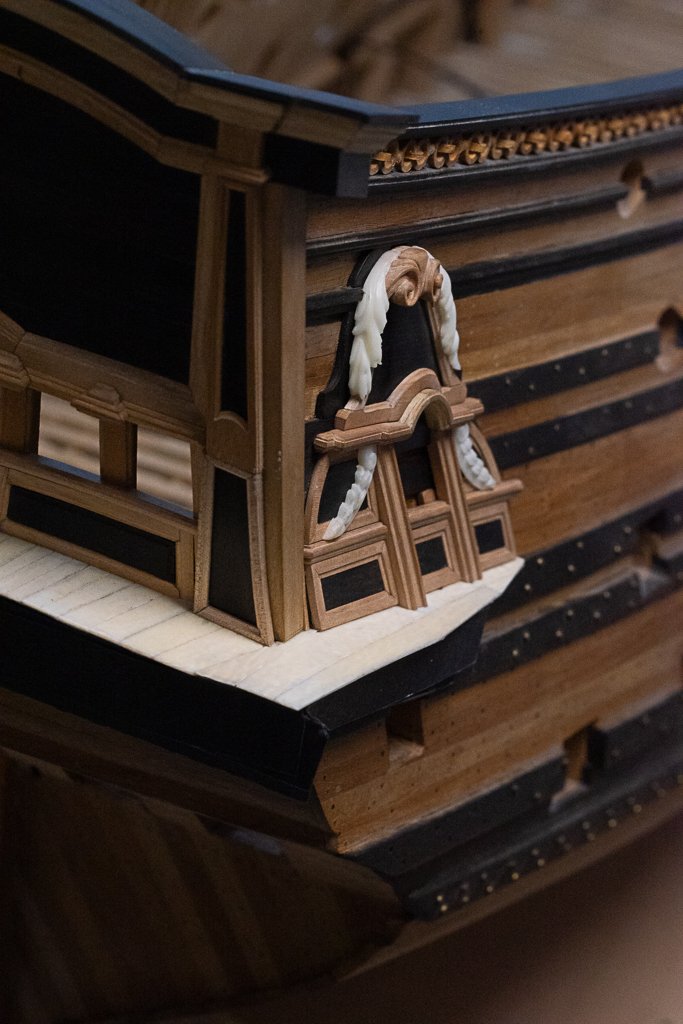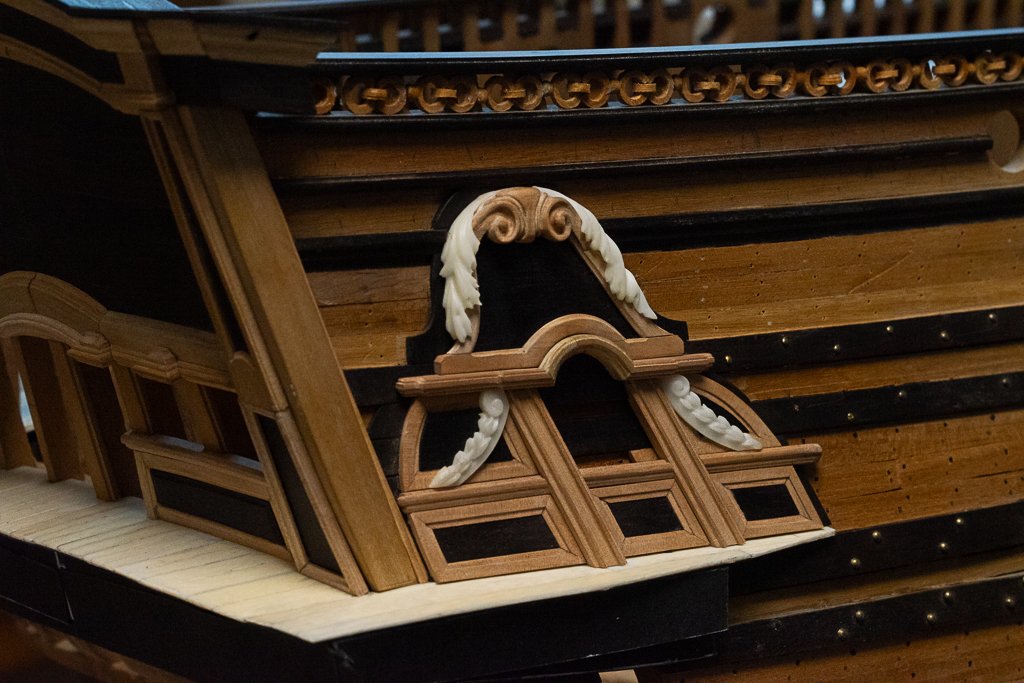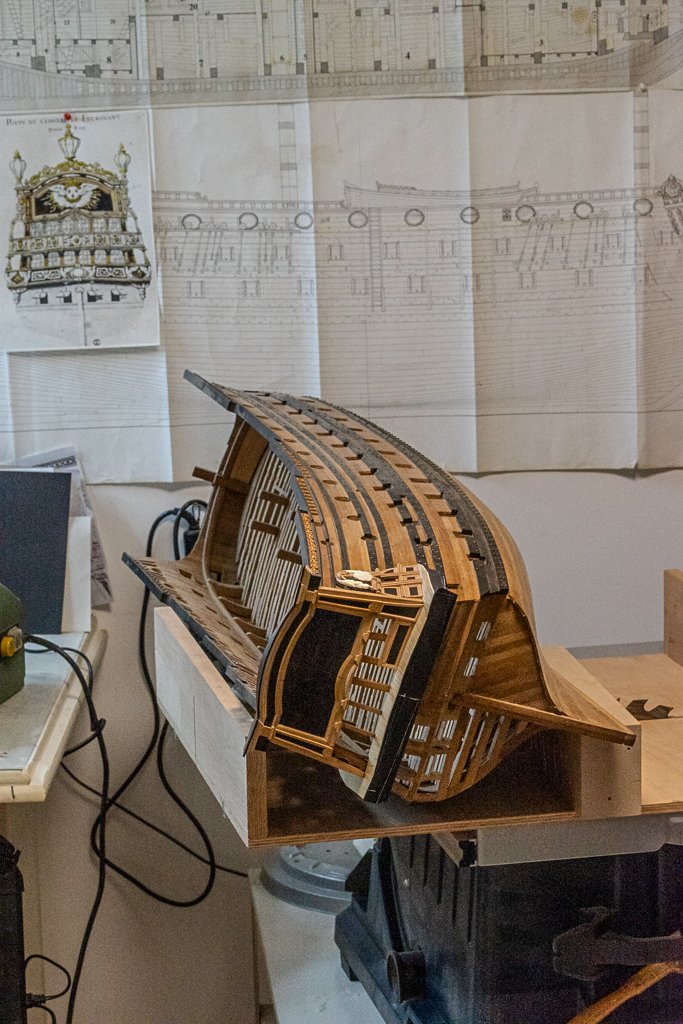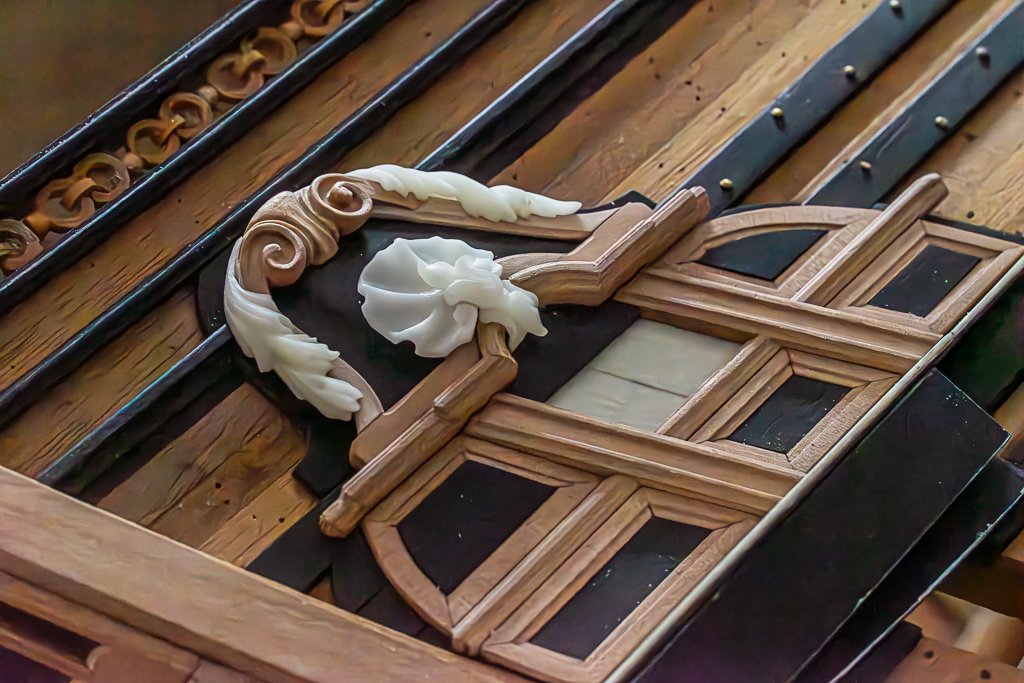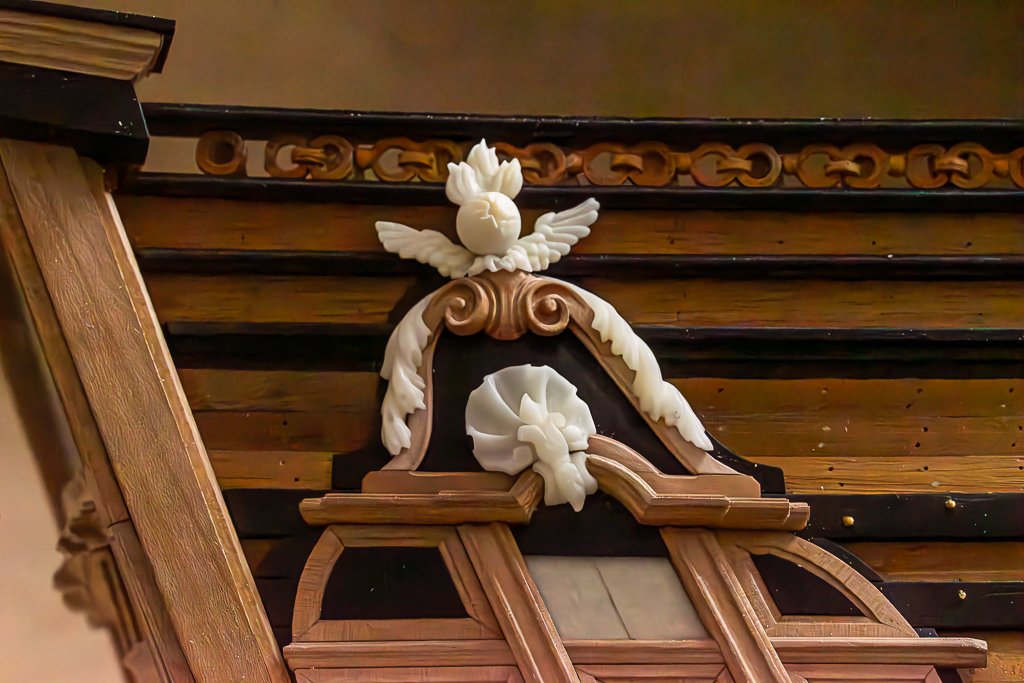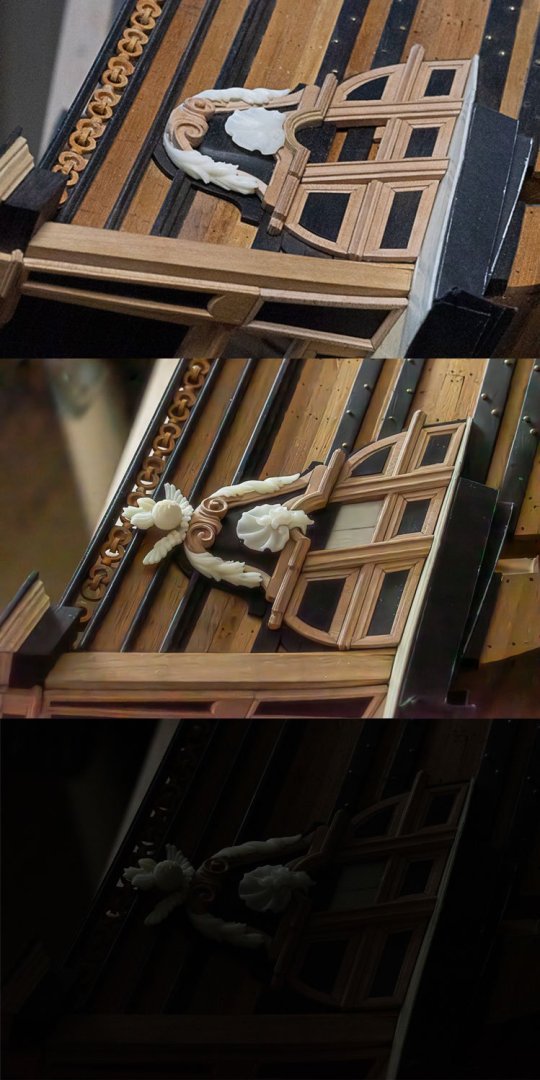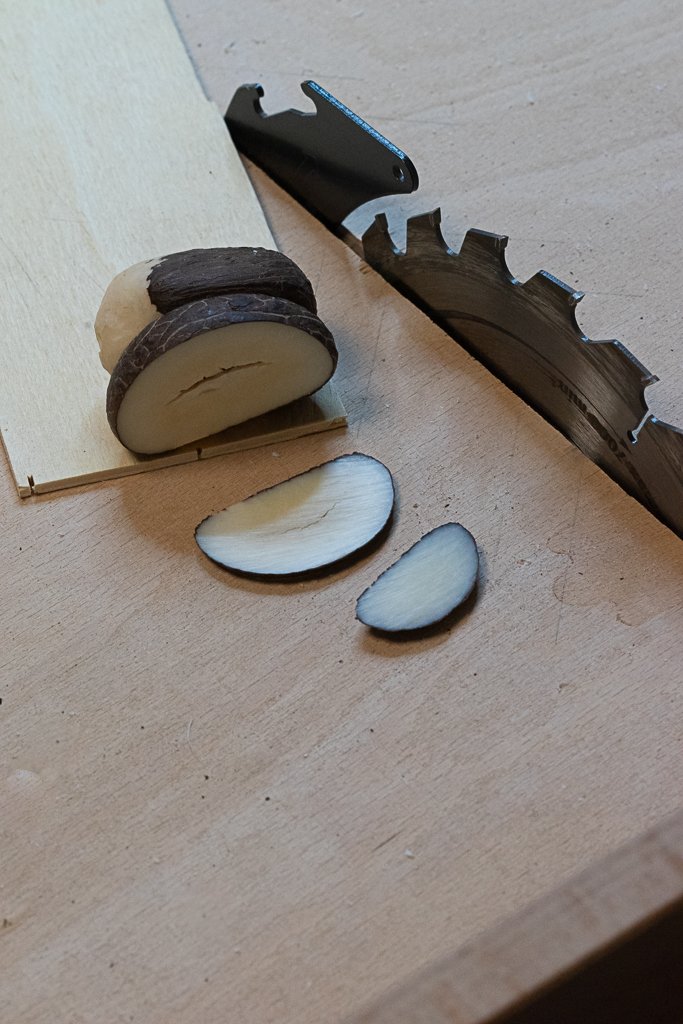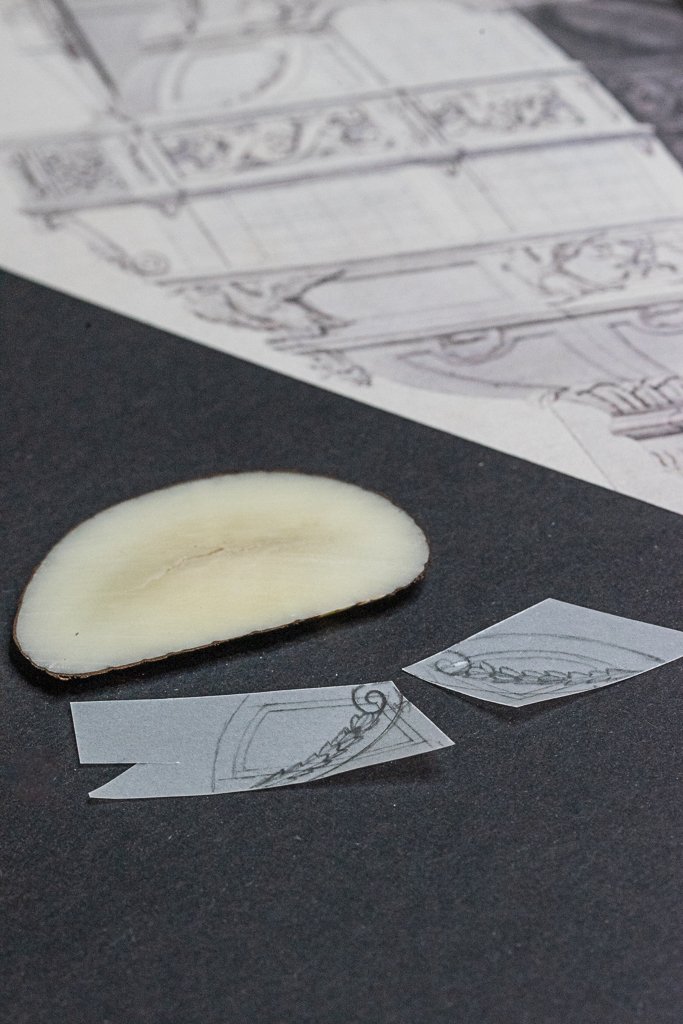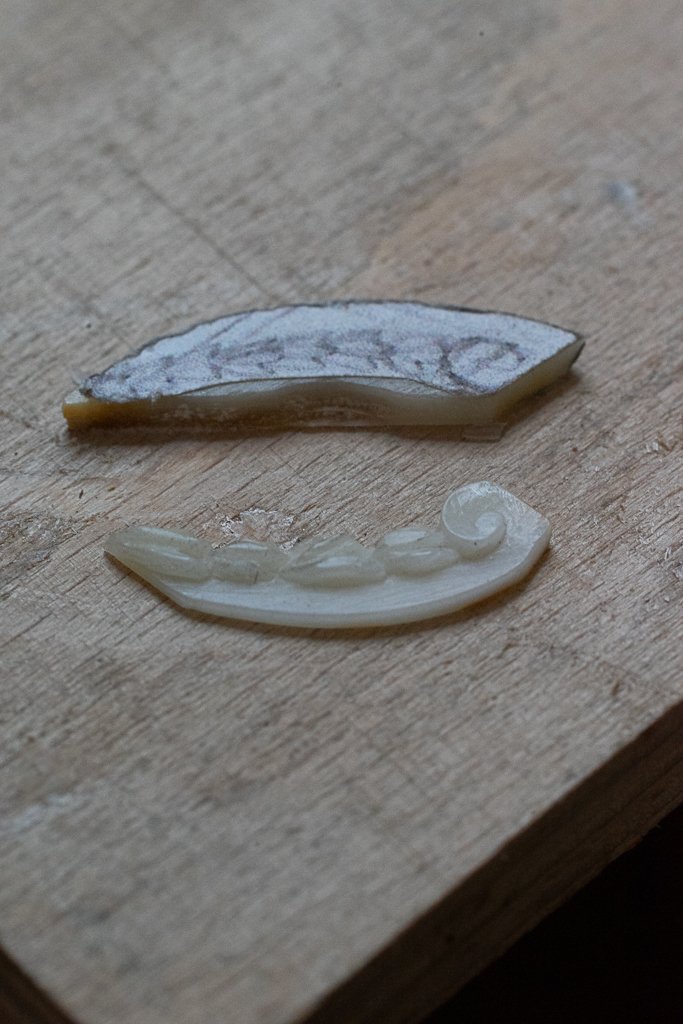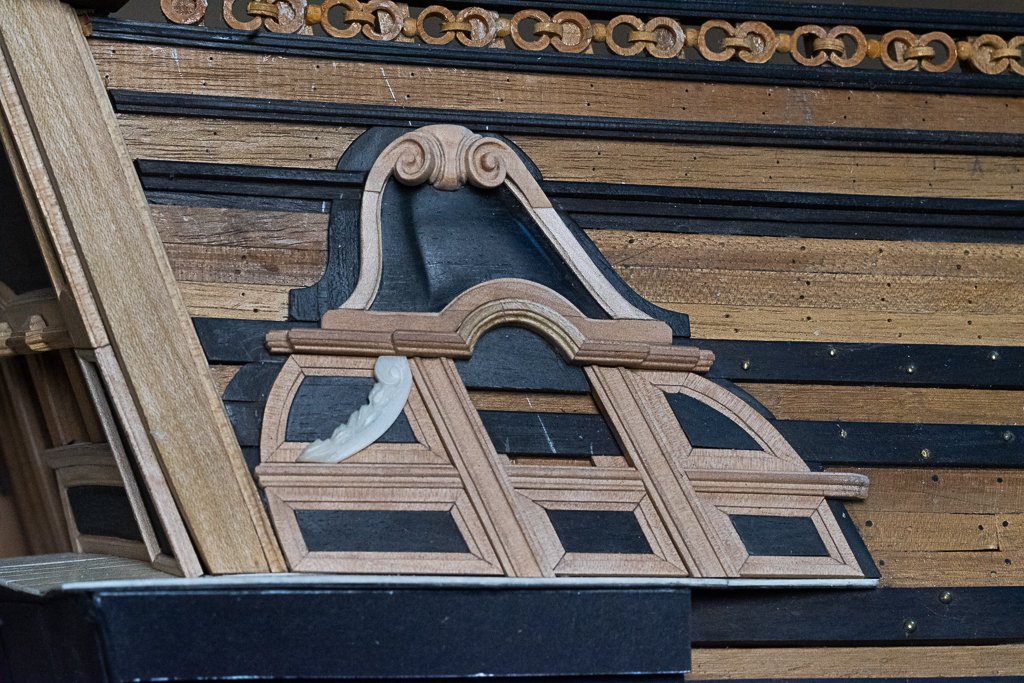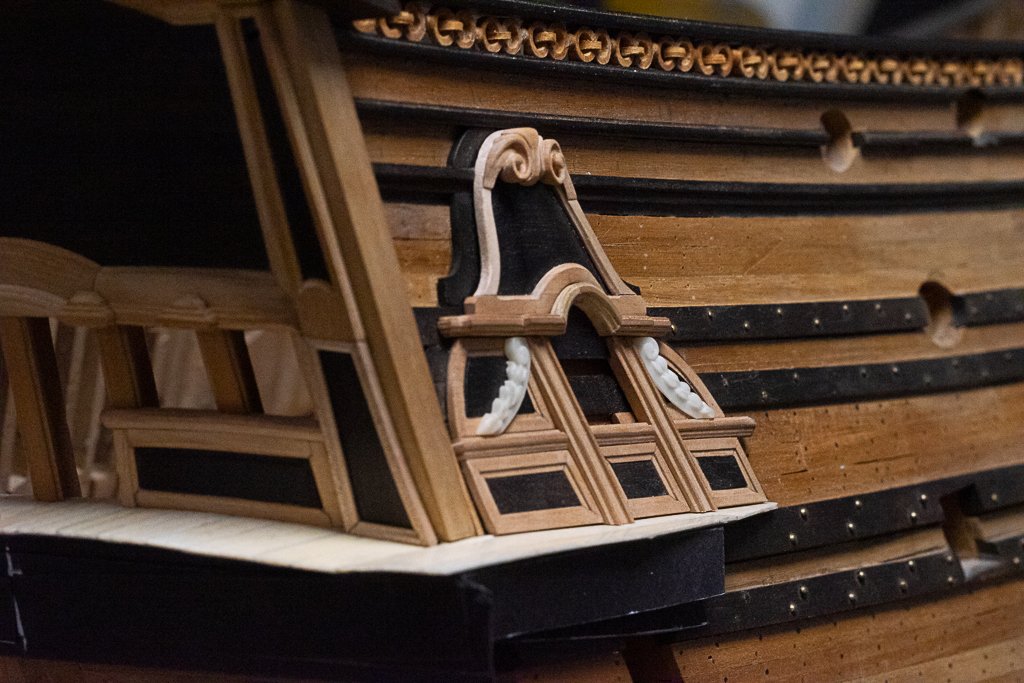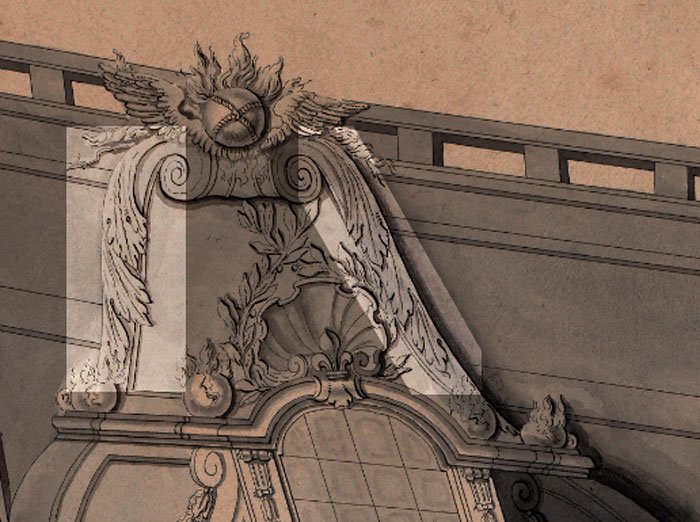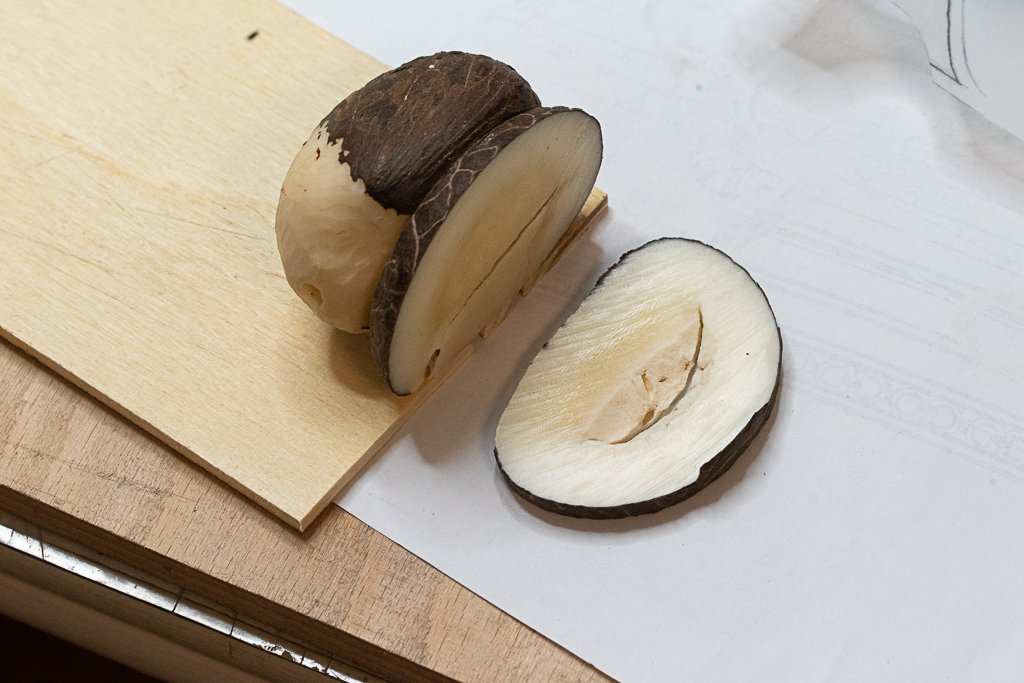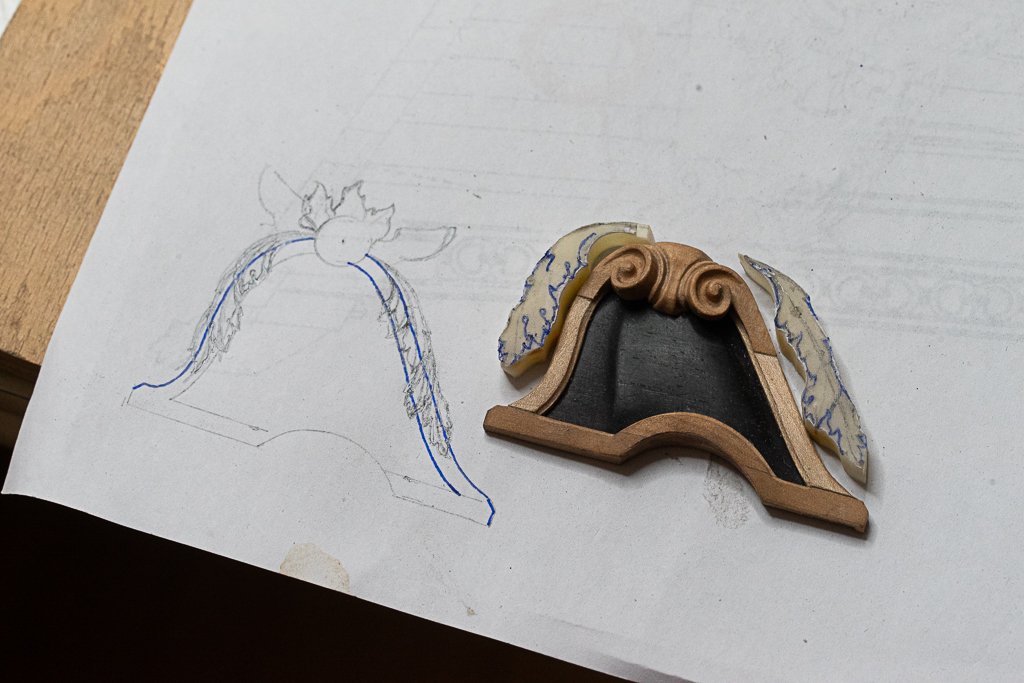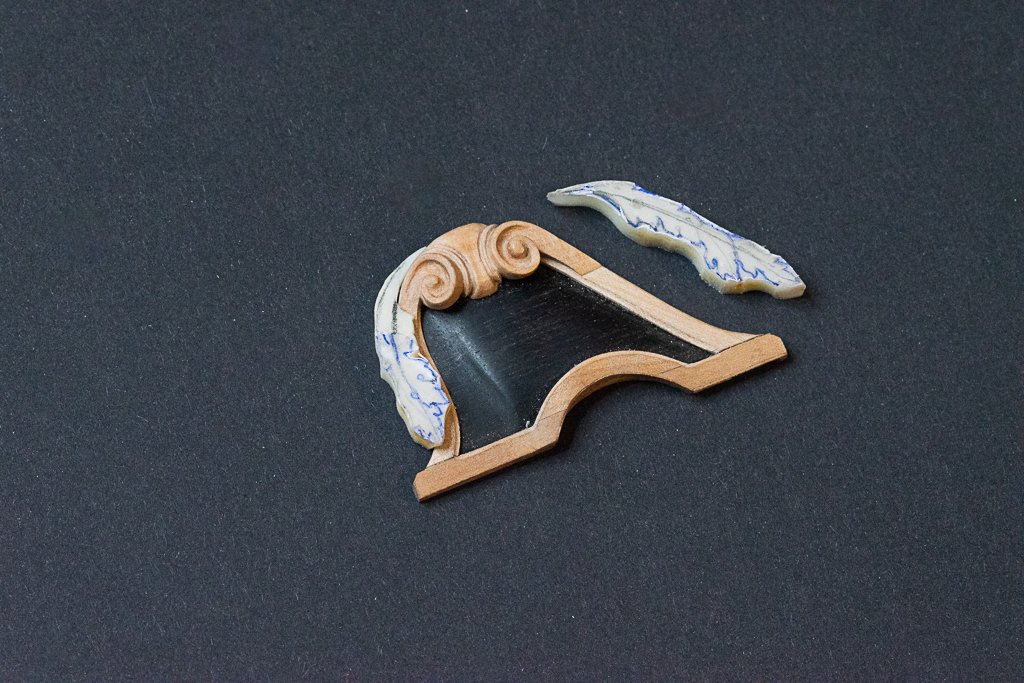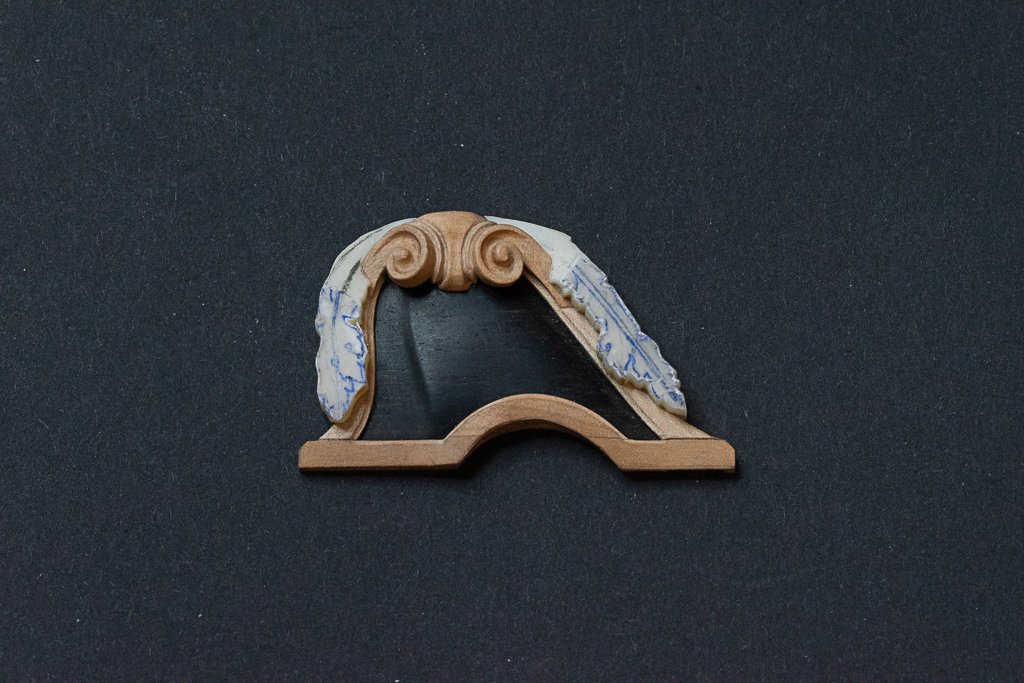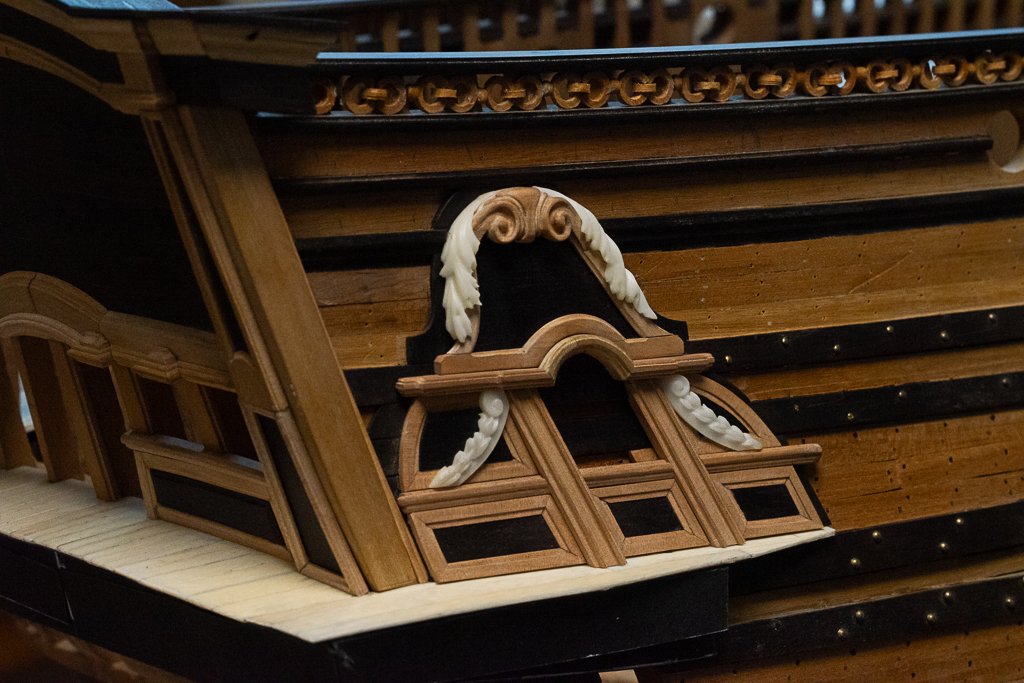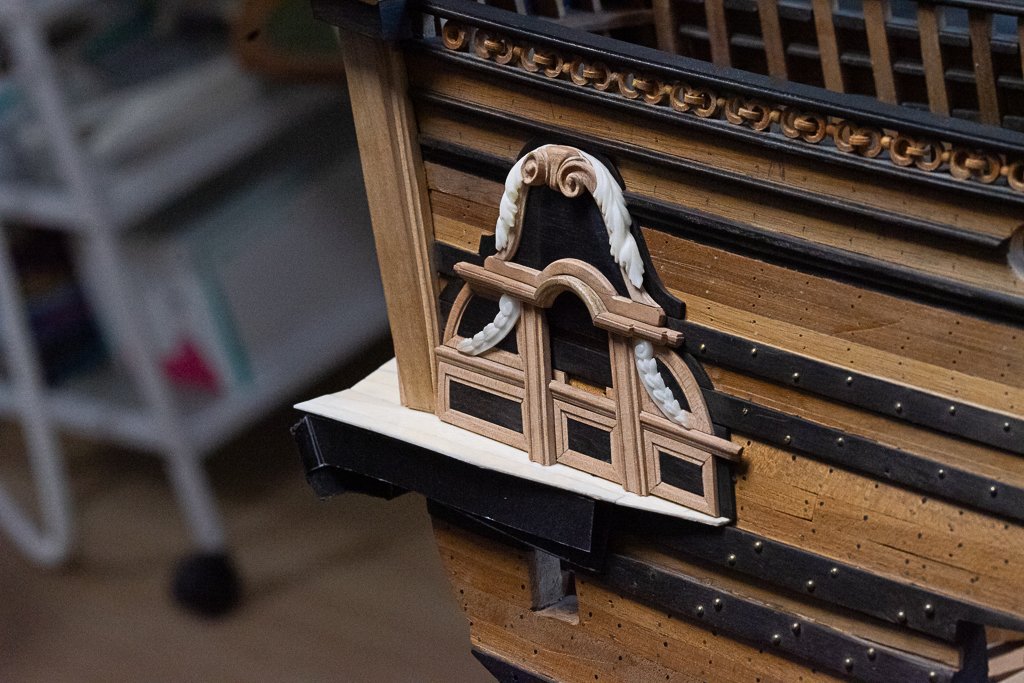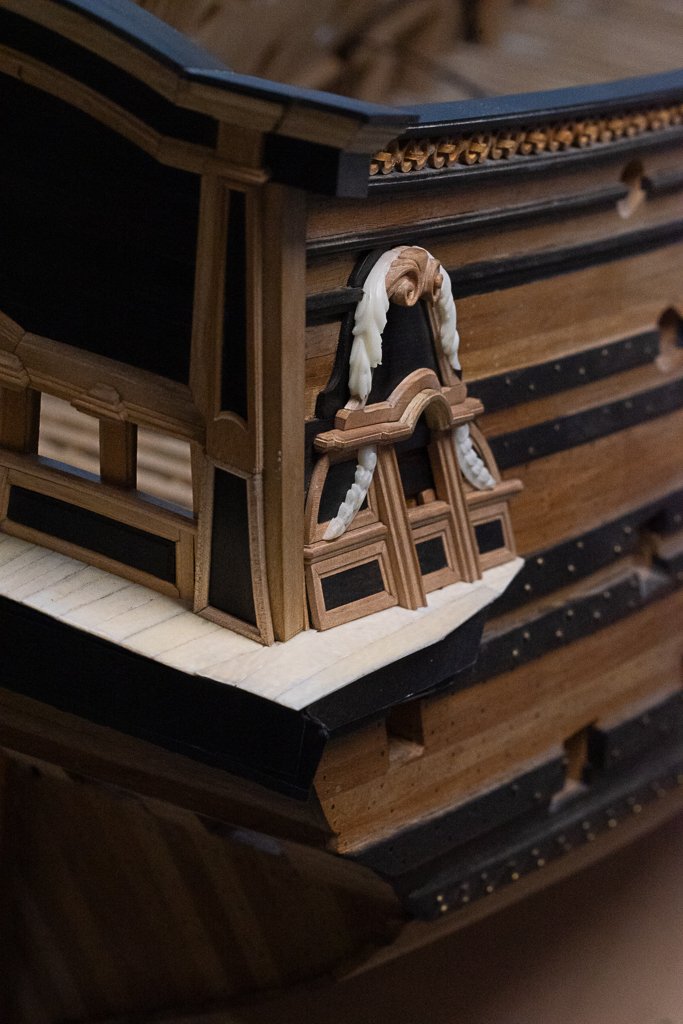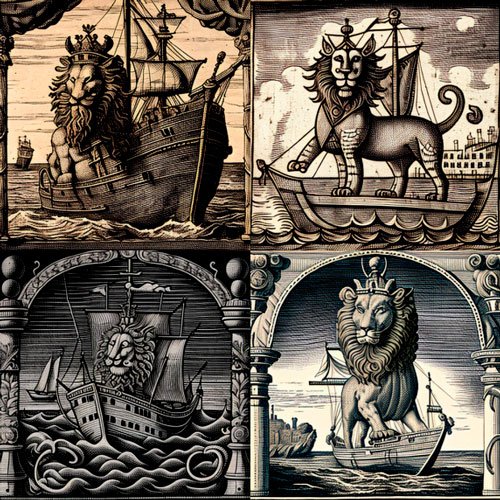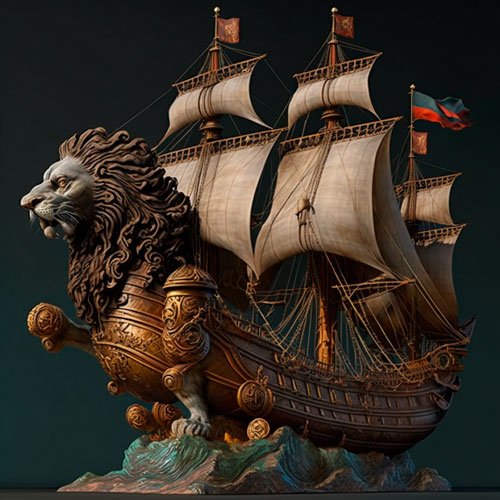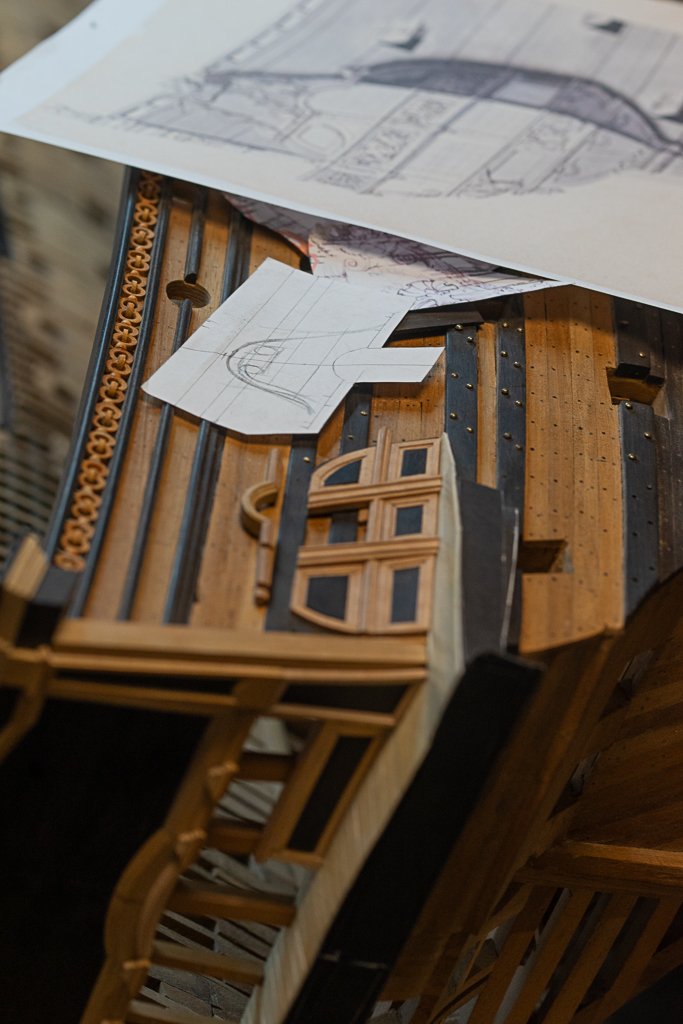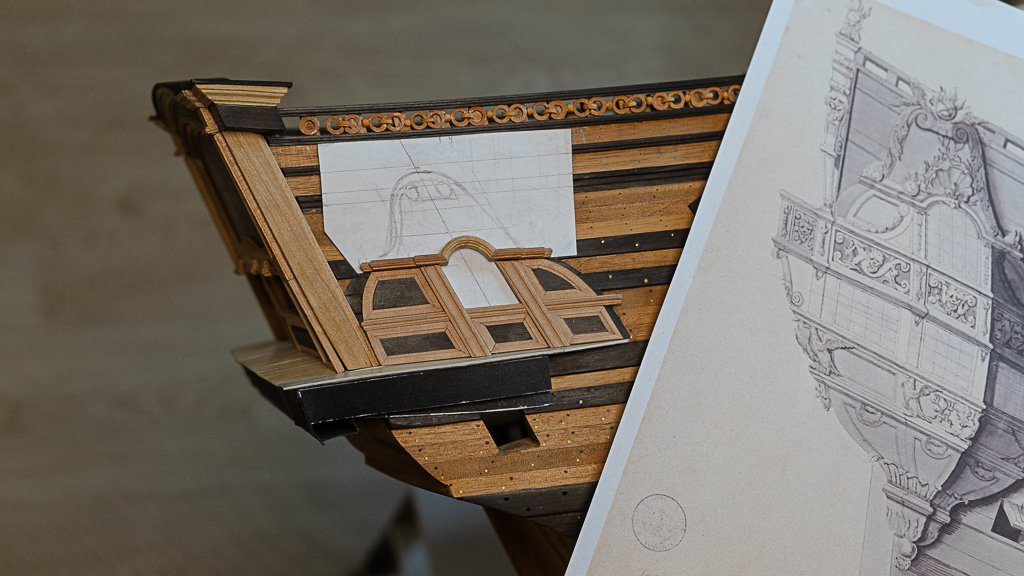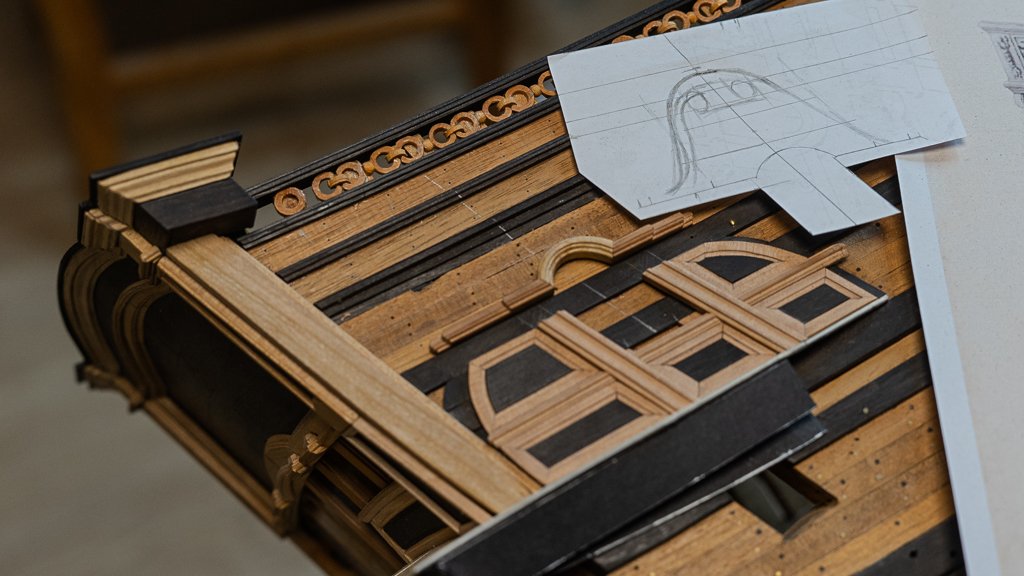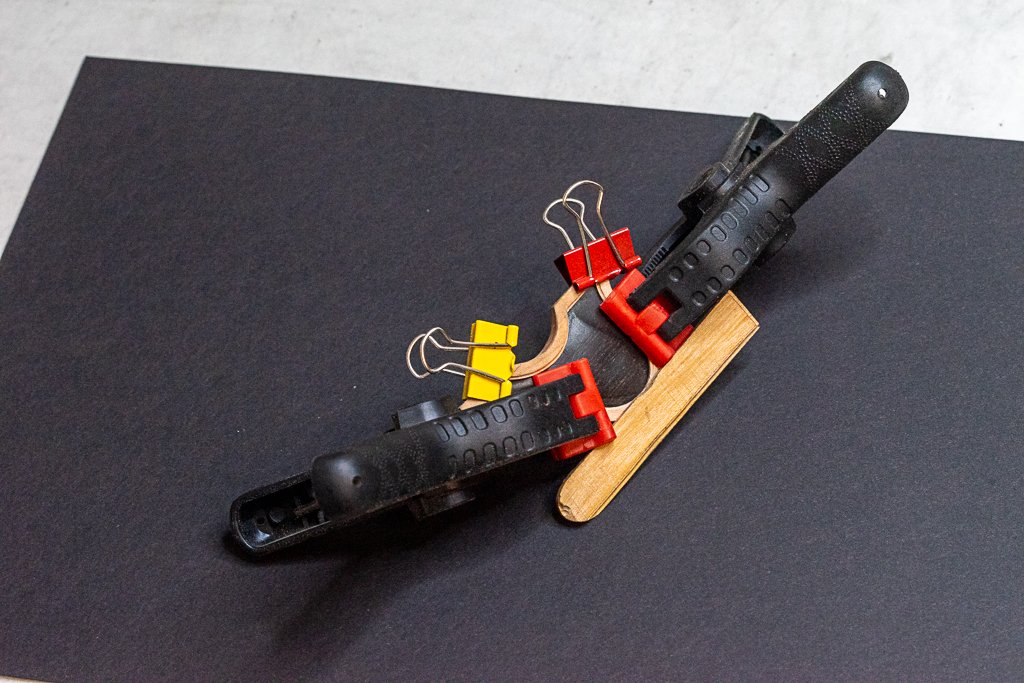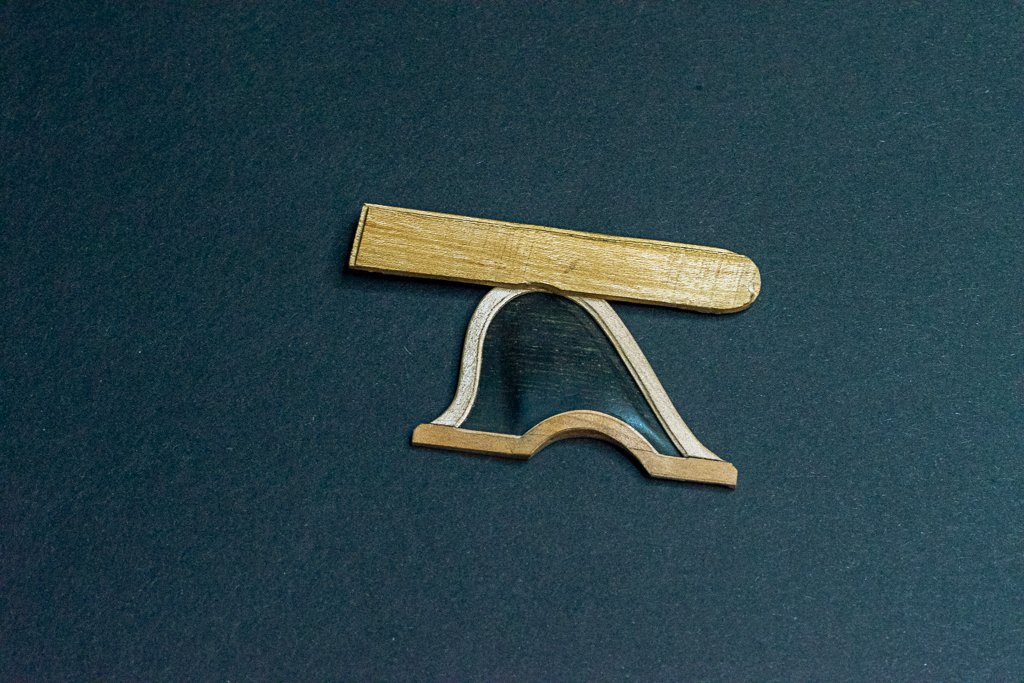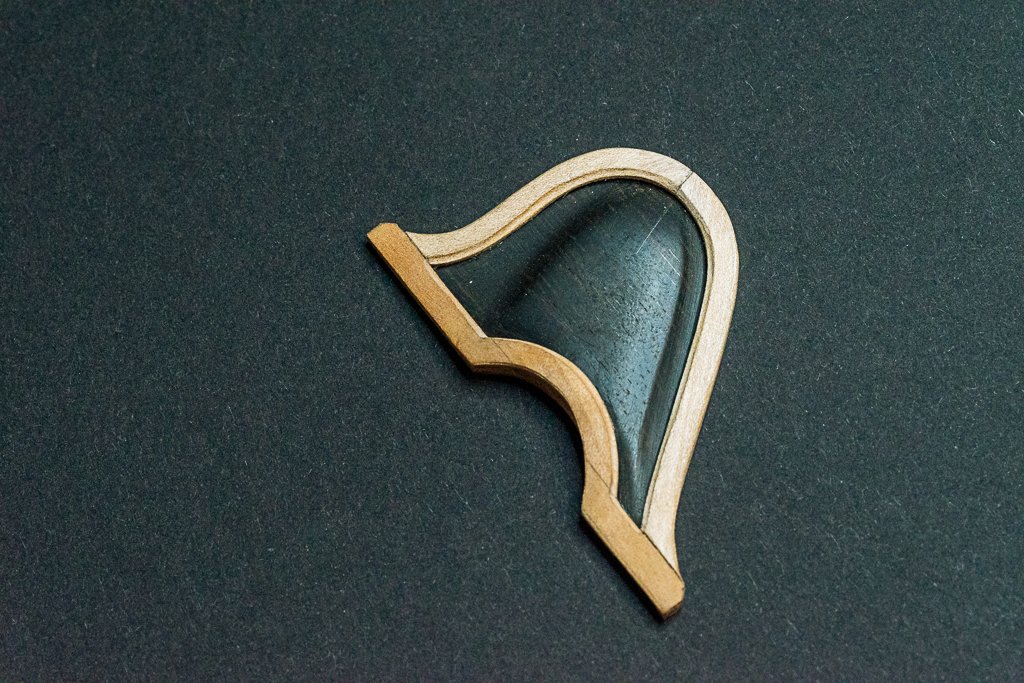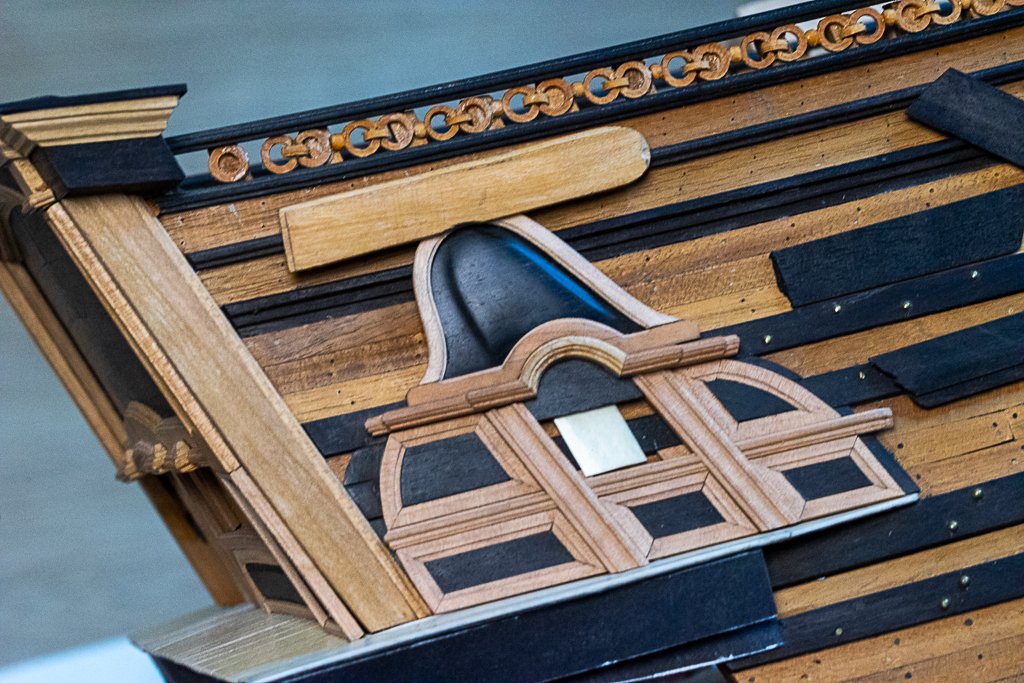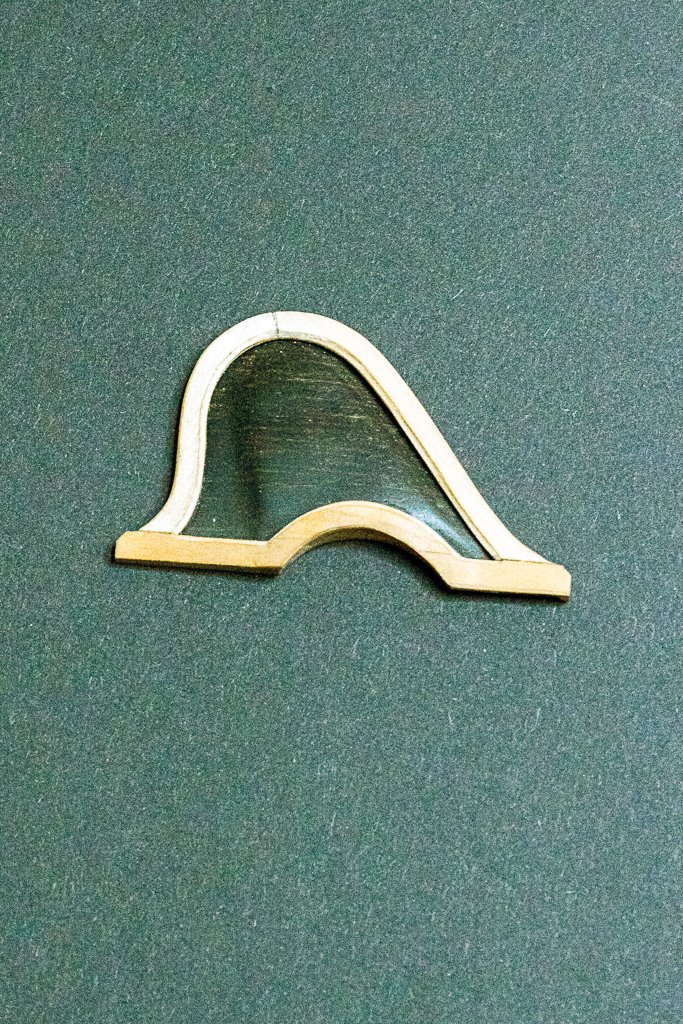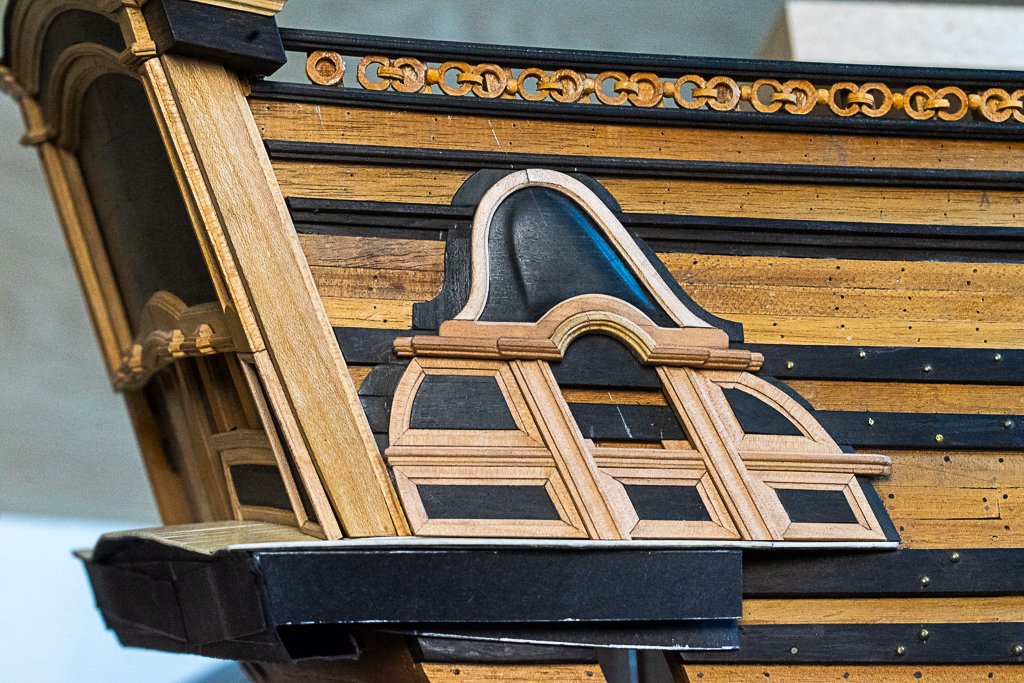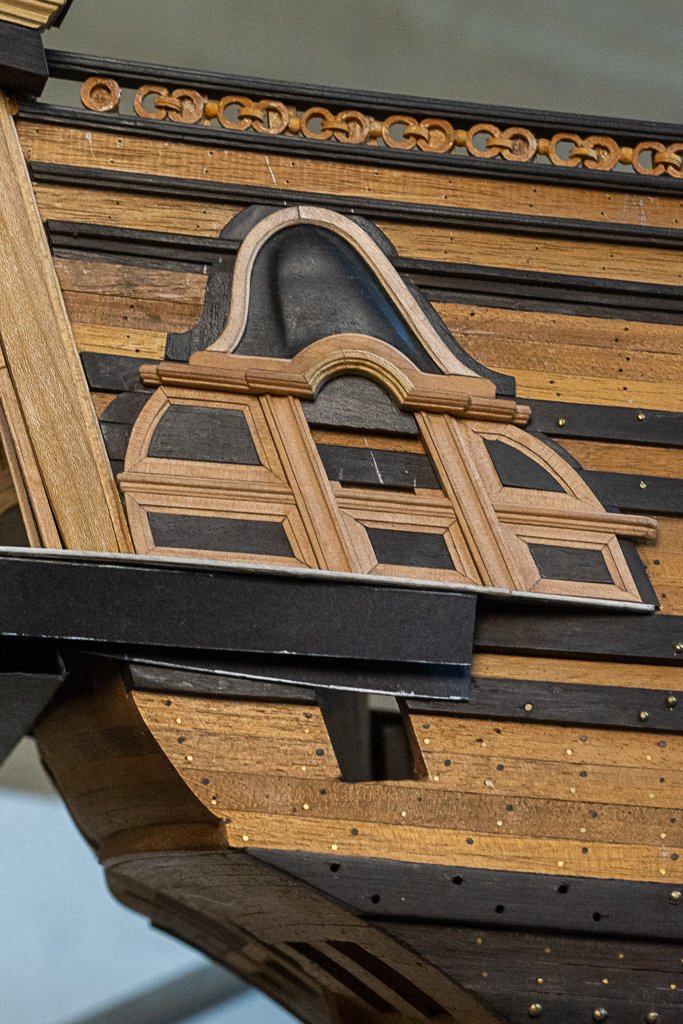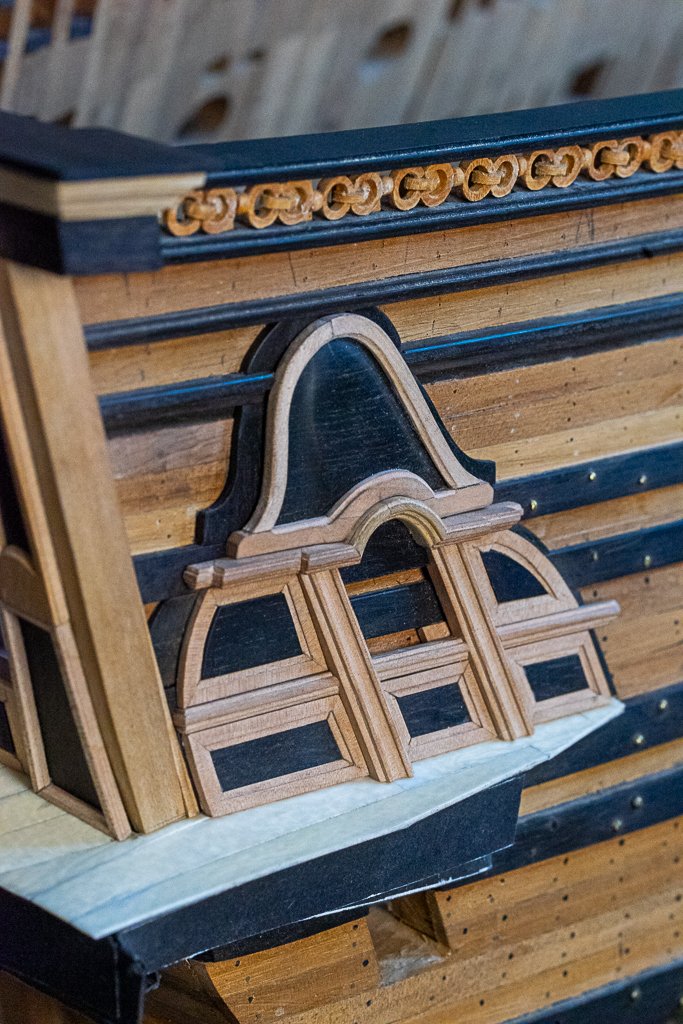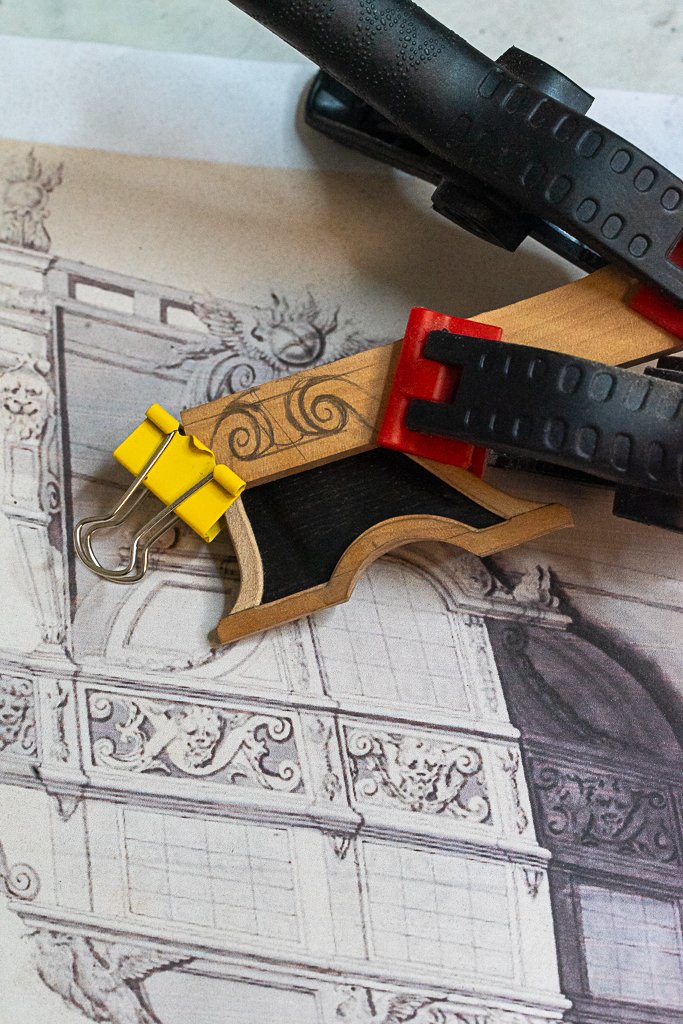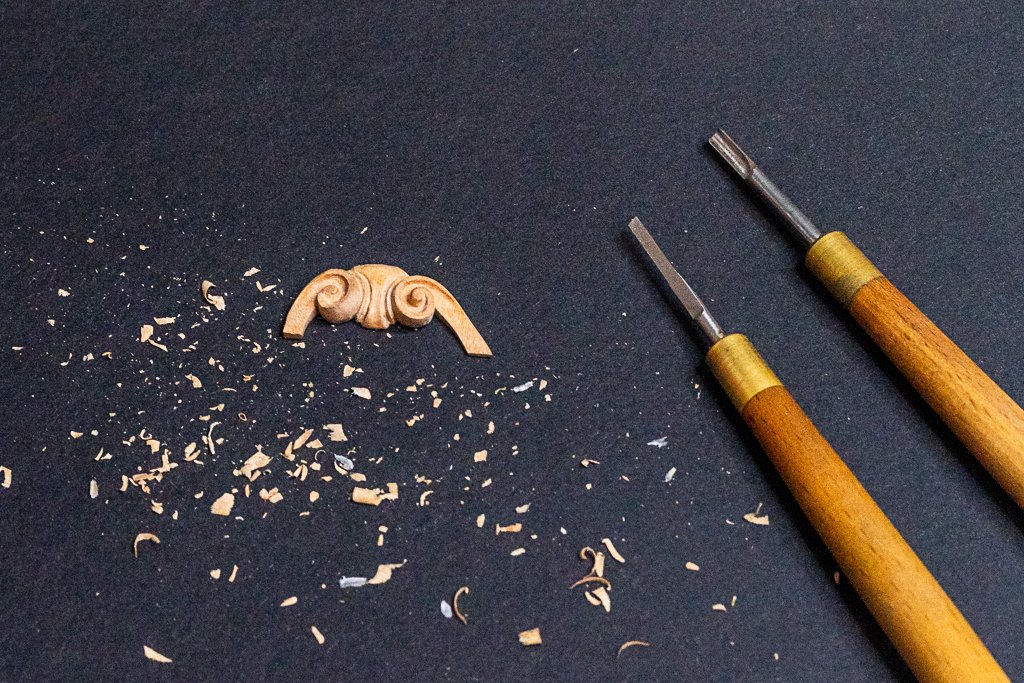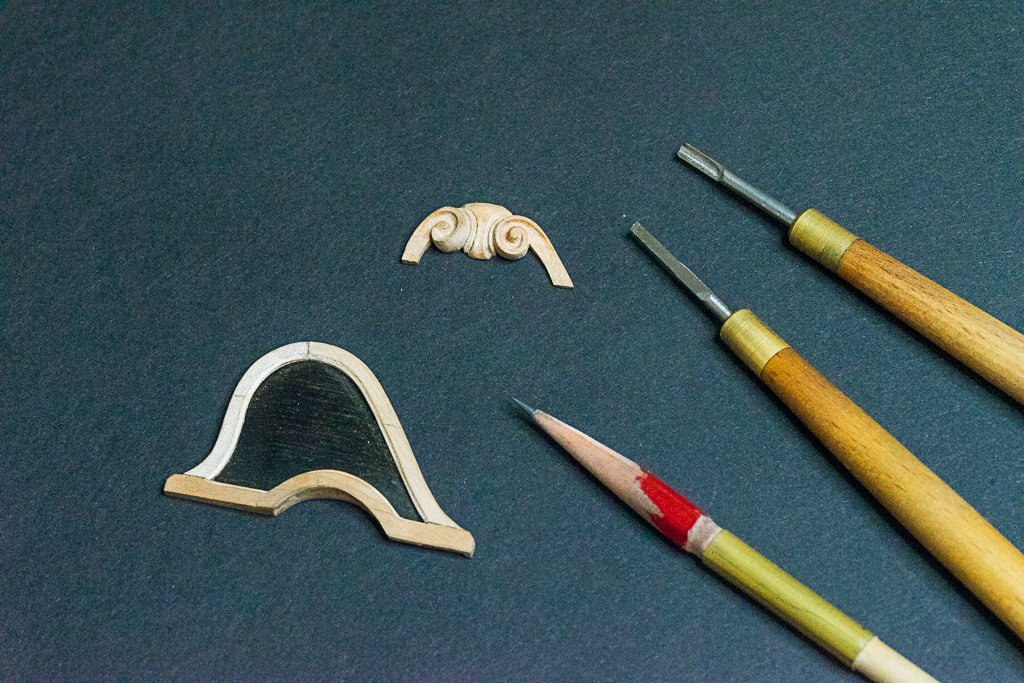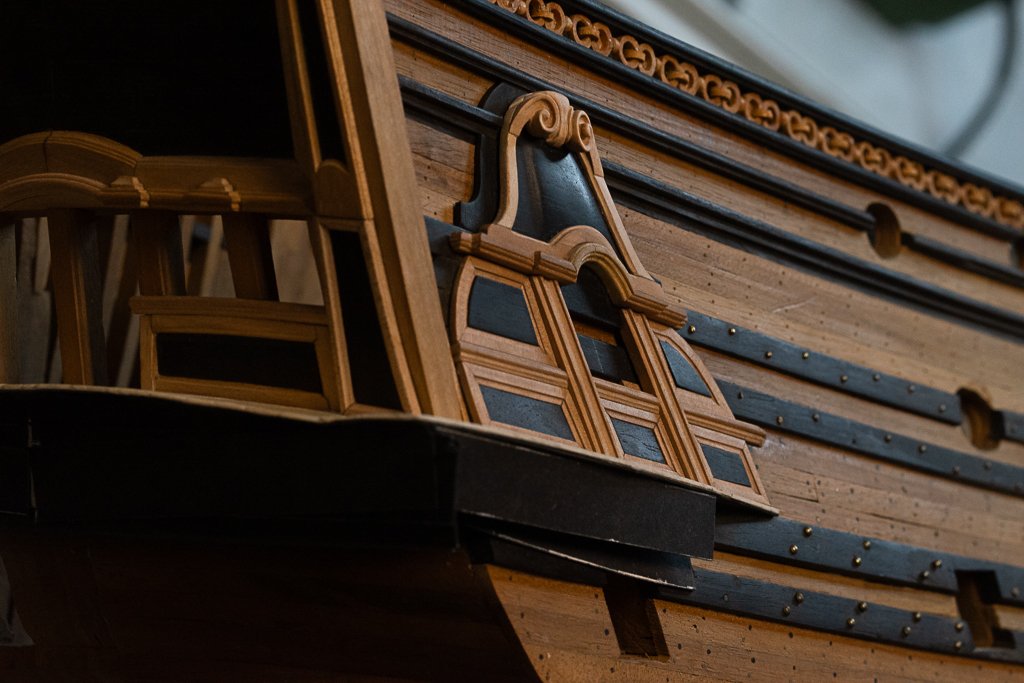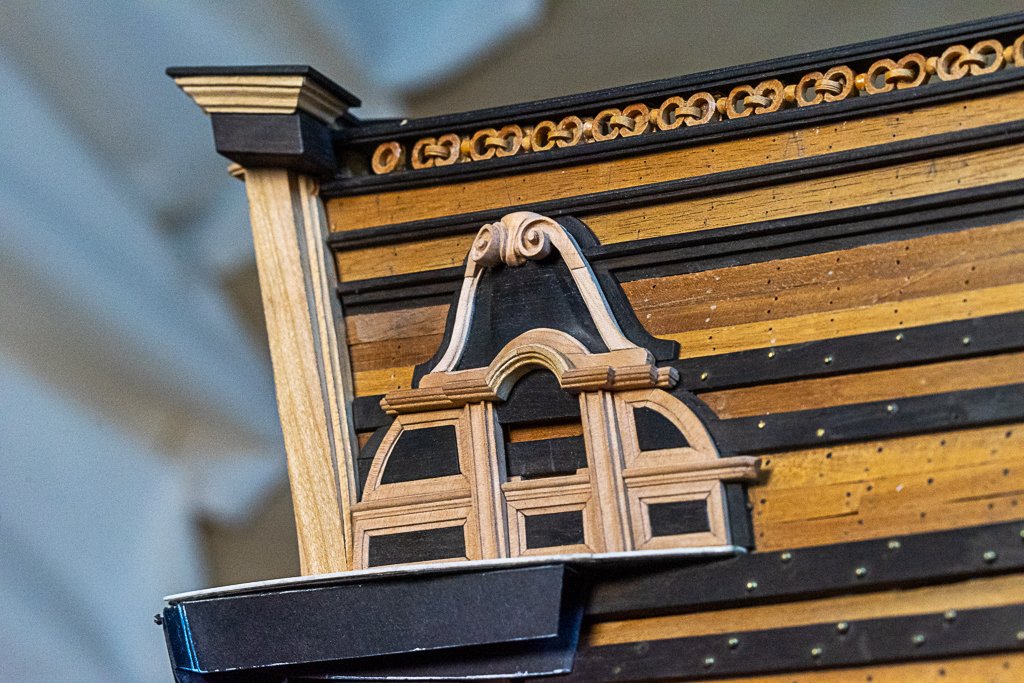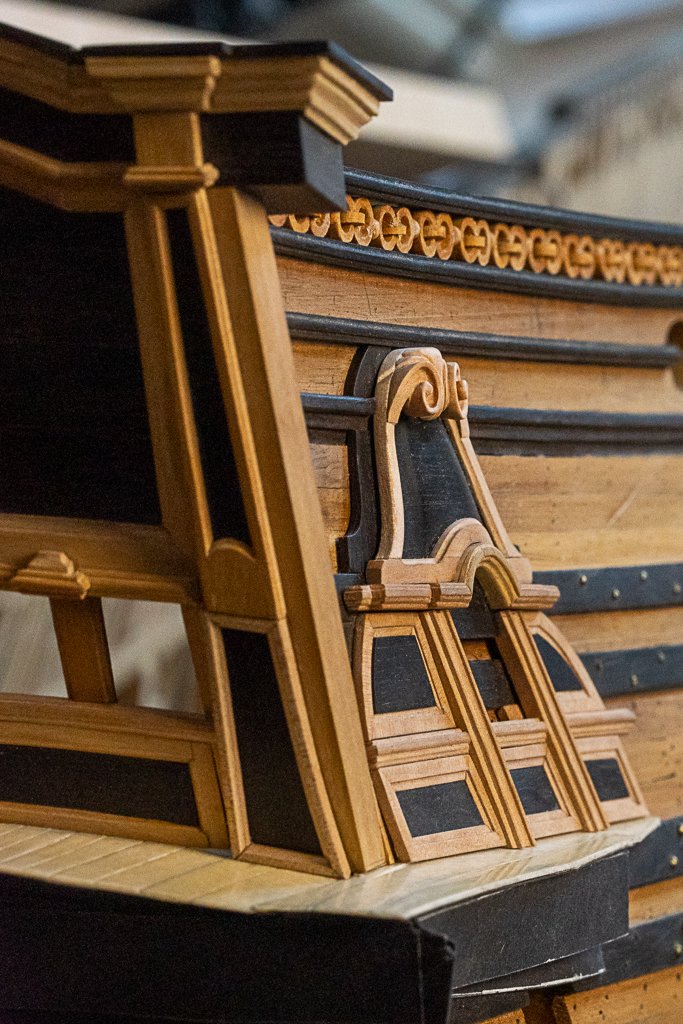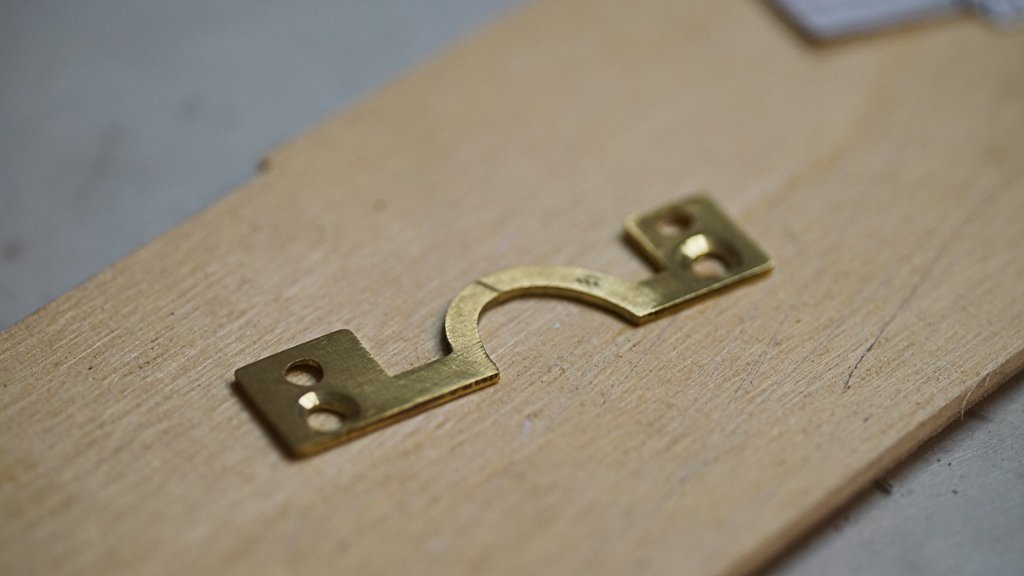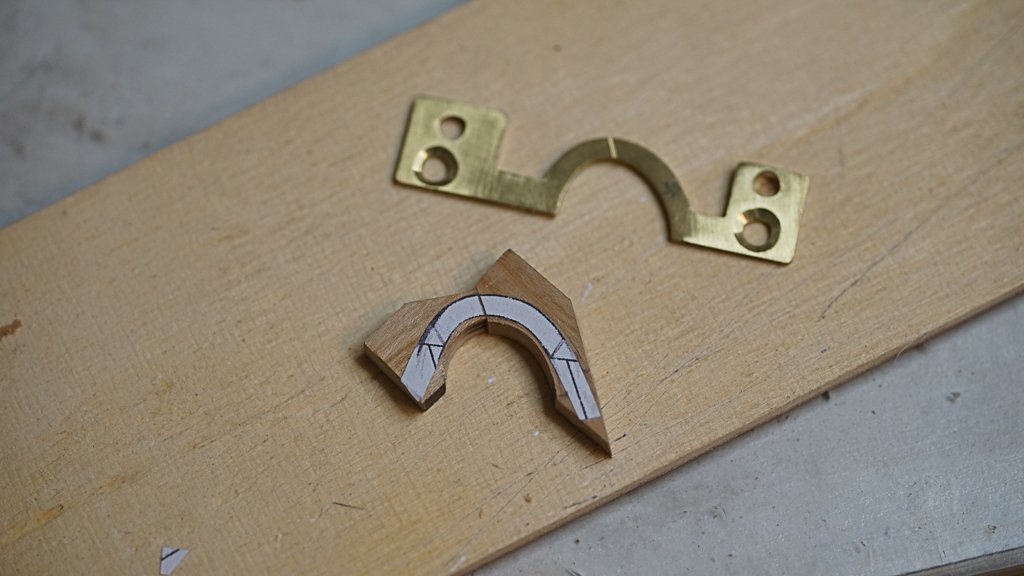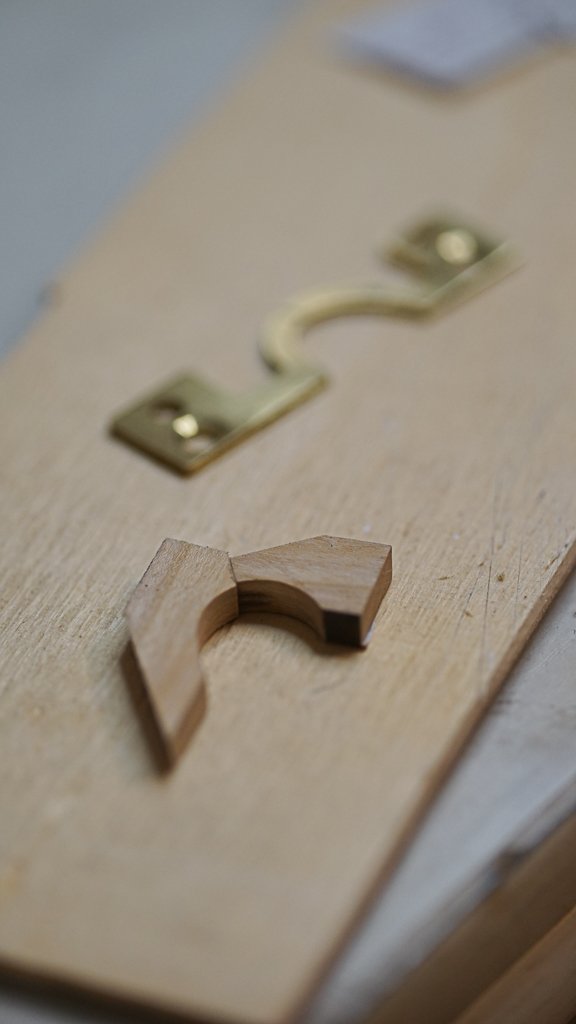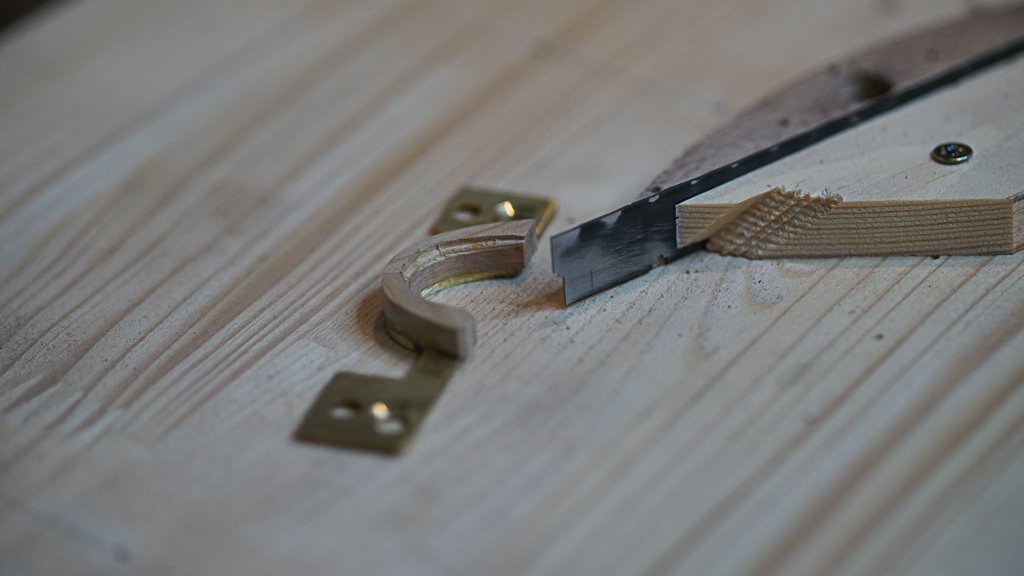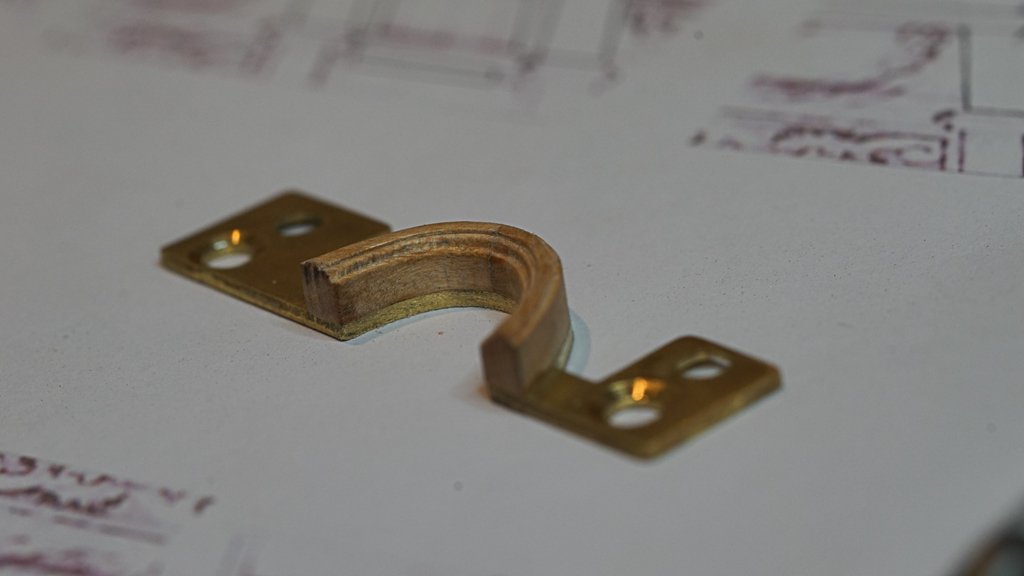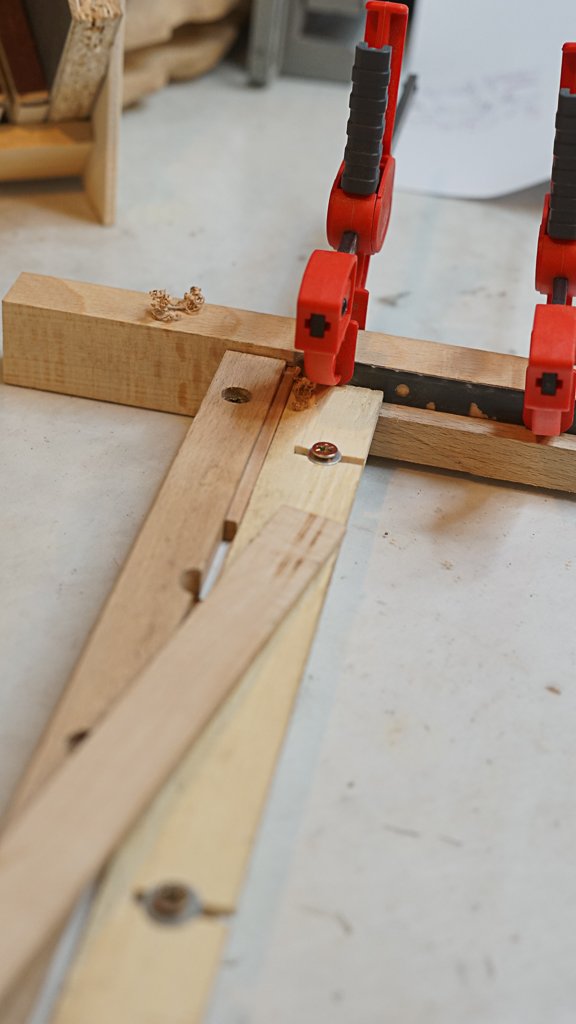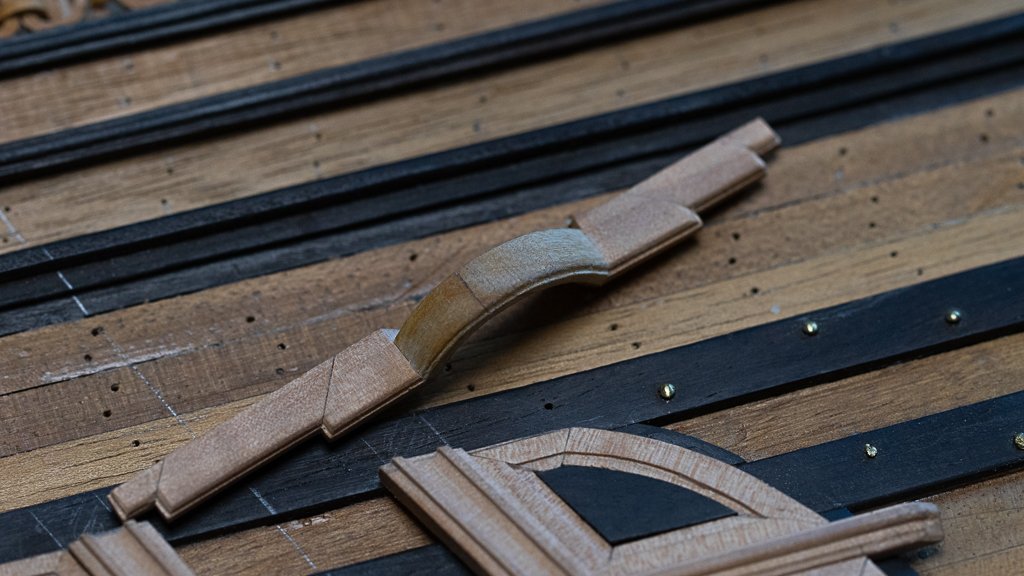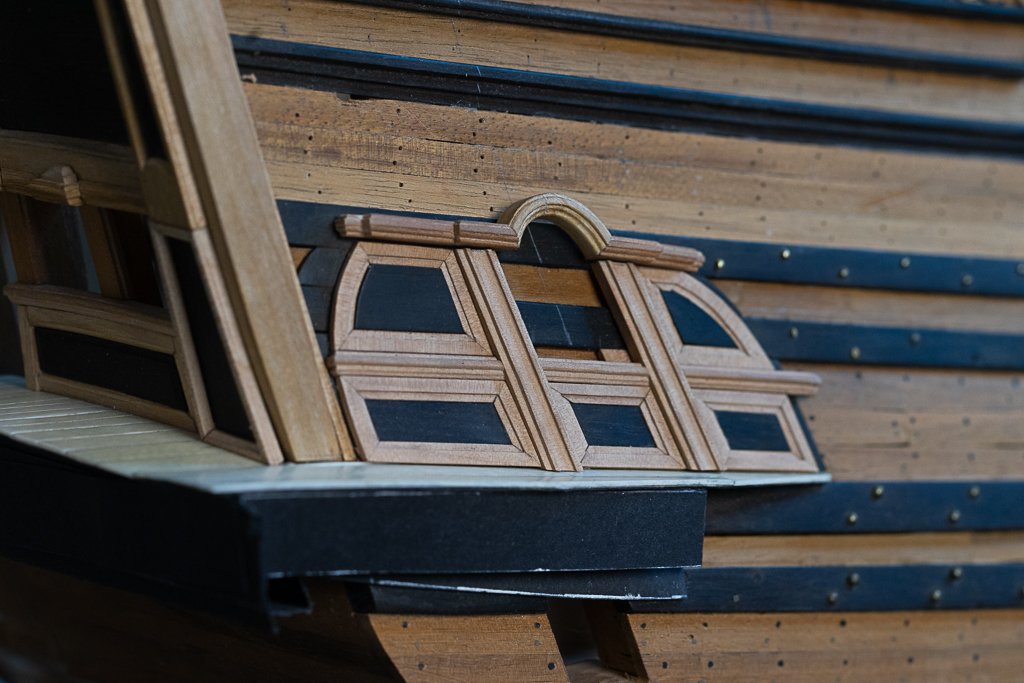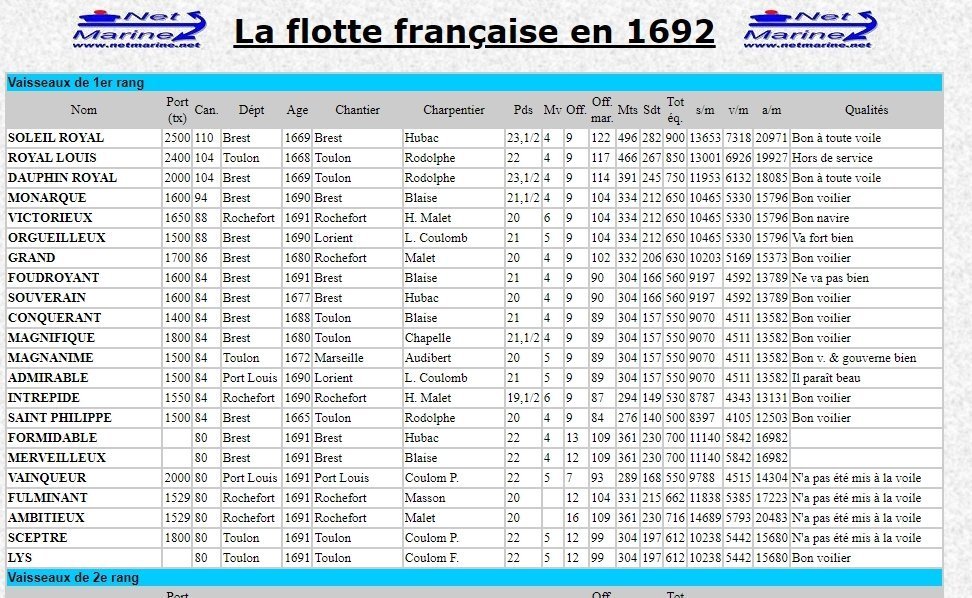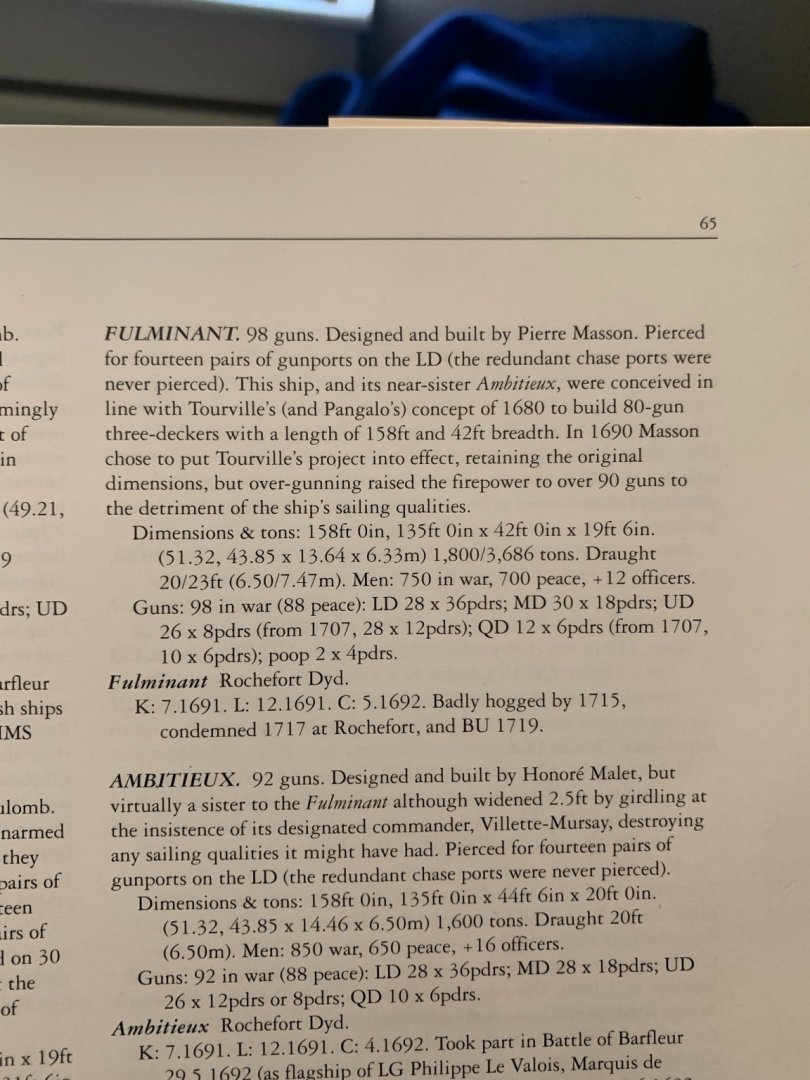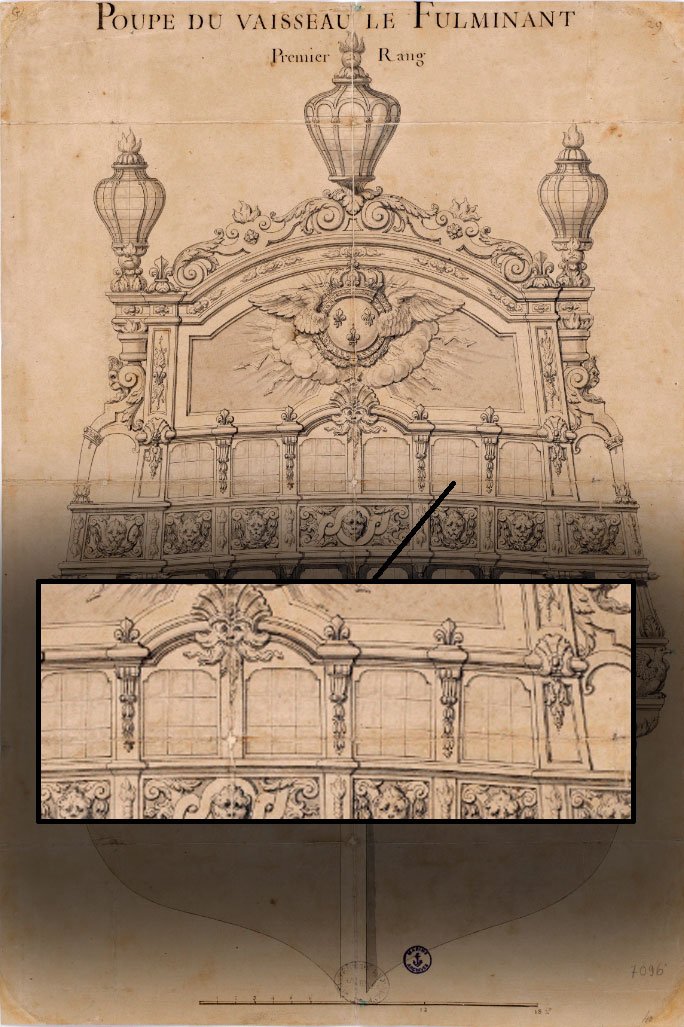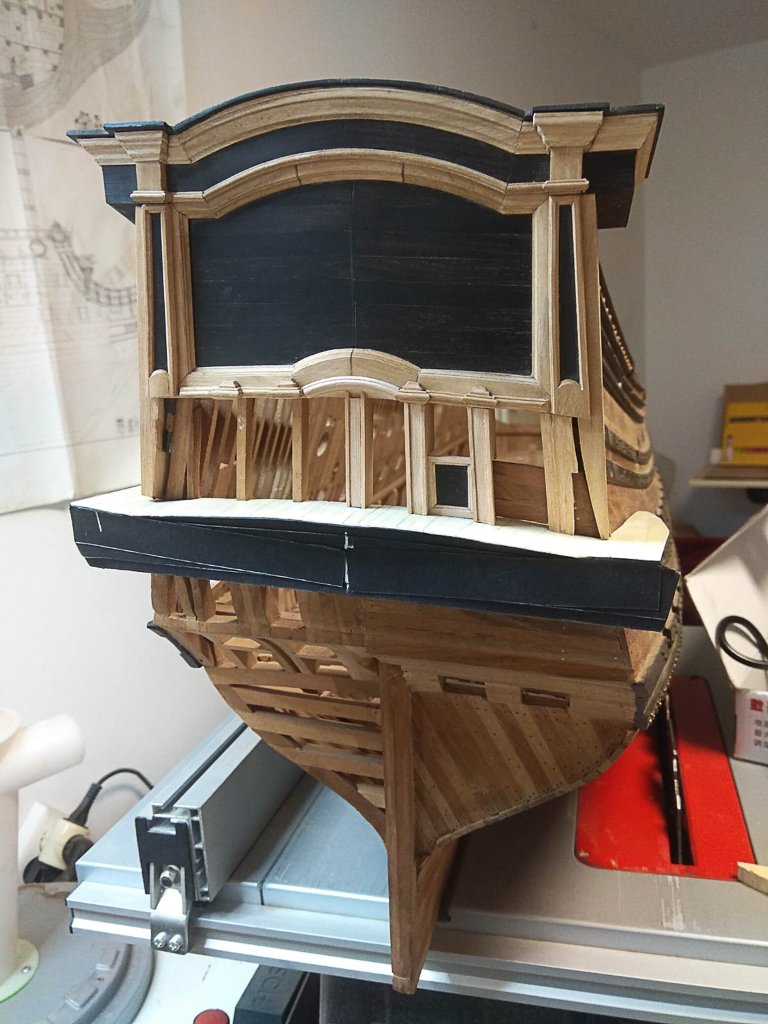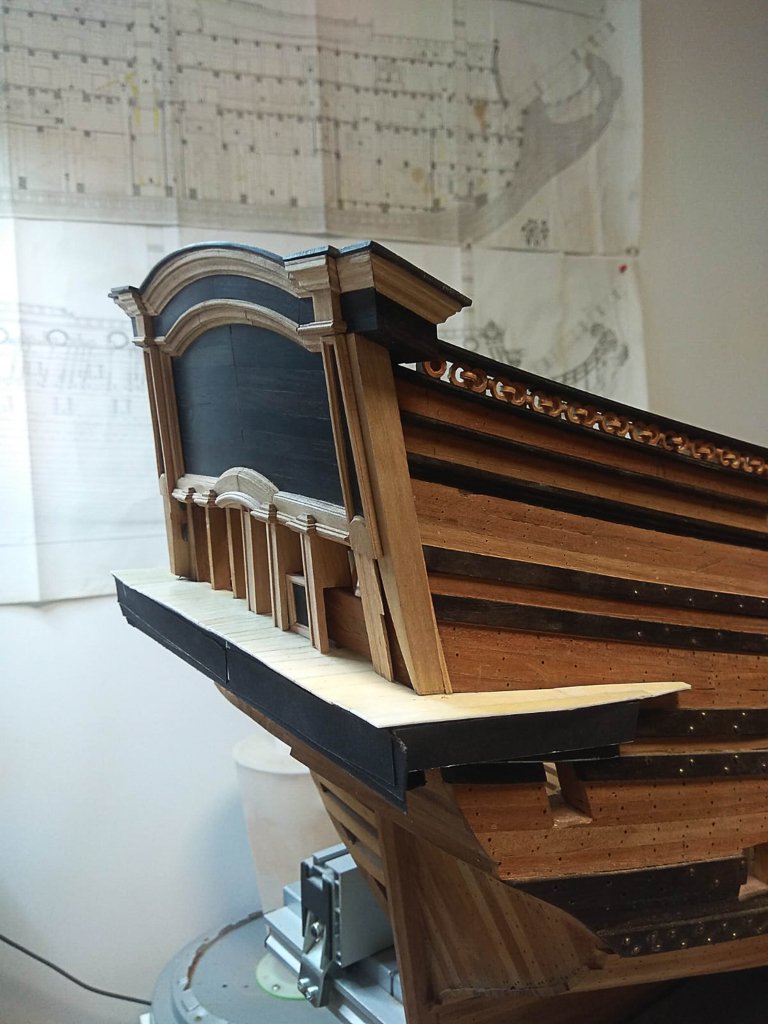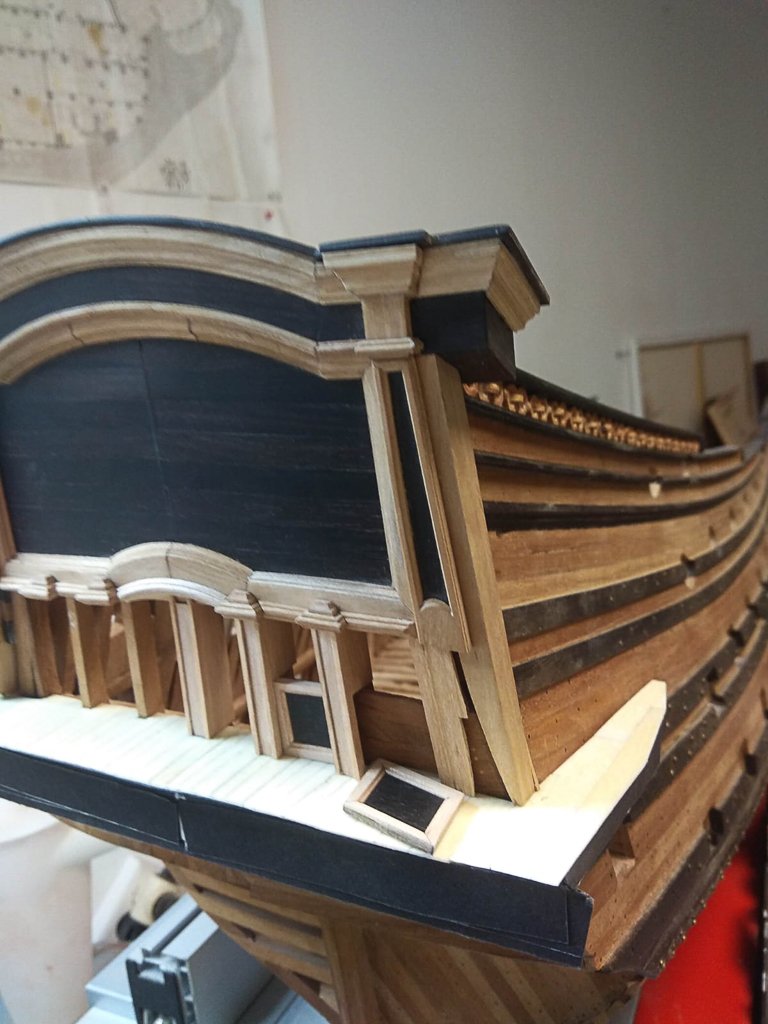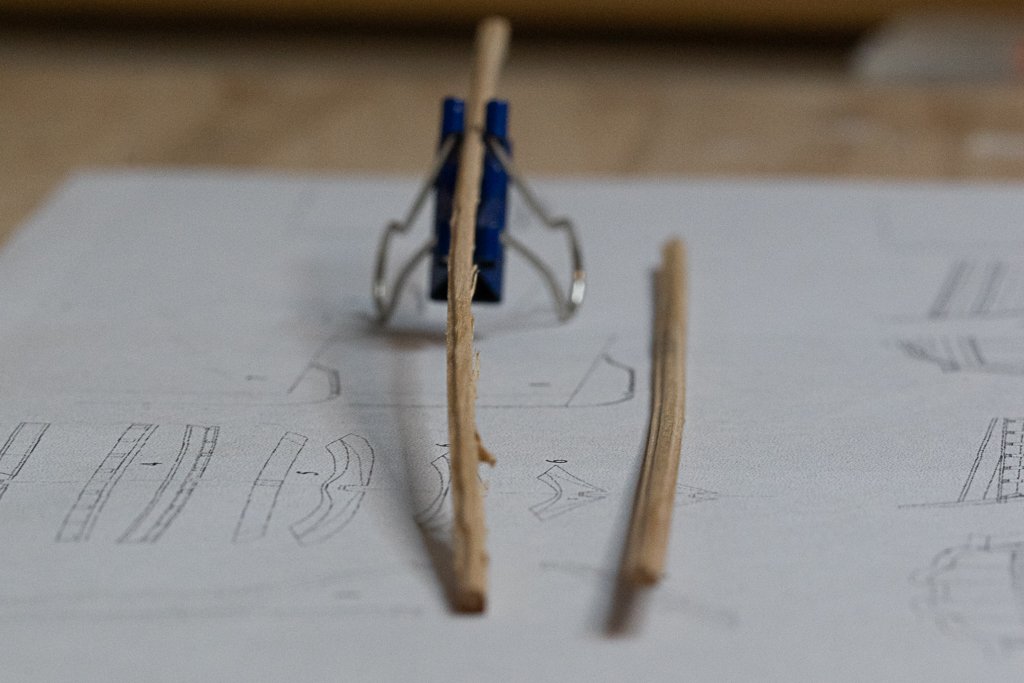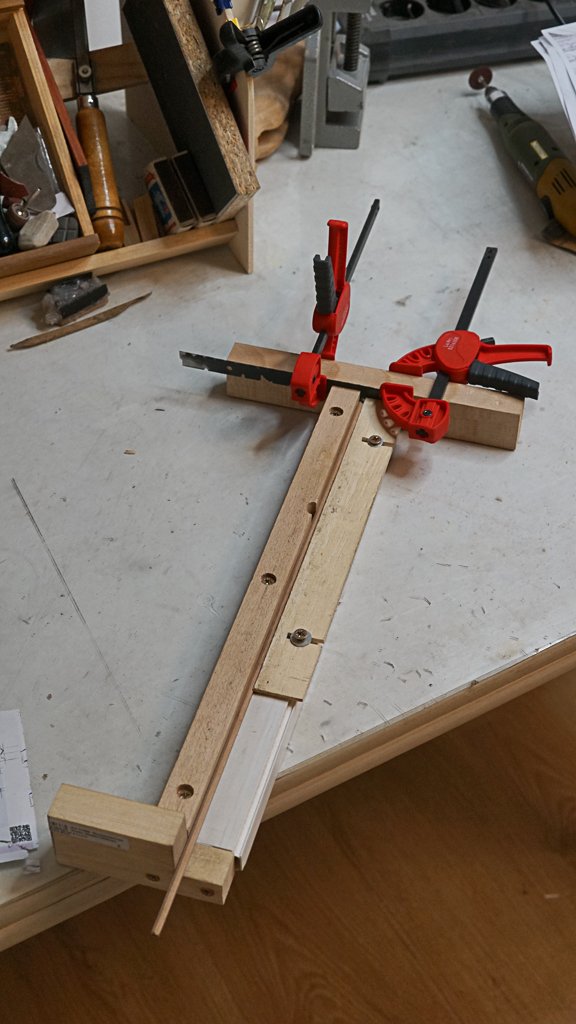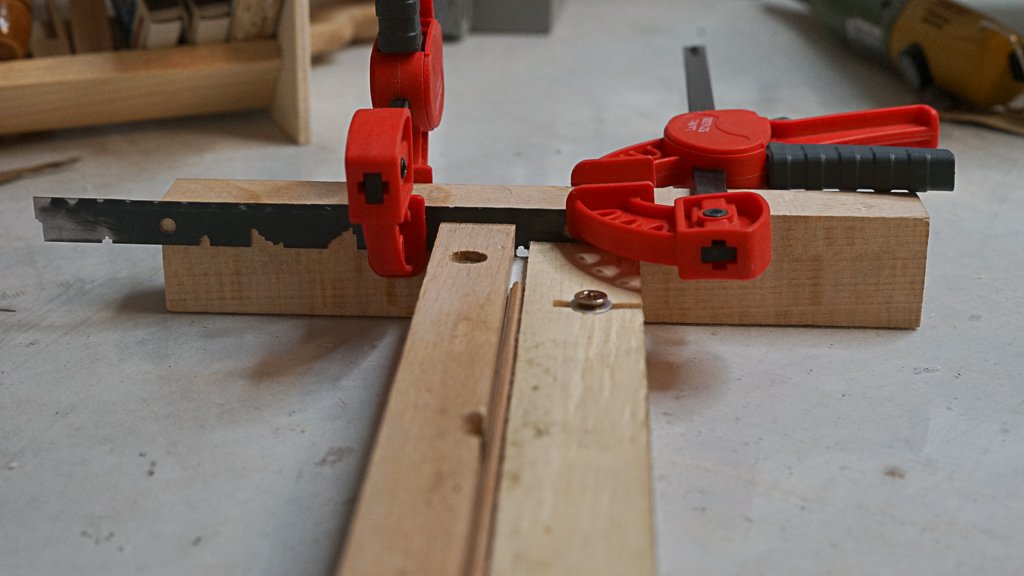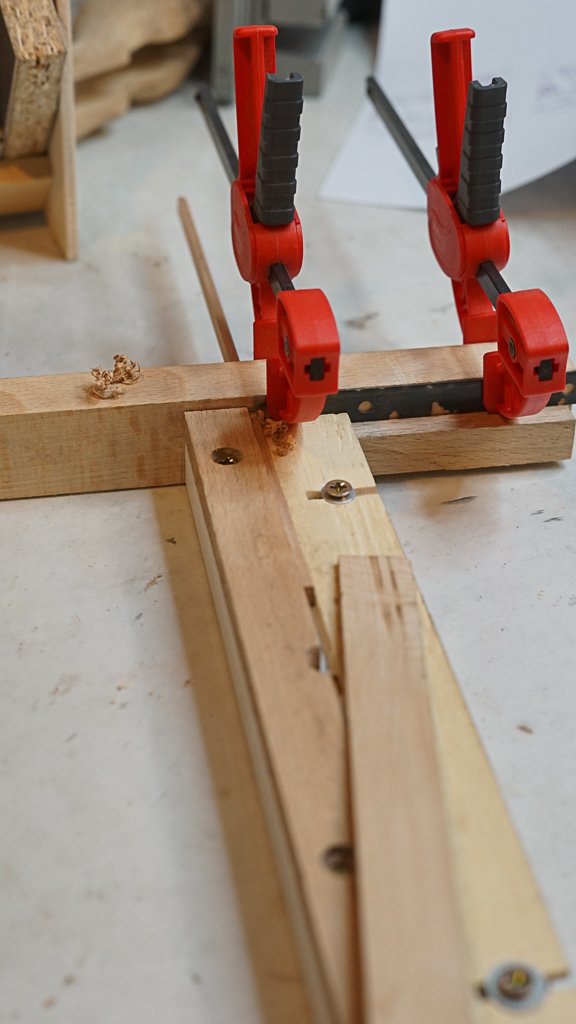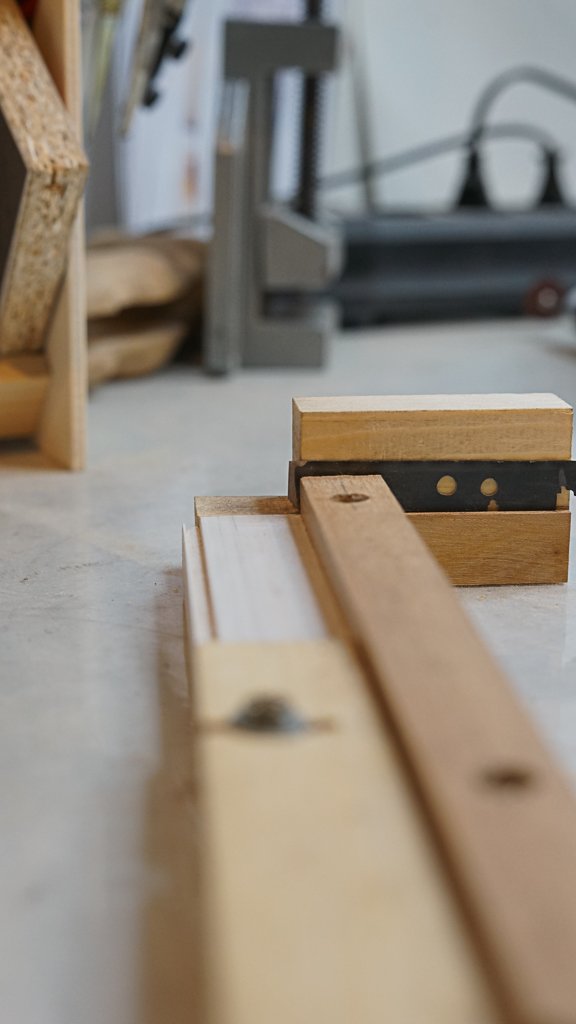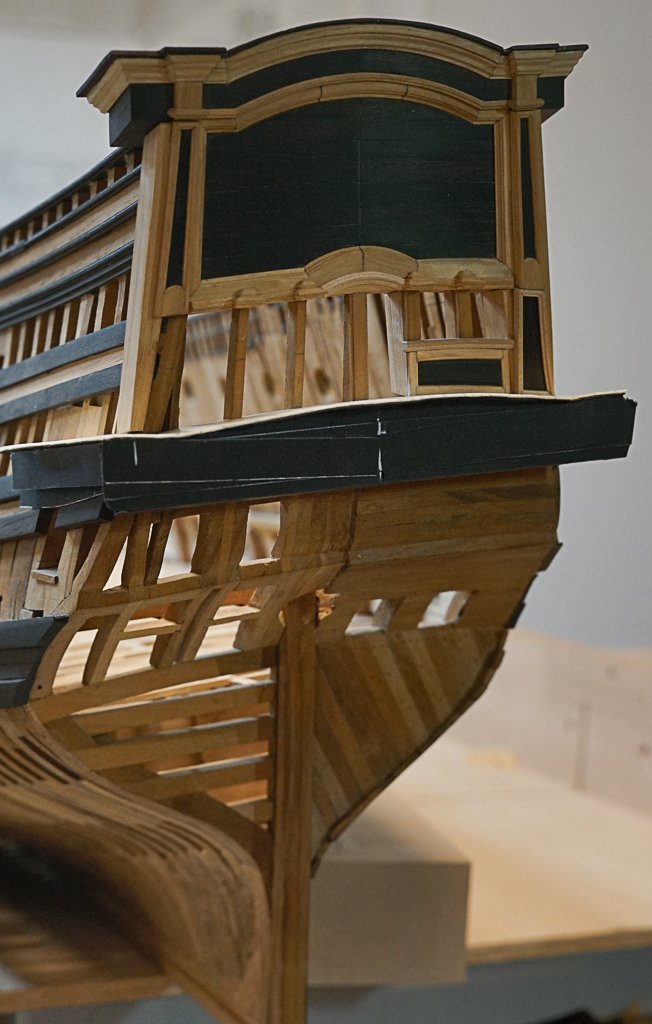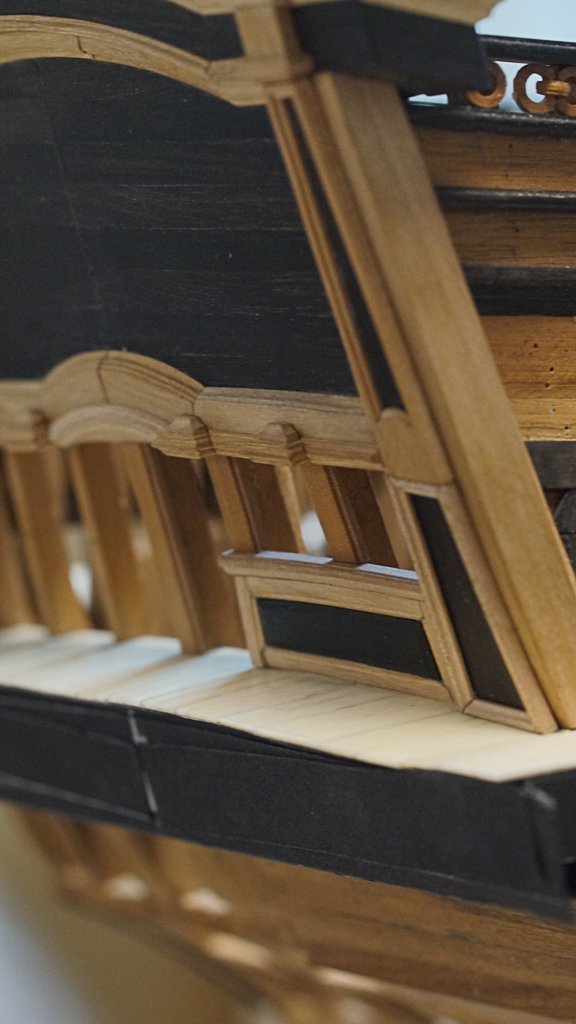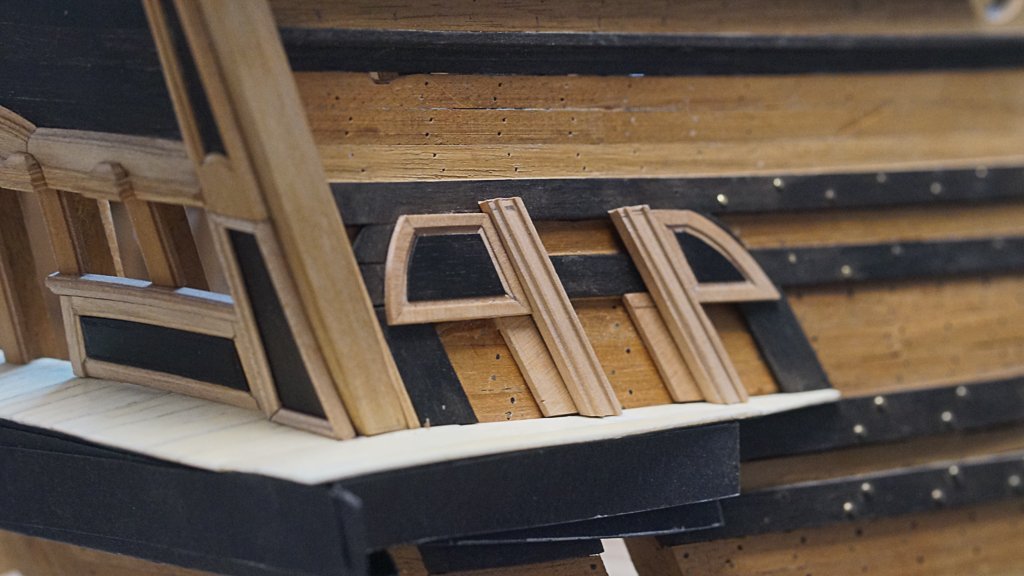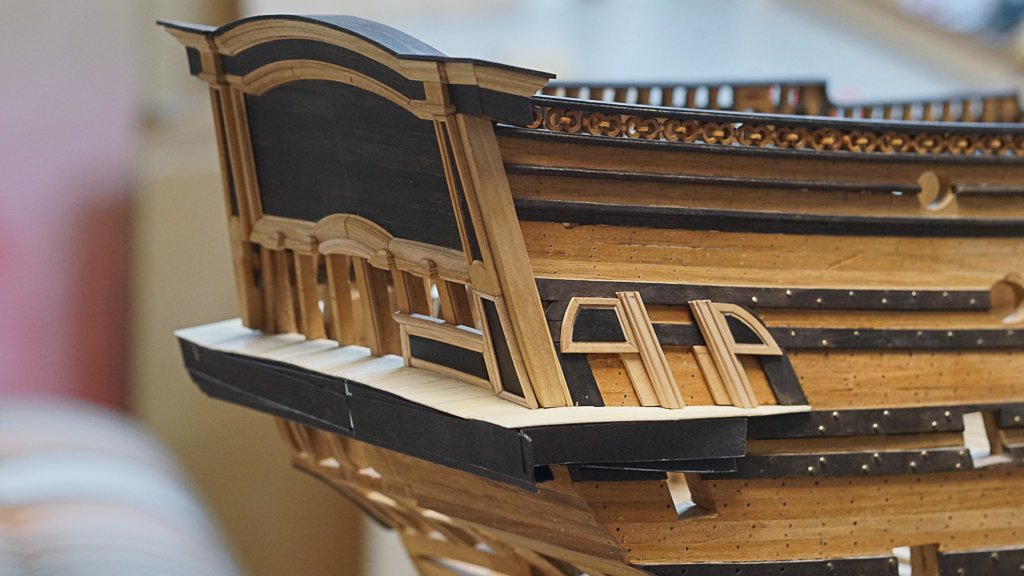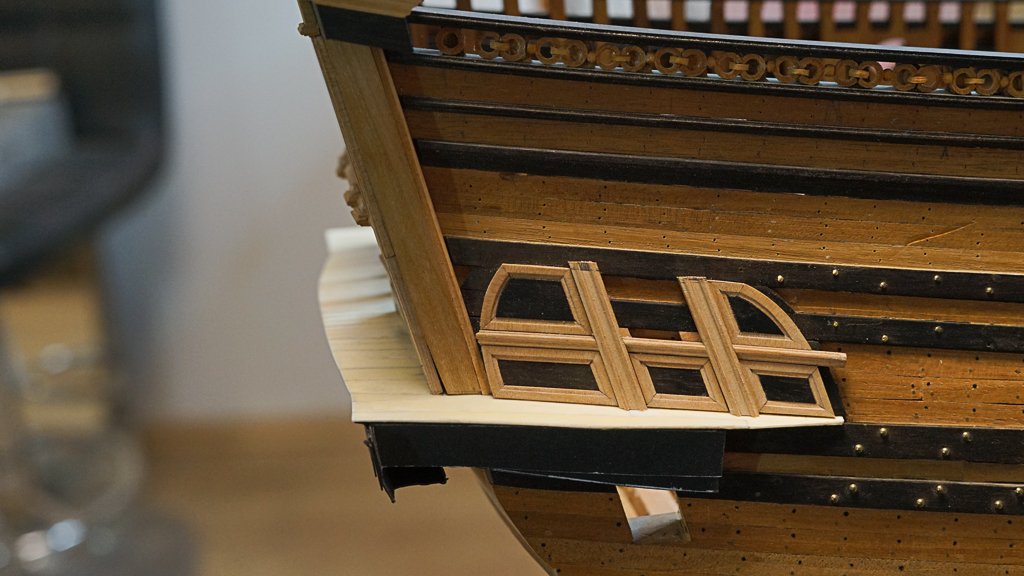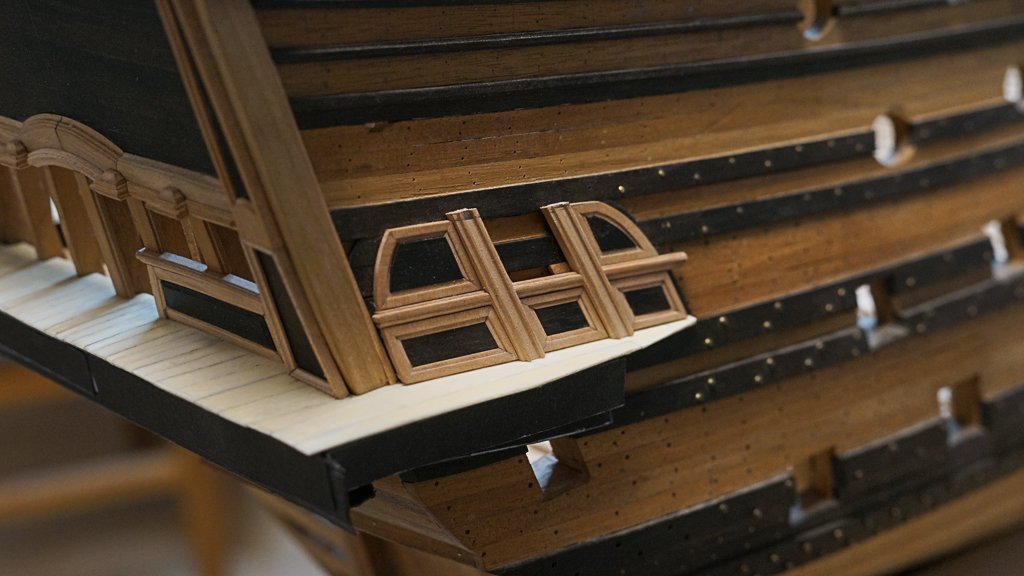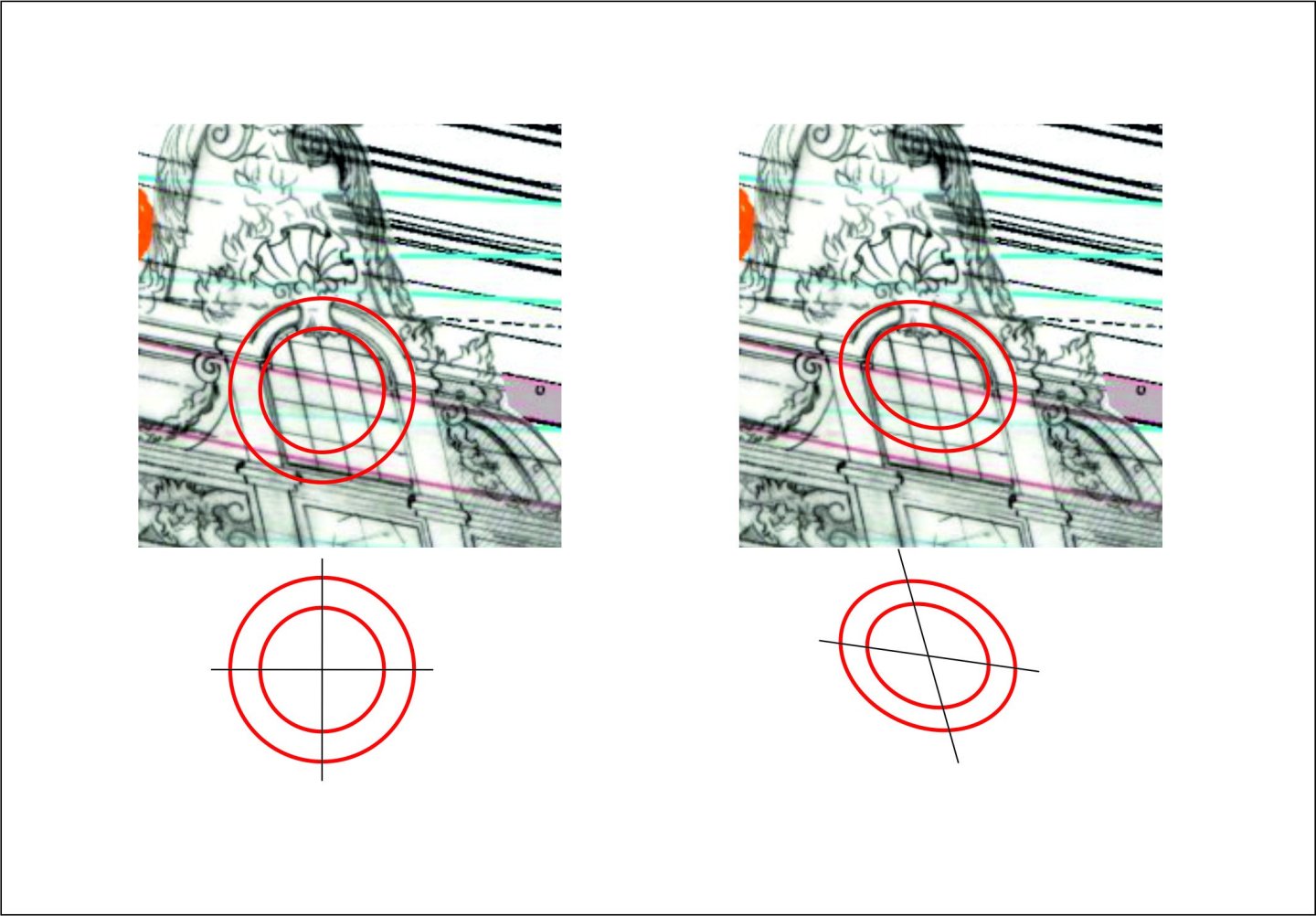-
Posts
297 -
Joined
-
Last visited
Content Type
Profiles
Forums
Gallery
Events
Everything posted by HAIIAPHNK
-
Good afternoon, everyone. I needed some outside advice and opinions. I am looking at a drawing of Beren and trying to figure out what exactly is depicted on the coat of arms. More precisely, I am interested in the frame around the circle with lilies. There are two tiers of some decorations, but it is very hard to see what is drawn there. (The two images are practically indistinguishable from each other. I tried to clean up the image a bit and sharpen the image. It is clear that the automatic algorithms of the program cannot restore the drawing, but I still decided to leave both images. Maybe someone will notice something useful). On the inner ring, in some places you can see an ornament similar to the letter S or a paragraph symbol. I don't know exactly how to describe such waves. On the outer ring the details are not visible at all. Only in one place (at the bottom near the central axis, but a little to the left) you can see some pointed outlines. Either it is a cross or a lily. But very controversial version. I began to look for similar images. What do French coats of arms look like. And the only thing that roughly resembles the drawing of the coat of arms on my primary source looks like this: The inner ring is very satisfactory to me. I have found similar ornamentation in other images. So most likely I will stop on a similar wave. But there are still a lot of questions with the outer ring. On the one hand, it looks like Beren has the same garland of heraldic signs. But I am confused that on the primary source of the 18th century the outer ring has not a uniform ring. It's looser. It's hard to describe in words what I see with my own eyes. Does anyone know what might be in there? What parts? I read once that the coats of arms on the ships meant not exactly the coat of arms of France, but the coat of arms of the armed forces. Hence the question, can there even be heraldic designations attached to a regimental military coat of arms that are placed as an addition to the coat of arms of the country? Then it would be a mistake. Maybe someone knows what can be advised? I want to do it right, and without being able to see the details well it is not easy.
-
Thank you very much for your reply. So many stories live equally in different countries. Some fairy tales some writers consciously translate into their native language. For example, such fairy tales as Pinocchio and Snow White and the Seven Dwarfs in the Russian version turned into the fairy tale "About Pinocchio and the Golden Key" and "The Tale of the Sleeping Princess and the Seven Dwarfs". And La Fontaine's fables were probably translated by Krylov. I don't know if they all migrated to Russian books from France or if Krylov made translations of different stories (not only La Fontaine's), and maybe some belong to him himself. I have never thought about this question. I only want to say that I have heard the fable of the Crow and the Fox since my early childhood. As well as many other fables. Quartet The Swan, the Crayfish and the Pike. The Monkey and the Spectacles The Elephant and the Moss (that's the name of the little dog). and many others. I've heard of the rosary beads. They are just made with this kind of device, and I even pondered whether it might be worth buying one. I wrote about it. The tagua turned out to have its own nuances, I doubt it would be possible to turn balls out of it with such a drill bit. If I were to make balls out of wood, that would be a different challenge. And it's unlikely that I would record the process. And tagua nut is less familiar and I decided to describe my first feelings and my experience. Maybe it will be useful to someone someday.
-
Thanks for the reply. Now I see in my imagination the whole construction of the dome and the decoration on it quite differently than I saw it all before. I am now more inclined to think that the design should be more flat. And I was trying to make three-dimensional details. I will now take time to reflect on what to keep and what I would rather redo. The easiest option is to just remove the ball part of the grenade. And the hardest one is to completely redesign the whole top part. I'll think about it. How dramatically things can change.
-
+ Thanks for the very helpful tips. The outside perspective is very important. I was planning to do another post in the future. With the grenades at the bottom of the dome. And these grenades I made exactly in the form of truncated balls. There's no other way to do it differently. A whole ball wouldn't fit on a narrow ledge. Now it's even lucky that the modified Kolobok will be with the others. The element with the winged Kolobok can either be remade from the existing result and leave the wings three-dimensional. Or you can completely remake and make a completely flat version, so that the wings lie on the planks of the paneling. Which is better? At the same time I want to voice one more question. I was planning to ask it later, but since the topic of conversation itself stopped on the Big Grenade, it will be right to voice my question now. There are small elements in Beren's drawing that I have my doubts about. And these elements also concern the grenade with wings. These are the small details I am referring to In the current state of the winged Kolobok, I left room for these details. So that they are placed at the back of the wings. That being said, there is no clear understanding in my mind of how these details should be done. I can't even tell exactly what Beren drew? What's in there? Or rather not. I see that there are bundles of lightning. It's an element found elsewhere in the decor. But here, I don't see the point of this addition. It just looks like random trash. And it might even be worth not doing at all. If you do, do it in a more active way. Like multiple beams. But I'm not really sure if that's the right thing to do. On the transom, the beams have not just a function of decoration. They, in my opinion, carry an allegorical meaning. They increase the significance of where they come from. A coat of arms with wings that glows carries a certain meaning. Is it right to give the same emphasis to the pomegranate? On the one hand those rays behind the grenade could simply mean explosion and in that way be appropriate. And on the other hand the rays can also mean the rays of Glory, which should only be with a very important symbol. I have similar doubts about the branches of laurel around the shell. In the picture they look unkempt. I do not see the point of adding them to the overall decoration. But maybe I am wrong? Maybe these branches should have some sense and it is necessary to leave them?
-
After your words, I saw my Kolobok in a different way. And now I too can see that a full balloon does not look good. I didn't understand your advice exactly. So please clarify. Do you think that from the back part it is necessary to cut off part of the circle, to make a truncated ball or hemisphere? Or flatten it out, make it an elipsoid? What do you think would be more correct and better?
-
Chapter 9 About the author telling a story and saying hello to Wilson. Now I'm going to tell you a story. It's called Kolobok. I don't know how to translate this word correctly. It's an ancient word that doesn't apply to modern life. The only thing I can say is that the morphological composition of the word consists of a root that means something round. Dictionaries don't have the exact answer either and there are several different explanations about exactly what it could have previously meant. And each of the versions could be correct. Or it could be a mistake. One of the versions of philologists says that the word kolobok called a small round bread or bun. And such a small pastry was needed to check the quality of flour or the correctness of the prepared dough. For me, on the other hand, from childhood, the word was taken as a name. The name of a character in this fairy tale. It is for the very young, its plot is short and without complex events. The fairy tale begins with the fact that the old man asks his old woman to bake a kolobok from the remnants of the last flour. And she fulfills the request. When the Kolobok is ready the old woman put it on the window sill so that it cools down faster. But Kolobok turned out to be not an ordinary bun or bread. It came to life. And decided to escape from the owners. So he jumped out of the window and rolled down the path into the forest. On the way he meets different animals in turn. First the Hare, then the Wolf and the Bear. And each animal, seeing the tasty Kolobok on the path, says that now he will eat him. But the young Kolobok easily escapes from the beasts. He feels agile, fast and brave. And proud of himself. He even hums a song in which he tells that he has managed to escape from the old man and the old woman, and after he has escaped from each of the animals, his song becomes longer. He adds a new verse where he describes how he escaped from each of the animals. But then he met a cunning fox. She did not say, like the previous animals, that she wanted to eat Kolobok. She began to praise him and asked him to sing her a song about his adventures. Kolobok lost vigilance and began to roll closer and closer to the fox. In the end he became so proud that he sat on Fox's nose. For this he paid the price. He was eaten. I do not know whether a similar tale exists in other countries. I have a suspicion that it does. For example, there is a Cookie Man in the Shrek cartoon. And I suspect that he is related to Kolobok. But I don't know that for sure. So why did I decide to tell a fairy tale? And why this one? Wait, the meaning will "pop up" in a couple of minutes. And now I will move on to the continuation of the story about making decor for the dome of the side gallery. Now I decided to make this figure. There have been discussions here before about these hand grenades. I have been carefully considering this large bomb and the smaller grenades below. It was important for me to understand exactly what is painted on these balls. Are they cracks that appear moments before the grenade explodes or is something else drawn. And no matter how many times I looked at these balls, I saw grenades. But now, when I started making them, I didn't see grenades. I saw a kolobok. And it made me laugh. I imagined that at the top of the dome Beren had placed a strange hero. And it's not just a Kolobok. It's a Kolobok with wings. Can you imagine how hard it was for me to work? My imagination kept coming back to this funny image. I was thinking about why a Kolobok with wings. Does it mean a dead Kolobok? Maybe this is where the whole story is encrypted? Does it show this character's "exploits" at the bottom? His successful escapes from his masters and the three beasts. It's all the same, isn't it? There are four little Koloboks on the sketch too, like his four victories. And if the winged Kolobok at the very top signifies some kind of resurrection, then the Fox must be hidden here somewhere. And the fact that she is hidden is also very allegorical and explainable. She is cunning and hard to see at once. Maybe the pearl shell is the Fox? This is her mouth, into which the naive and proud Kolobok fell. It is quite possible that there is another meaning here. In Kolobok's eyes, the fox was perceived not as a treacherous enemy, but on the contrary. She looked alluring and desirable, so much so that Kolobok himself wanted to approach her like a treasure ... And every time I started laughing at myself. I wonder what Beren would say to that. He'd think I was crazy. That's how a completely unrelated image can be easily turned into a wild, strange and funny theory. And yet everything matches, every element can be explained and crazy explanations can be attached to those fragments. So I was having a lot of fun. I started smiling very often, because every new look at the sketch brought me back to the story of Kolobok. And now I've infected you too. But it's time to move on from fairy tales to a story about work. Perhaps in response to my bizarre fantasies, the pomegranates decided to mess with my mood. I never thought they'd give me any trouble. I decided to make the balls as if on a lathe. To do this, I spent an entire day making a simple fixture that would hold my hand-held engraver in a rigid position. To make the engraver into the main part of the lathe - the motor and the chuck. The rest is self-explanatory. If one end of the workpiece is to be fixed in the engraver, then a bar with a nail clamps the workpiece from the back side. I even made a semi-circular scraper out of a metal saw that was supposed to become a cutter and make balls quickly. However, things did not go as I expected. The tagua nut did not want to be processed. It began to burn from the touch of my semicircular cutter. It would break off easily where it was attached to the engraver. I made several different attempts, tried to change the methods of fastening, sharpened a shaped scraper. But it was just as bad. This material was in no way suited for this type of work. So I spent a lot of time before I decided it was best to abandon the idea. I spent the rest of the evening wondering how else I could use a shaped blade. I guess you could call it stubbornness. Sometimes you want to get results no matter what the cost. How could I do that? I was rotating the workpiece and the cutter was clamped. And it didn't fit. What if I switched places? What if the workpiece was clamped and the cutter was spinning? Theoretically, it could work. After all, both methods are equally applicable in industries that make balls. Except that in my case I need to make such a cutter first. It has to be well centered. So it must be a drill bit. Or made from a drill bit. For example, you could resharpen a feather drill But I don't have one, I have to buy one. It would take too long to drive to the next town. I decided to look for such a drill bit on amazon. Maybe it would be easier. And since I found this site, I decided to see if there are already ready drills that are already made for making balls? I mean, it's even easier than remaking them. And I found. This was not a bad option. This is the kind of drill bit set used to make beads. In my case, I don't even really care that this drill bit leaves a hole for the thread. It doesn't bother me. On the contrary. My Koloboks have flames on top. I can put a nail in the hole, which will be one end put on the "fire hat" and with the help of this pole it will be firmly held on the Kolobok. And from below the nail can go into the socket prepared for it on the ship and it will also improve the fastening. So it is even good that there will be holes. But I still didn't have peace in my heart. First of all, it's not a free drill set. And I'd only need it for a few balls. And then it would just sit in a drawer somewhere. And secondly, I had more serious concerns. On my little lathe, the tagua nut reacted very badly to the blade. It would quickly begin to smoke. And there wouldn't be much difference in what was spinning: the blank or the blade. There's a good chance I'll get an unacceptable version again. And that's bad. What do I do? There are only two options: 1- to make a ball by hand, gradually giving chisels rounded shape to the blank, 2- to take a risk, buy and hope for success. And that's where the third option came into my head. If I came to the conclusion that the balls can be with a hole, I can conduct one experiment. I'll put the blank on a shaft that will be loaded into the engraver. And I'll try putting a bar of abrasive against the workpiece. I will be able to do this with short pressures to minimize heating of the walnut. This experience will tell me if the shape can be shaped with rotation. If even then, the walnut will darken, that will give a clear answer that there is no point in buying drills. To be honest, at this point I was confident that this method could help. After all, when I process the walnut with burs, it is the same process. And I can control the situation without getting it toasted. So it should work now, too. That's what I did. And indeed, the result began to show that this method, unlike the figure scraper, does not lead to rejects. I even got bolder and decided to speed up the process even more. I turned on my grinding machine and started shaping at a much higher speed. This, too, showed that everything was working as it should. So I abandoned the idea of buying any drills at all or making them myself. Yes, the drills could give clear dimensions. That was the thought I didn't want to let go for so long, trying over and over again to get around the problems. The method with grinding didn't give the same precision. I tried to make the correct shape, but you can still see that they have inaccuracies. I made the balls with a small amount of stock and selected the best fitting ones. In such a method, one can even find and excuse. For example, I could say that they were handmade, just like the craftsmen in the age of the Ludovics did. Since I found a logical justification for the theory that Beren encrypted in this ship the fairy tale of Kolobok, this version that handmade balls are better is quite a simple task. Well, now we can show off this very Winged Kobobok, too All that's left is to make the shell. If in the last chapter I talked about how much I liked the acanthus branches, now I will just as frankly say that the shell turned out to be the least favorite. From the very beginning, I had a strange emotion. I could not feel its beauty. And made it with a dissatisfied look. Maybe, of course, it was revenge from Beren after I turned his shell into the mouth of the Fox in my imagination. I'll add another point to the piggy bank of Conspiracy Theories and Phantasmagoria. Lilia showed in practice that the sketch was different from the three-dimensional design. Therefore, we had to adjust her design a bit. That's how the work on this piece went. Bear with me, I've already told you almost everything. It remains to show the last photos. In the last chapter I told you that the white color of tagua nut is not easy to look at, but even more difficult to photograph. And I had to adjust many photos to somehow pull out the volume, which looks very bad on the photo. This is where another problem comes in. I've noticed that when the ship stands in its normal position, it gives a better result in the photo. It makes sense. When the light falls from above, the shadows look natural. Here in these shots, for example, the volume is very readable. And when the parts were lying on the table, their appearance looked different, it was worse. But when the light came from above and not from the forehead, everything changed immediately. But that's where the problem comes in. The thing is that very many details are not yet fixed. The decor and even the construction of the dome and arch are all separate puzzles that are not connected to the model. I am working with them, or will continue to work with them in the future. I put the pieces on the table, measure. I do decor fitting after a couple seconds so I don't miss the right mating of parts. So I can't intentionally put everything in its place. When I needed to carefully place a couple of garlands, I did. Put a towel or something else soft underneath so nothing would get damaged in case of a fall. But there are too many parts now. Any movement that wasn't careful could set off a cascade of falls. So I turned the model on its side. So that the parts no longer have a chance of accidentally flying down. And now the light from the ceiling is shining on the side gallery right in the forehead, which immediately spoils the picture. I photographed each stage and realized with bitterness that you are not seeing things exactly as they really are. I can't give the picture that would be perfect. And now I suddenly thought, what if I turn off the light on the ceiling. And only what comes in from the little basement window would be left. And I'll also have a light fixture above the table, which is also by the window, to help me out. In this case, the model will receive light as if it were standing in a normal position, because the light from the window is drawn to it at almost the correct angle. However, there is a huge disadvantage that without ceiling light the camera does not get enough light and it swears and makes the frame dark. But I still decided to give it a try. Maybe I could pull out the imperfections in processing. I did have to mess around for a lot more time. But when I finished one of the frames, I was amazed. I was able to get a pretty good result. Here's a look at it. Still, how much the little things and nuances play in this world. I'm very glad I had the idea to experiment. It all started after I decided to talk about the peculiarities of white material. After that, my brain kept working on the idea and suddenly gave me the idea that there is another way to show white carving. I'm not even sure if this was a conscious action or if my brain gave me this idea without my conscious participation. For the sake of clarity, I'll put two similar views side by side. It feels like they are completely different works. The third and final photo is what the photo looks like without processing. As you can see, it took quite a bit to get a good result. The second photo differs from the first one by excessive smoothness. In a normal situation, such smoothness is not good either. But it was a forced action, there was too much "sand". But the most important thing is that the volume of white parts is well distinguished. And smoothing just eats such nuances, which give the volume of details. And this did not happen even after noise suppression. At the end, however, I went back and finished the rest of the Koloboks. And when I made the first baby I suddenly realized that now it was no longer a Kolobok. Now I saw a completely different image. Try to guess who I saw? I will leave time for your imagination and show you the answer a little later.
-
Thank you for the kind words. I planted the first parts with the laurel garlands on a drop of second glue on the plywood. But then I really regretted it. My jar of anti-glue was empty, I guess it was not properly sealed and the acetone just disappeared. So there was nothing to dissolve the glue with. I risked trying to peel it off with a thin blade. I was very worried that the whole piece might burst. But it came off all right. So when I made acanthus branches, I did not try to glue anything. I just tried to hold it gently in my hands. That's all.
-
Chapter 8 In which the author is gnawing on a nut and examining the branches. After finishing the flat part of the side gallery and its dome, I had to look for a new object to build. I told you in the last chapter that I was very happy to get back to carving. Even if it was just a small detail on the dome. I mentioned that I am now looking for areas that are better done before the balcony and its railings. So that this balcony is less in the way, and I don't have the fear that I might accidentally break something. It's a perfectly simple and logical thought, and anyone would do exactly the same thing. But now I thought there was a flaw in my plans. I had planned to completely build the entire structure of the overall ensemble. And then to do the decorating, covering the built structures with decoration details. And there's logic in that, too. But now I thought I could go the other way. When I become engaged in making decorations, I may again face the problem that in some places the construction will get in the way. For example, the same balcony will be an obstacle. After all, for the decor you need to take the dimensions qualitatively, then I will have to do frequent fitting, so that these parts are properly docked. That is, it will again be easier for me to do this work even before some of the structures. And this thought was a joyful one for me. Because it meant that I could continue working with the same second floor of the side gallery that I had just built. And I could get on with the carving. What a great thing to do! I mentioned earlier that on this model the decor was to be made of an unusual material. The customer wanted it to be made of mammoth bone or tagua nut. Earlier I described a little experimentation with these nuts. And now I had a full-fledged work with these nuts. This is a new experience for me. I have never worked with this material before. I've never "gnawed" on it. Moreover, I don't like to carve with power tools. I'm used to chisels and knives. And I even purposely try not to polish my sculptures. And I leave tool marks on them. And after working with a manual milling pen, you can't do without abrasive treatment. This tool leaves completely wrong marks, they need to be processed later. And when I take a milling handle in my hands after chisels, it feels like a log to me. I feel like this. So starting a new kind of work was exciting for me. Would I get the decor at the right level? But eyes fear and hands do. For the first time, I decided to start with these parts. It turned out to be not so complicated. I will allow myself to tell you about my first impressions. First of all, can tagua walnut be processed with chisels? After all, if i do not like power tools, why torture yourself? Maybe we should do all the work with chisels, if they are more familiar. In principle, cutting with knives is possible. But in spite of my attitude towards borax, I still won't do all the work the way I'm used to. Why not? You can't carve these nuts like wood. When you carve wood, you can cut large chips. But you can't do that with nut. You can work it very thin. You might not even call it "cutting the material", but "chipping". Nut is somewhat similar to textolite. It has short, thin flakes that separate when you cut it off. They don't just fall on the table, they fly off like bullets. And often I've caught myself thinking that this happens even before the point completely slices off the slice. It breaks off earlier. So this material is quite brittle. With the tagua nut, I have the ever-present thought that a small piece could break off much sooner. And I'd better not put any more pressure on it. It's hard to explain it exactly. The structure of the nut is strong and hard. And you have to gradually increase the pressure. And then suddenly, in an instant, there's a click and the flake comes off. The point enters the wood gradually. But in walnut, it goes in sharply. That's why it's easier to grind walnut into dust with a hand router than to cut it with knives. So I spent 80-90% of the time holding this handle. But it still had more pros than cons. The knives went on the attack occasionally. Most often it was the last stages of work, when I was tweaking something. For example, where it was necessary to remove the plowed surface after the boron, and it was impossible to reach this place with anything else. That's the feeling of working with walnut. And now what you got. The next details I chose were the acanthus branches on the sides of the dome. Having practiced on the simpler parts I wanted more complex ones. There was a whole other level of challenge to be tackled here. First, the decor now had to hug the frame molding and a groove had to be made on the inside. And secondly, the plasticity and movement of the branches should go in several planes at once. And at the top, these branches had to turn into very thin cilia. And this task was very interesting. I will tell you about one more nuance. The tagua nut has one peculiarity. Because it is completely white, it makes figures made of it look quite different from the way the same parts look from wood. The white surface steals volume. The decor appears flat. This is because the light is very much cut off from it, even in the shadows. The shadows look light. You can solve this problem by making sharper gradients between convex areas and hollows. Then more active shadows will remain in the depths of hollows and depressions, and the figure will look more voluminous. But I can't always do it this way. For example, the laurel garlands that I just made can't be done with this method. The piece is thin, there's just nowhere to place the deep depressions. So the white color of the tagua nuts has its own characteristics. In my case, however, there is nothing wrong with the garlands looking flat. It's even normal. If you look at the whole ensemble of decor, it should be varied. Some details should be more active. And they are made large, detailed. And other details should play the role of a supplement. Then the ensemble will be balanced. Just like in a musical ensemble or orchestra. Each instrument has its own role. So the acanthus branches, which I've taken up now, should be the parts that look more active. That's where you need to make deep depressions, so that they make these parts of the decoration volumetric. So I tried to make sure that the hollows didn't go too deep, especially where the channel for the dome frame was cut on the back side. It was very exciting and interesting. To combine all the nuances together: to make sure that the depressions were deep enough but didn't pierce the body through. To make the pattern of branches lively and logical, so that the viewer would not even guess that in this place it is impossible to go deeper. So that he would say: this is how it should be, it's a real branch. So that the delicate details don't break off. I can say that so far this is my favorite detail on this ship. I got a lot of satisfaction from working on the branches. I can say that my perception is not yet used to white decor elements. I'm used to more classic materials. And so far this option looks controversial to me. But I like these acanthus branches so much that I can't imagine them in any other material. The white glowing light of the tagua nut gives a special look. In the future, when more and more details will appear and the white color will become more common, I may revise my opinion of this style. And then I will write honestly about what I think, just as I write honestly about my thoughts today. And that will conclude this chapter. There's already a lot written in it. And the story about the rest of the dome decor details will come a little later. Oh yes, I forgot about the photo of the finished branches.
-
I decided to add my own pictures to yours. This is my experience with the neural network. It will be necessary to add a story here. In my thread about carving and project with lions on one of Russian forums the conversation turned to one curious topic. There is one ship in the history of Russian shipbuilding. It is called the “Eagle.” And this ship is considered the very first ship of the Russian fleet. It was with him that the birth of Russian naval history began. So it's an iconic ship. But there's a huge problem. All that is known about this ship generates huge disputes and theories. Only small descriptions of this ship have reached us. In this case, the Old Russian language has its own specificity, many words now sound quite different from what it was in the distant time. In addition, then there was simply no clear and precise marine terminology. The person who described the appearance of the ship used such words, which are difficult to interpret unambiguously. Which adds gunpowder to the debate about what this ship might have looked like? So we know very little, the ship was built under the direction of visiting Dutch craftsmen and that is the only starting point. Everything else is very vague. Among other things, the description says it was decorated with a lion. And it is this lion that has been the main topic of discussion in my thread. People have put forward their own versions of what the lion on the Eagle might have looked like. And even if you take the rest of the ship out of the question, this figure alone caused heated debates. How was this sculpture placed? Was it vertical or was it horizontal, as on Vasa? From historical documents we know that the main master during the construction was a Dutch specialist, but it is also known that the sculpture was made by Russian sculptors. So what did that lion look like? Russian depictions of the lion had some laws, Dutch lions were carved according to other standards. Did the glorious master specify what the Russian carvers had to do, or did they have free rein? And in general, if the main figure was a lion, and the ship was called “Eagle”, should it be somehow taken into account? Should the image of an eagle be present on the ship? Maybe the stern was depicted with this bird? Or maybe the lion held a shield in its paws and an eagle was depicted on it? There are so many questions. This is a very creative question. No one can give a definitive answer or offer a valid criticism. And it was at this very moment that the vogue for neural network-generated images reached me. I wondered what a computer brain could offer if given the command to show a lion on the Eagle ship. And these were the results I saw. I didn't play with this idea for long. Very soon I realized that the computer was not capable of doing anything that could make me happy. I watched some tutorial videos, where they told how to enter more correct queries and realized that I am not interested in spending my time on it. That was the end of my story of communication with the neural network. I don't remember where exactly I heard one interesting expression: “You have to pay for everything in the world. Even for the opportunity not to pay!” It's an interesting expression. In this situation it is somewhat suitable for this situation. At least the main idea has the same direction. We're used to the idea that the neural network does everything for the person. But despite the fact that a person who cannot hold brushes and paints in his hands can get a picture with imitation of oil painting, it is likely to be of value next to zero. For a good result, you need to have quite a bit of experience in other subjects. And an art education comes in handy too. So you still have to “pay” in the end.
-
Hello, empathry. I may not have been able to grasp the full meaning. So most likely I will answer past the target. If I am not making the right comment, I apologize. I don't understand why you put two different aspects together: making models by people using computer programs and machines and creating pictures with the help of Neural Network. They are completely different things. Certainly the pictures you have shown make people laugh, especially people who know what sailing ships really look like. A huge number of people won't even notice the silly places in those images. If you look, for example, at computer games with a maritime theme, there you can see even more stupidity. And after all, they were drawn and modeled by people. In many movies there are even more anachronisms. And this applies not only to ships. In any subject there is a huge number of errors. Historical movies resemble clowning. Decorators and directors often do not even try to look in textbooks, go to historical museums. That's what's really offensive. And if this is what people do, then what can we expect from a neural network, which takes analogies from the network and looks at what a person has drawn or made on the subject. It's not fair to mock algorithms in this situation. That's the first thought. The second is that the neural network is a new tool. And it is also controlled by a human being. I am not an expert in this field and may be wrong. As far as I know, to create such pictures, a person creates a description and the computer relies on this task. And for a good level of the picture it is necessary many times to sift out errors and give clarifying data. It turns out to be a paradoxical situation. A person does not draw himself, and he does not spend his time on this process. But he spends his time anyway, so that after a long series of mistakes and corrections he gets what can be called a good result. I will tell you a story I have learned about creating a neural network. Did you know that you were also involved in its training? Yes, I did. Have you come across captchas on the web? Remember that they used to look different. There used to be letters on the screen with fuzzy elements, blotches and other defects in their appearance. And you had to write the correct letters. And then at some point the captchas changed. You didn't have to type the letters anymore. You had to look for bicycles or traffic lights or something in several pictures. There were also some really weird captchas. I was particularly amused by them. You just had to check the box next to the inscription that you are not a robot and click OK. And that was it. And it was not clear to me why such a stupid task. So, all of these captchas used humans to train a computer brain. The first kinds of AI were created to search and sort information. For example, for a computer program to convert scanned texts into electronic form. And this algorithm ran into a problem. The program's brain could not recognize those letters that had defects, fuzzy elements. After all, the defects are always different. It is necessary to introduce such a huge number of different kinds of any one letter into the algorithms that the algorithm would have a huge base of different variants. And for a programmer it meant a hell of a job, just to sit and search for letters with defects. One can't do it alone, you need a lot of employees. And even in this case it would take a lot of time. And all such people need to pay a salary for such a boring, but necessary work. And then an ingenious way out was invented. It was easy to find people who would teach the program for free. And such free employees became us. All those who have to fill in captchas. The program gave us those letters that it did not understand, and we entered her translation, indicating what letter is actually depicted in the picture. The same scheme works for captcha with pictures. We teach the AI what a bicycle or something else might look like. Even when we just click on a checkmark, we are also teaching the computer. It's looking at exactly how the cursor moves across the screen. I don't know if this is bad or good? How useful is it that in our world computer programs copy people? There are a lot of different problems being solved with algorithms now. I talk to doctors a lot. And it scares me what I see. I talk to a person, he asks me about my symptoms, writes them down in the computer. He takes my labs and they go into the same “box.” And then this “doctor” just reads the recommendations from the screen and announces to me the pills I should take. He doesn't determine the treatment either, he just reads what the computer has written. And what scares me is that the man himself becomes an attendant. He's just needed to do some of the work. And not the most important one. For now, it's much more profitable to use a human for this purpose. And what will happen then? I already face such cases when I see incompetence of people. One “doctor” argued and proved to me that my liver is in a different place. And it's a good thing they found it at all, or didn't turn out to see it in my heel. Other “doctors” tried to give me an electrocardiogram by attaching contacts to my sweater. I'm not kidding, it's true. And yes, my sweater is dead, that's what the diagnostics showed. And that's what makes me happy, now I wear it in peace. I'd be scared to live next to clothes that have arrhythmias. And your funny pictures just show that we live in a world where people are used to accepting something approximate rather than an exact result. That's scary! These pictures were uploaded online by their author. This means that he himself liked them. And he considers them to be a result that is already suitable for showing to others. But this is no different from other similar cases. We go to the movies and don't pay attention to the huge number of clichés. The Chinese must have dragons, Russians must have bears, France always and everywhere has the Eiffel Tower on the horizon. And so on. Recently, I decided to watch the movie Napoleon. I was interested in seeing the French decor, even if it wasn't exactly the period that Fulminant refers to, but it would still be interesting. And it made me want to cry and laugh. It was a complete mockery. The historical events, the personalities. It had nothing to do with computer algorithms. I wonder what these same pictures would look like if the programmers had selected the right ships. What would happen if we could teach the neural network to read at least some of the ship's books. For example, input Budrio's data into it. Show what ship elements distinguish a French ship from an English or Dutch ship. What is the difference between an 18th century ship and a 16th? But alas, this is only talk and dreams.
-
What a brilliant idea with the marker. I thought I was the only one who had trouble blackening brass. And here's such a great idea! Thank you. It's a great morning today, a chance to look at beautiful work and a beautiful ship. And to see some great advice. It's a great day!
- 2,696 replies
-
- heller
- soleil royal
-
(and 9 more)
Tagged with:
-
Thank you for the high praise. I see that the photo makes visible what the eye in ordinary life does not notice. And I see a lot of inaccuracies. Maybe I'll even try to make another attempt so that I can't be picked on in a macro photo as well. For me this is the ideal. And I have something to strive for. There are such masters who delight with their exceptional accuracy. And at the same time I want to say that if you can see mistakes from the outside, you can safely talk about the problems that you have noticed. I will of course first curse anyone who sees mistakes and says that my work is far from ideal. Perhaps I will run around the computer for a while, show my tongue, beat myself with my fists in my chest and show my dissatisfaction in various other ways. But soon it will pass and I will definitely start listening to criticism. Alas, such behavior is the norm for almost every artist. It doesn't work without it. That's why I warn you in advance, so that you are ready for anything. The main thing is not to be afraid at such moments, not to show your fear of my grimaces and shouts and not to make any sudden movements. You may not even look me in the eye, sometimes that helps too. Remember, you are at a safe distance. I have rarely had time to run to people who criticize me who are more than 100 kilometers away from me. More often I've managed to cool off on the way. So that should be a calming thought too. And it's also important to realize that pointing out my mistakes is very important. Because there is a possibility that my eyes may get tired and not notice the mistake. Which means I might notice the problem much later. So after a tantrum, I'm pretty much 100% thankful for the advice. So criticism is really important to me as well. Almost as important as praise. Although who am I trying to kid? There's nothing better than praise. Thanks!!!!! THANK YOU!!! I'm also very happy that you're interested in reading my stories. It is also an important part of my life for me. I am not good at short stories. And I am very glad that the translator keeps the possibility to understand my stories and even the humor.
-
Chapter 7 (unplanned). About how the author reflects on time and finally gets to the main thing. As I said at the end of the last chapter, the original plan was to put the issue about the side gallery dome in one issue. But then I decided that it would be better to split it into two parts because the text was too long. It was too tedious to type a large text. And even the online translator began to hang, swear and complain. So I decided to publish half of it before the translator completely destroyed everything I had time to translate. In the morning, when I decided to continue publishing the story, I thought of one nuance. And indeed, it is now the last days of May. Just a moment more and summer will come. Which means that about a year ago and took up this project. And I saw it as my usual carving work. I put my lion projects on hold because now was my chance to tackle new ways of carving. Except that in order to start carving for the Fulminant, I'd have to prepare a bridgehead first, build the stern of the ship. I expected it wouldn't take me very long. And what happened? It's been almost a year and I'm not even halfway through building the stern yet. I have the most challenging design and fabrication phases ahead of me. When will I get to the point where I can do the carving? And that realization was kind of scary to me. It told me that I had misjudged my strength. And one has to accelerate a lot to keep this project from becoming a perpetual thing. On the one hand, doing what you love and building a ship is wonderful. I certainly don't dare to start building my own ship. And this opportunity to do the ship is ideal. If I enjoy it, then let it go on for as long as possible. But at the same time, the thought makes me very sad. If it were my own project, I would not rush, but rather stretch the pleasure of each stage and each new task. But I made a promise to the customer. And I've already broken it. I've missed deadlines. And it's always weighing on me. Also, as much fun as it is to build the stern structure, I get a sense of longing when I look at the lion figurine I've put aside. When will I get back to this project? So eager to get back into carving again. I really miss the process. And now, while finishing the dome structure of the side gallery, I realized my dream of returning to chisels and cutters. But first things first. I put the arch in its place and began designing the rest of the dome. On the historical sketch this element is drawn loosely. And this drawing can be represented in the finished design in different ways. I was faced with the task of making the design look realistic and at the same time not too different from the original. There were a lot of questions, for example, how to make the dome look three-dimensional, because in fact it is a flat part. Or what kind of materials to use so that the end result would be a balanced combination. Some time ago I already tried to rebuild Beren's drawing into my own version, and they differed from each other, as the ship's hull and the historical drawing had many differences. So now I was faced with having to make changes for the second time. I was not quite satisfied with what I had drawn once. I needed to look at certain nuances in more detail. For example, I came to the conclusion that I should change the original shape and size of the false window. The painted version now looked too big compared to the windows on the stern. And I didn't like it. I also decided to correct the dome and make it smaller. Unfortunately, I can't show photos of intermediate stages of production. They just do not exist. At this point, my son left for a few days on a small trip with friends and took the camera with him. And before that, I broke my phone, so there was nothing to take photos with. So right after photos with paper templates will immediately follow photos with already finished dome. This picture is the only one that can be called intermediate and working. Here I glue the inner part into the frame. At the same time I will explain a little what is this strange bar, which “stuck” to the dome. I made the frame of the dome the way it would be made in life. And in a shipyard, it would be assembled from several separate segments. And the sides would be made of separate boards. And because the joints are so small, it's easy to break off when working. So I glued a temporary strip on top of this joint, which gives additional rigidity. So now it will be a little clearer to look at the following shots, where you can also see this temporary detail. And this is how the dome looked after I removed this temporary stiffener.Now there is no point in it anymore. I've already done all the work, so it's not so dangerous to accidentally break off the gluing point. Besides, now the inner field has taken over the role of a rigid base. And the frame will be safe. And now for a historic moment in the history of this project. I have finally gotten to the stage that can be called carving! Yay! Opening the champagne, setting off the fireworks and dancing on the balcony! 🙂 And the final frames are now left. This too can only conditionally be called a finale. Other elements with decorations will appear here in the future. But these details will be made of another material, not wood. So it will be a different story. And I am finished with the wooden part at this point. Carving has appeared so far in a very small form. But it is even more logical to begin with. The first appearance by all laws and should be small and insignificant, like a fresh sprout. Some time will pass and it will turn into something more significant and big. Maybe even like a huge tree. Hopefully my story too will someday be filled with carvings that will finally become many and will finally become the main theme of this story. We'll live to see...
-
Chapter 6 which will talk about the power of advice, and the author calms down and even rejoices. But it's not accurate. When I was a student, there was a guy who went to school with me. In the course, he played the role of the joker. He was always cheerful and would drop jokes and witticisms on every occasion. With such an easy to communicate, but he was irresponsible and even lazy, often took his duties not seriously, from which he himself and suffered. And the other students at some point realized that it is better not to rely on him, he could easily fail. People can be like that. I remembered him now because at first many fellow students tried to correct him, to press on his conscience or to show that his not serious attitude could bring him problems. Usually at such moments they would say: Sasha, I want to give you some advice. And then he would turn the conversation into a joke and answer: - “What a country of Soviets. Well, give your advice. (play on words: Soviets = advice) After that, someone would wave his hand and decide that there was no point in trying to make sense out of it. Someone still expressed his opinion, saying that Sasha does not do right. But often after the advice, our cheerful fellow student would make another joke, again showing that he was not in the mood to dramatize the situation. Eh, don't worry, everything will be fine. Ever since my student days, when I hear the word “advice”, I remember this classmate. I remembered it now, because after this introduction, the conversation in this part of the story will begin with advice. And these tips I asked other forum members. Because I could not figure out how to make a molding in the form of a curved ellipse. Now I am already surprised, because the solution was simple and obvious, even strange, how could not guess? But I was really stumped. And the decision to seek advice was a good one. So I want to say thank you very much for your active participation and good advice. In this thread I often ask for help, and always get good discussions that help in working on the ship. And now I will show you what I got. This is the template I got. Maybe I could have made it out of brass with less thickness, but I was afraid that the template could deform when working. Thanks to the advice I immediately paid attention to the fact that when making moldings there are two options: 1- to fix the template with the workpiece stationary and hands to move the scraper; 2 - to fix stationary scraper, and hands to move the template. Since I didn't know which option was better, I decided that the template should be such that it fits both options without problems. The holes around the edges will allow the template to be fixed stationary. They may also be useful in the 2nd method. Since the template is not that big, it may be difficult to hold. In this case I can screw some kind of rail to the template, which I will use as a handle. At first I tried the 1st way, but then I changed my mind and fixed the scraper stationary. I can't give a definite answer as to why I decided to do it this way. Most likely both methods can do the job. But for some reason I felt more comfortable moving the template. I fixed the scraper primitively and not beautifully, just clamped it between two bars. Like this. Here is a photo of the very beginning of the process, a little later I added another addition to this primitive clamp for the scraper. Even more primitive. Almost at the very tip of the scraper, I hammered in two nails. They gave even more rigidity to the scraper, it did not sag from the pressure and this addition was enough for me. As you can see from the photo, I did not attach to the template and lath - handle. It turned out to be quite convenient to hold the template in my hands. And after a while I got a molding in the form of the necessary shape. The arch should continue I the form of straight sections, so I immediately with the use of the same two scrapers (outline of the inner part of the molding + outer outline) made and straight sections. On the same my depot for the moldings I have already shown. All that was left was to put it all together. This is what it looked like when finished. I particularly enjoyed adjusting the tiers on the straight sections. I made the gap at the arch on purpose. According to my idea, the window frame will be placed in this niche later. Of course, it could have been done differently, but this gap will simplify several problems at once. At first I thought about how to properly describe everything in my head, but then I changed my mind. When the stage of work is up to the window frames, everything will be easier to understand from the photos. Much easier than my explanations now. I will emphasize the main thing: the gap at the arch is made on purpose, it is not because of my crooked hands and blind eyes. Do not throw rotten tomatoes. Hmmm. I sincerely thought I could fit everything into one post until the end of this little object. But now I'm looking at how much I've written, and I think it's best to stop there. What words will I leave as a conclusion? Last time, I wrote about how a lot of things didn't work out for me the first time. And I was dissatisfied, even annoyed. Now I felt quite the opposite emotions. Throughout the work with the molding-arch I enjoyed it. When I thought about how the final design should look like, how I will then insert the window frame here, when I made a template, when I put all the parts together. And even when I was preparing this post. I guess it's all about spring. Although, wait, it's almost summer already!
-
Yeah, that's what I'm doing. It's hard to do anything differently in this process. Only if you do it with your eyes closed. Or if you try to squeeze the scraper all the way in right away. But you have to be very persistent and have the strength of the Hulk to push through the wood at once. But nevertheless, I suddenly started to get rejects. And it wasn't just one lath that turned out to be of poor quality. There were several. That's why I decided to look for another option. I agree that it is too complicated. It was much easier to just look for a more suitable material. But it turned out to be an unusual story. Without the adventure with moldings, this post would have turned out to be an ordinary set of photos with the result. Maybe it should have been done that way. But I wanted to share it.
-
Winter has not been easy for me in recent years. It is during this period that various problems pile up. And they “knock me out of the saddle”. And this winter was no exception. Therefore, in the winter period of time my shipyard on the table covered with cobwebs and dust. But fortunately with the onset of spring the work there began to come to life. So after a long break I have something new to show. So far it's still small steps. All that I will show are minor changes. But the ice after winter doesn't melt in a minute. I'm happy with this pace. That's the introduction. And now after the introduction, you can write something like this: Chapter 3 (or 4, or even 5). in which we learn about the balcony windows, the crooked moldings, and the author is furious. I finished work on the big screen on the transom of the ship, on which the crest with wings should appear in the future. And now it was necessary to go lower and deal with the decoration of that part of the transom, which is on the second floor of the officers' rooms. Where the balcony is. I thought this was the easiest part of the whole transom. It would be perfect for “warming up your hands” after a long break. But it turns out it's not that easy. And the easy ride I was expecting didn't work out. I couldn't figure out the best way to make the shields and screens under the windows and the columns between the windows. I won't list everything, I'll just say that I didn't like some nuances and others. And I had to remodel several times. I will show only one of those variants, which were. It was also a very ugly design that I had to remove completely. I don't even remember exactly how many attempts there were. And now I'll move on to another problem. I need to make moldings for my job. A lot of them. This is the most basic part that is required all the time. They are used to make the edging of shields with fillets. Moldings decorated the joints between the parts. And so on. I made them with the help of a figurative scraper. The technology is so old and familiar that there is no point in describing it. But now when making moldings I faced a problem. Very often they turned out crooked, the pattern of the profile was not even along the rail, it resembled a drunken snake, which in addition still hiccups. In the photos, you can even see that the scraper cut into the lath during the movement and chewed off its side wall. The reason for the defect in the moldings was most likely due to the wood. At least it seems that way to me. I think that the laths I made as blanks were from a board that had too wavy fibers. And that wood grain kept the scraper from going straight. The fibers had different textures, next to the area with soft fibers were places where the wood was harder. So it was easy for the scraper to go sideways and cut the wrong areas. I primarily wanted to show how crooked the pattern is, that it doesn't match the rail. To be honest, I was very surprised when I got the discarded laths for the photo shoot. They had been lying in the garbage can the whole time. I didn't see them after the milling itself. And now it was a big surprise to me to see that the slats themselves had become crooked as well. So this again suggests that the problem is most likely poor quality material. From the same log I carved an English lion. The carving satisfied me. But as a material for thin laths this blank already showed a bad result. What can you do, wood is a living material. From the same billet I made moldings for the transom. And there everything was in order. The remaining laths are still even. But here the result is quite different. Wood is not metal, and not plastic. It has its own character. Although I may be wrong. After all, the laths were lying (exactly wallowed) in the trash. The rest of the trash that was lying on top could have also affected the warping. Maybe there was a different humidity from some wet wipes or something else. Again, I got distracted. Of course I started looking for wood with a straighter fiber pattern. But I still had concerns. What if there would be rejects now too? And at this point I decided to make a small bed, which can help in working with moldings. The principle is simple. I used to glue the rail to a piece of plywood and move the scraper by hand. But what if you do the opposite? What happens if the scraper is clamped and the lath moves? I can make walls on both sides of the rail, and then it will move like in a chute and can't run off to the side. A clamped scraper would also ensure that the wood cut would only be where it needs to be. I can make one side of the tunnel movable and the width of the channel can be adjusted for any lath size and handle laths with different sizes. So I decided to try this method. Perhaps this method has been around for a long time and I should have just searched a bit for similar designs and made one, taking into account other people's experience. But I have not met such a thing before. So I had to do everything on the basis of my own assumptions. Or maybe the fact that I haven't seen something like this from others suggests that it's not the best way to make moldings. I really like it when homemade machines or devices are made qualitatively and beautifully. But more often it happens that you need to make something very quickly and from the material that was lying in the corner. And then homemade devices look like Frankenstein's monster. This little machine became that monster. I just took the first materials I could find. We need to at least figure out if this system will even work. Why waste good material on such an attempt? So I apologize in advance for the fact that the device does not look very beautiful. But, you will agree that this is not the most important issue. More interesting and important is another one. Does this method work at all? In short, yes, it is quite a working option. Although it also has its nuances or disadvantages. What are they? Let me start with the scraper itself. In the process of work it is impossible to immediately set the scraper so, when it makes the last, clean removal of wood. When you hold the scraper with your hands, it gradually descends lower and lower. This is the same principle on this bed. This means that after each layer, the scraper has to be readjusted and lowered. And it is very important that it is lowered without any misalignment. Otherwise it can lead to defects. It takes more time and needs more attention. I would not call it a disadvantage, but rather a feature. But the following nuance definitely fits under the name “minus”. Since for milling it is necessary to push the rail, and it can be very thin, then there is a high probability that the rail can easily break when you push it. And the thinner the cross-sectional size of the rail, the more likely this problem is. What can we say then? This method is not good? No, I will not categorically reject this milling method. It is possible to achieve a quality result even with very thin laths. All I did was to push the rail very slowly and adjust the scraper so that it removed the chips in very small portions. Plus I also covered the channel where the rail was moving from above. So there was nowhere for it to bend and therefore break. A little later, I added another stop to this bed at the back edge. At this end, I could install a scraper that would remove chips from only one edge. This position is convenient when you want to make a shaped edge on a convex part, for example. This whole design was a bit of an experiment. I was prepared in advance that the method is not worth attention. And many “pitfalls” were obvious even before the experiments started. But I'm glad I tried it. And I'm happy with the result I got. Yes, I had some discarded parts. A few slats did break before I even got the idea to turn the channel into a tunnel. I won't say that I will reject the classical variant (when the scraper moves) now. Most likely I will use both methods. For the final comparison we need to take the rails that started the whole story. Those that turned out to be crooked by the classical method. And use the same ones, but already in this “depot”. Then it will be quite clear whether this device has such advantages that cannot be obtained by other methods. But I will do this when I have nothing to entertain myself with. For now, my head is already puffing with other tasks and problems. And at the end, I'll come back to the balcony area. Here's what I've got. Compared to what came before this option I liked it. So I kept it. And after the transom, I decided to turn my attention to the sides as well. Where the side gallery is. And more precisely the upper tier of this gallery, where the dome is made in the form of a false structure. The story about the rest of the false dome will already be in the next chapter. I already asked for advice in a previous post. So the intrigue about what will happen next will definitely not happen anymore, but I still have to pretend that everything is unknown and covered in fog. Let's see what I got. Did I get anything? Did I succeed in taking the advice. Intrigue...
-
Thank you very much. The tips are great. I don't know if the translation is accurate? But I get the main point. Or guessed. I will try to implement a new way of working with the scraper. What will work (or not) I will try to take pictures with my camera. P.S. I have after eight years of life fell to the death of the brave my phone. I tried to take pictures with it in the workshop, as I didn't want to keep the camera in a dusty room. But now, along with the phone, the shots I took during the work are gone. So it will not be possible to show the latest changes in the form of gradual changes. There will be only those shots with the current state of the work process. In principle, it is not so upsetting. There was nothing new or very interesting in the work. More had to be redone. Several times we had to remove what worked and do it differently. It's even good that I didn't have time to show anything. But with the arch I will try to shoot step by step. The situation was not so trivial. Perhaps someday it will be useful to look at it again and remember what methods I used to do it. It often happens that I forget myself. So detailed comics about the arch will be useful.
-
Work on the ship is moving slowly. More often it is one step forward and then two steps back. But it is good that it is like that, rather than standing still. And there's one problem I've encountered. After several attempts I decided to voice my problem in the chat, maybe someone knows how to solve this problem. The essence of the issue is as follows. I need to make a molding. And the molding should be in the form of an arc. But unlike previous cases, this arc is not part of the radius. It is an ellipse, moreover, the axes of this figure have “slipped”. I have attached a picture to make it clearer what I am talking about. The most obvious solution, in my opinion, is milling with a shaped cutter. You can make a blank in the form of an arc of the desired shape, and then cut out the profile of the molding with a router. But the problem is that I don't have a milling machine. Previous moldings I made with a shaped scraper. This method allows you to make even radius moldings without machines. But now this option is not suitable. I also could not bend the finished molding, the size of the ellipse is too small. The part crumples and breaks. Maybe someone has already faced such a task and can tell me how to make such a part?
-
Thanks for the very interesting link. I've bookmarked it. In the spring there are plans to go to Nuremberg to visit friends. It would be a lie to say that we’ll make a detour along the way and stop at the museum. This trip is hard for me. And I know for sure that during my trip to Nuremberg, if I even suggest making a stop, my family will not understand me. And they will rightly say that even if they agree, I will be the first to break. And you can only carry me around the museum. Or drag it. I don't mind, but other people definitely won't understand. But after Nuremberg it will be possible to check how much such a trip will cost me and make plans. There is a maritime museum in Hamburg. And he's just great. 9 floors! And everything is in the ships! This is a fairytale. I was even able to convince my family to go there twice. For the first time we went specifically to this museum. And after the long journey it was enough for me to get to half of the museum. And I begged for two years to go there again. And already from the second time I was able to examine it completely. It was a good trip. Highly recommend. And if you go with your family, I can add advertising for them too. You can say that after the museum you will take your family to a musical. There are different performances, but the best is The Lion King. Believe me, not only will your children be delighted, but you will have a great time too. Well, I made an advertisement for the Hamburg Maritime Museum. I'll go ask them for a free ticket for advertising.
-
Thank you for your kind words. They mean a lot to me. I really wanted to share not only the result of my work, but also the emotions that I had during the entire working process. And this is directly related to those discoveries and solutions to technical issues. And with historical stories. I tried to make the post interesting to read and watch. It is very important to know that this approach is actually interesting to someone, and not just me doing it for myself.
About us
Modelshipworld - Advancing Ship Modeling through Research
SSL Secured
Your security is important for us so this Website is SSL-Secured
NRG Mailing Address
Nautical Research Guild
237 South Lincoln Street
Westmont IL, 60559-1917
Model Ship World ® and the MSW logo are Registered Trademarks, and belong to the Nautical Research Guild (United States Patent and Trademark Office: No. 6,929,264 & No. 6,929,274, registered Dec. 20, 2022)
Helpful Links
About the NRG
If you enjoy building ship models that are historically accurate as well as beautiful, then The Nautical Research Guild (NRG) is just right for you.
The Guild is a non-profit educational organization whose mission is to “Advance Ship Modeling Through Research”. We provide support to our members in their efforts to raise the quality of their model ships.
The Nautical Research Guild has published our world-renowned quarterly magazine, The Nautical Research Journal, since 1955. The pages of the Journal are full of articles by accomplished ship modelers who show you how they create those exquisite details on their models, and by maritime historians who show you the correct details to build. The Journal is available in both print and digital editions. Go to the NRG web site (www.thenrg.org) to download a complimentary digital copy of the Journal. The NRG also publishes plan sets, books and compilations of back issues of the Journal and the former Ships in Scale and Model Ship Builder magazines.




